 |
Our journey through Vietnam and Cambodia
from Hong Kong to Bangkok, mostly overland
October - November 1999
|
Our route from Hong Kong to Hue in Vietnam, then Saigon through Cambodia to Bangkok
|
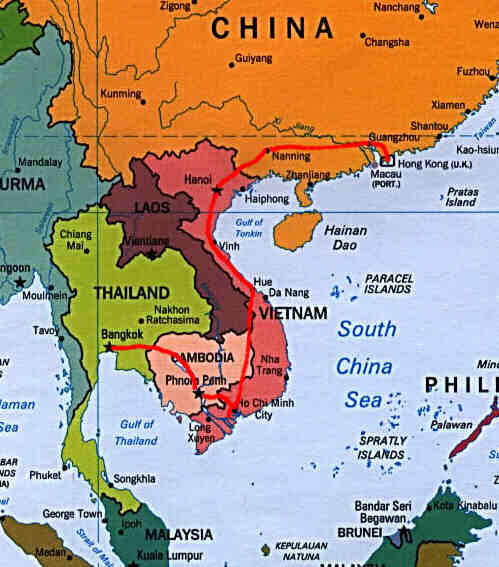
|
Hong Kong
|
Monday 25th Oct. We landed about 8pm. The big new airport is most impressive and very efficient. In no time we'd gone through the formalities, changed money, found out about hotels from the information desk and booked the 'Chungking House de luxe hotel' over the phone (it wasn't exactly de luxe but it was OK). The only snag was that Emirates Airlines had managed to break the handle on one of the cases but that too was handled efficiently and we were given the details of the authorised repair shop who would fix it for us tomorrow. We got the airport bus A21 into the centre for HK$33 (about UK£3) and it stopped right outside Chungking Mansion, a tower block full of backpacker hotels in a very central location on Nathan Road, the main shopping street of Kowloon, just a couple of blocks from the Star Ferry terminal. Chungking House hotel is an upmarket backpackers hotel on the 4th floor where we got a double room with air conditioning and bathroom for HK$320 a night.
Hong Kong does not seem to have changed since the Chinese takeover two years ago. They still drive on the left and still use the same currency, although the Queen's picture isn't on it any more. It's still very bright, bustling and commercial. We went for a stroll along Nathan Road and stopped at the Flying Elephant Portuguese Barbecue restaurant for a meal of BBQ ribs, even though it was nearly midnight. We haven't quite adjusted to the time difference yet. By the time we'd finished and walked back to the hotel, after midnight, some of the shops were starting to close.
Tues 26th. A day at leisure shopping in the electro-gadgetry paradise that is Hong Kong. We went to the railway station to book the train to Guangzhou (Canton) for HK$190 each, had a hot dog baguette for lunch in a French deli and apart from that wandered up and down the bustling shopping streets. One of the shops was doing a promotion on three snake wine - we tried some but you wouldn't want to drink it for pleasure. There was another sampler of wine made from dogs' genitals and sparrows' tails and it tasted as good as it sounds.
For dinner we went to the Banana Leaf curry house and had excellent Indian/Malay curries. For a finale we went on the Star Ferry to Hong Kong Central district and back a couple of times to see the bright lights across the harbour. The luggage people collected our bag from the hotel and returned it later all mended very efficiently. |

|
Canton (Guangzhou), China
|
Wed 27th. Back to the French deli for breakfast, then we finished packing and set out for China. We got the bus right outside the hotel to the railway station for 52p each, changed our leftover HK money into Chinese (at what turned out to be a better rate than in China) and got the express train nonstop to Canton. It was all remarkably smooth and efficient. On the train a succession of ladies with trolleys or trays came by selling food, drink, duty-frees, etc. One lady was selling glossy commemorative books of Chinese postage stamps. When I looked at one but didn't buy it she looked so sad I thought she was going to burst into tears! At Canton East, another large, modern station, we went through Chinese immigration and customs remarkably smoothly.
At this point it started getting harder - there were lots of facilities for choosing a hotel but we just wanted to get to the main Canton station to get our next train to Nanning, and this just drew a blank. We were directed to the taxi rank but none of the taxi drivers spoke English so we showed one a picture of a train and set off in some trepidation. Luckily the road signs in Canton have English subtitles and the station is well signposted so we were able to direct him and arrived without mishap for Y30 (about £3). The station, however, was sheer chaos, with no English signs and very few people who spoke English. Eventually one of the bank of hotel touts who sit outside shouting through megaphones took us through the crush to where we booked our next ticket - on the afternoon sleeper train to Nanning. Because of the cacophony, all the railway officials also speak through megaphones and continue to do so even if they are answering an individual. The noise was deafening.
All the way along I tried to explain that I needed to cash a travellers cheque first but this didn't get through until the time came to pay for the ticket, when it became clear there was a problem. After showing the travellers cheque to a few people we were directed to a bank in a hotel on the other side of the square in front of the station. After negotiating subways, steps and crossing roads to get to the hotel, the man in the bank there said (in excellent English) that we had to go to the Bank of China down the road. This turned out to be very straightforward and soon I was back at the ticket office paying for the tickets. They turned out to be cheaper than we expected and we began to doubt that they were soft sleeper, or even sleeper at all. We suddenly met some other passengers who spoke good English (they had been attending a trade fair in Canton) and they confirmed that the tickets were hard sleeper. One lady very kindly came back to the ticket desk to negotiate an upgrade for us (soft sleeper to Nanning cost Y340 for lower bunk, Y310 for an upper in a four-berth compartment) and soon, being softies, we were relaxing in the soft sleeper waiting room, a large, high-ceilinged room with sofas and armchairs round the walls. Once there, of course, things were easier - the lady who came in and announced the trains spoke very good English and she came over and told us which platform to go to. This didn't really help though, because there were no platform numbers but we followed a friendly lady passenger called Lin Dong who showed us to the right carriage. She turned out to be a celebrity - a singer on her way to do a TV show in Nanning. She was tall, slim and elegant and very fastidious - she carefully wiped down the rail with a napkin before hanging her towel up. The soft sleeper compartment was very clean, carpeted and nicely furnished. The bedding had pretty floral designs and there was a rose in a vase on the table.
We set off on time and when the restaurant car opened at 6pm we went and had a meal. The menu was only in Chinese so Sheila went to the kitchen and pointed and scored 3 out of 4 for three excellent dishes and one very peculiar pickled brown vegetable that we left most of. After a couple of cans of imported beer we retired back to the compartment and by 8pm we were snugly in our bunks jogging along through the night. |
Nanning and Pingxiang, Guangxi province, China
|
Thurs 28th. We woke up 12 hours later as the train was approaching Nanning, earlier than we had been told (but at the time that Lin, our singer companion seemed to expect). There was another train in the station that we thought might be going to Pingxiang, our next destination near the Vietnamese border, but it was going somewhere else. Lin wrote down 'Pingxiang' in Chinese for us and then we said goodbye, she went off to the TV studio to record her TV programme and we found our way to the booking office to book the next train to Pinxiang which left at 11am and took six hours. The booking office seemed very well organised with a different ticket desk for each train. Each one had a computer and, next to the keyboard, an abacus - a very Chinese combination! The tickets cost Y15 (US$2) each.
As we left the station we met a Japanese backpacker who we had spoken to in Nanning and who was also going to Vietnam. He was going on a bus which left at 9am and took four hours, so he would have time to get through the border today (it closes at 5pm). We chatted for a moment then he set off for the bus station with two Chinese friends he'd made and we stood wondering what to do for three hours, so we thought let's have a look at this bus and see what it's like, so we set off through the crowds after them, complete with all our luggage. We weren't able to catch up but one of them had yellow hair which stood out in the crowd so we were just able to re-locate them after each turning. After a ten-minute dash across Nanning we came to the bus station and found the Pingxiang bus, which was a 'sleeper' bus with two rows of double bunks each side instead of seats. Each bunk has a bamboo mat and a sort of pillow, so you can lie down to sleep but there's no room to sit up! (At least not for a moderately tall European). To the amusement of the Japanese backpacker and his friends we decided to go for it and bought tickets for Y25 (£3) each, so including the unused rail tickets the journey to Pingxiang cost $10 for both of us, still a bargain! They were hurrying us along because it was due to leave, so we scrambled on and set off into the bottom lefthand corner of China.
It was very pleasant lying on the bunks driving along and despite having had 12 hours dozing on the train, we dozed again for much of the way. We stopped halfway for a lunch stop but I took much too long deciding what to have so I'd hardly started eating when the bus was ready to go again. The Chinese are a very impatient people so I bolted down another couple of mouthfuls to the sound of much revving of engine and tooting of horn, then scrambled back on the bus. The journey actually took six hours not four, but we still arrived well before the train. As soon as the bus stopped in Pingxiang we were surrounded by 'Lambrettas' - little motorbike-powered taxis with two small bench seats under a 'covered wagon' awning at the back. The drivers immediately started negotiating the fare to the Vietnamese border post with us, knowing that's the only reason foreigners come to Pingxiang. Our Japanese companion declared that he was tired and would stay the night here and cross the border in the morning, but we decided to go for it (they can't stand the pace, these youngsters!).
We managed to end up in the most decrepit of the Lambrettas which could hardly make it up the hills and took nearly an hour over what should have been a 20-minute journey. The border was still open but only just - it was clearly the end of the working day and everyone was ready to go home. Nevertheless, they were friendly and helpful and our exit from China was very easy. There are no currency changing facilities but you need to have Y10 each for a sort of 'departure tax' that appears official - there was a big notice about it in English and Chinese. |
Hanoi, Vietnam
|
We had heard that Vietnamese border officials could be difficult but in the event they too were friendly and entry into Vietnam was equally painless (even though they too were clearly ready to go home and kept looking at their watches!). There were no official currency changing facilities here either but we were approached in the doorway by a man offering to change Chinese money to 'dong', the Vietnamese currency. Uncertain of the exchange rate we consulted the border guards, and although they started off refusing to let the man in because the transaction was obviously semi-illegal, they ended up negotiating with him for us and got a better rate! They also arranged for a 'friend' of theirs to take us to the nearest town, about half an hour away, where we could get a bus or train to Hanoi, for US$10. There was no other transport apparently available so we accepted this deal and the man also agreed to find us a minibus to Hanoi (a four-hour ride) for Y100 Chinese each (UK£10). No doubt these prices are way higher than the locals pay but it was friendly, quick and easy and everybody was happy with the deal. The only mind-boggling bit is that I now have three currencies in my pocket which can all be used here - US$, Chinese yuan and Vietnamese dong, and four in my head because I'm still trying to convert each transaction into UK£ with great difficulty! It doesn't help that there are more than 20,000 (twenty thousand) dong to the pound (14,000 to the US$) so the numbers are mind-bogglingly large and it's very easy to be out by a factor of ten when you're calculating prices.
The minibus approached Hanoi across the bridge over the Red river and started dropping people and packages off in various streets (it obviously operated as a mail service as well as carrying passengers). Finally we stopped in a little back street, in a tropical downpour and the driver announced 'this is Hanoi' expecting us to get off. We had decided to try the hotel 30/4 opposite the railway station (named after 30th April, the date of the fall of Saigon) which the book described as run down but having character. We started saying 'railway station' and making train noises to the driver and it wasn't clear if he understood but we set off again and in a couple of minutes saw both the station and the hotel opposite. We parted with smiles and waves from the driver and went into the hotel where we found they had one room left, with no ensuite bathroom but at only US$7 it was fine. The hotel was clean and charming, built around a small central courtyard with plants in pots and topiary bushes shaped like deer. The bathroom was across the courtyard but it too was clean. |
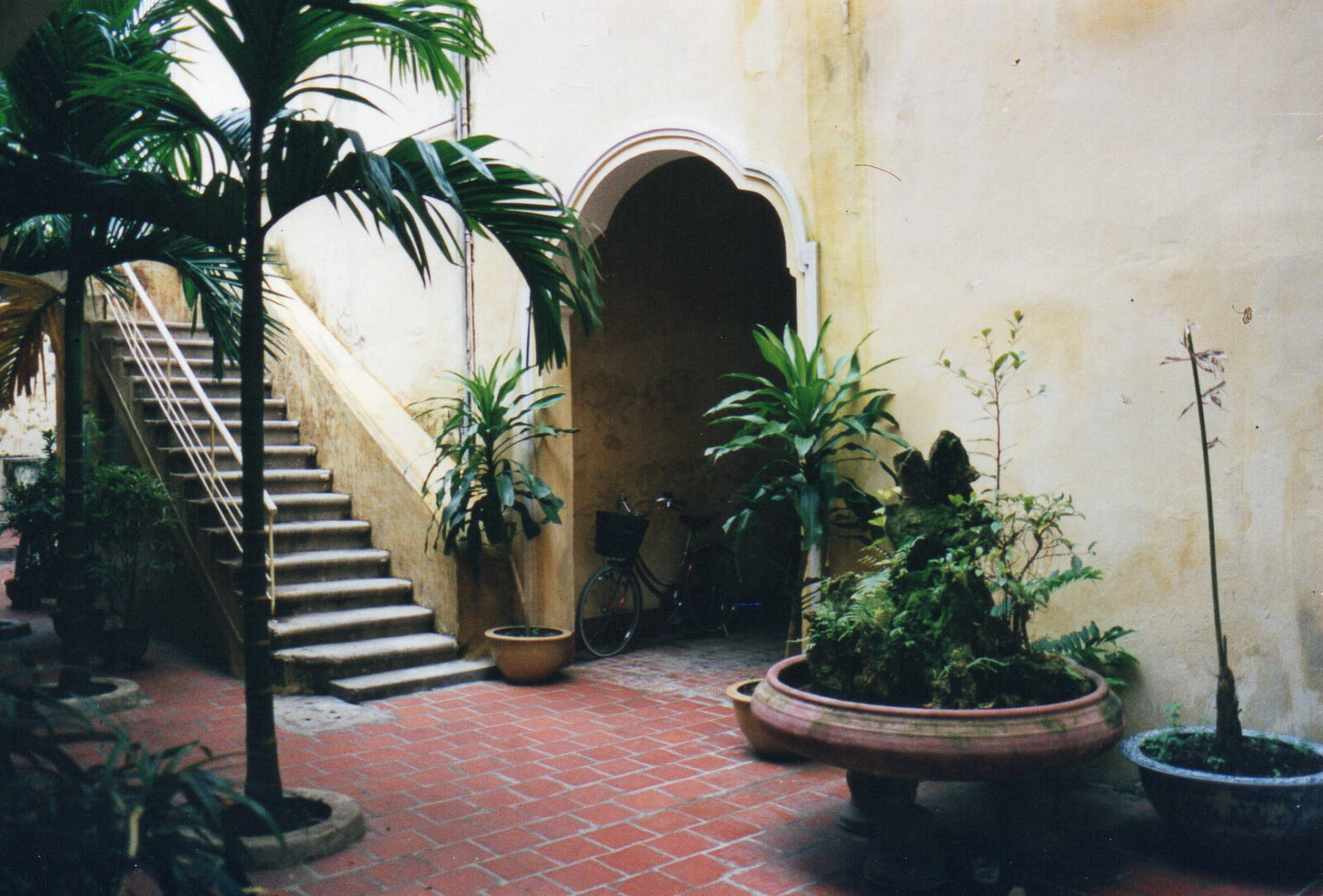
|
It was now about 10pm and Hanoi looked rather closed, but we went down the road and had a plate of noodles at a little street stall where the owner's daughter sat with us in her pyjamas eating a chicken's foot, after first spitting out its claws. Sheila somehow lost her appetite.
So without pausing for breath we have come a thousand kilometres across three countries since yesterday morning, travelling by train, sleeper train, sleeper bus (!), taxi, minibus and motorbike. And all the way everything was remarkably smooth and efficient and everyone was friendly and helpful. So why bother, you might wonder, to come such a roundabout way, when we could probably have flown straight to Hanoi? Well, it's all part of the fun and we wanted to have a quick look at China - I didn't think it would be quite so quick! Also it's part of the game we play, drawing 'lines' on the map of the world. At some future time we will probably come back and see more of China, maybe even get the Trans-Siberian express all the way from London and end up in Hong Kong, but we're unlikely to have another reason or opportunity to 'join up' China and Vietnam again.
[p.s. in 2004 we came back and saw much more of China, going overland from Beijing to Bangkok, then in 2005 we did get the Trans-Siberian express to Beijing to 'join it all up'. You can click the link at the bottom of the page to read about these travels.]
Fri 29th. We went sightseeing in Hanoi. First, though, we walked down to the Cambodian embassy, just down the road from our hotel, to enquire about visas. Because they only work on Monday, Wednesday, Thursday and Friday and it takes three days we would not be able to collect them until the middle of next week. However, they assured us that the consulate in Saigon (Ho Chi Minh city) opens Monday to Saturday and it only takes one day, so we decided to risk it and wait till we get to Saigon. Outside the embassy we flagged down a cyclo (a sort of cycle rickshaw with the driver on a bike at the back and us in a sort of armchair just wide enough for two on the front) and went across town to the old quarter, which is a fascinating maze of small shopping streets where the goods from the shops, parked bikes and people eating their lunch completely block the pavement so you have to walk along the road while the bikes, motorbikes and cyclos weave their way around you. This is a mobile flower shop on a bike. |
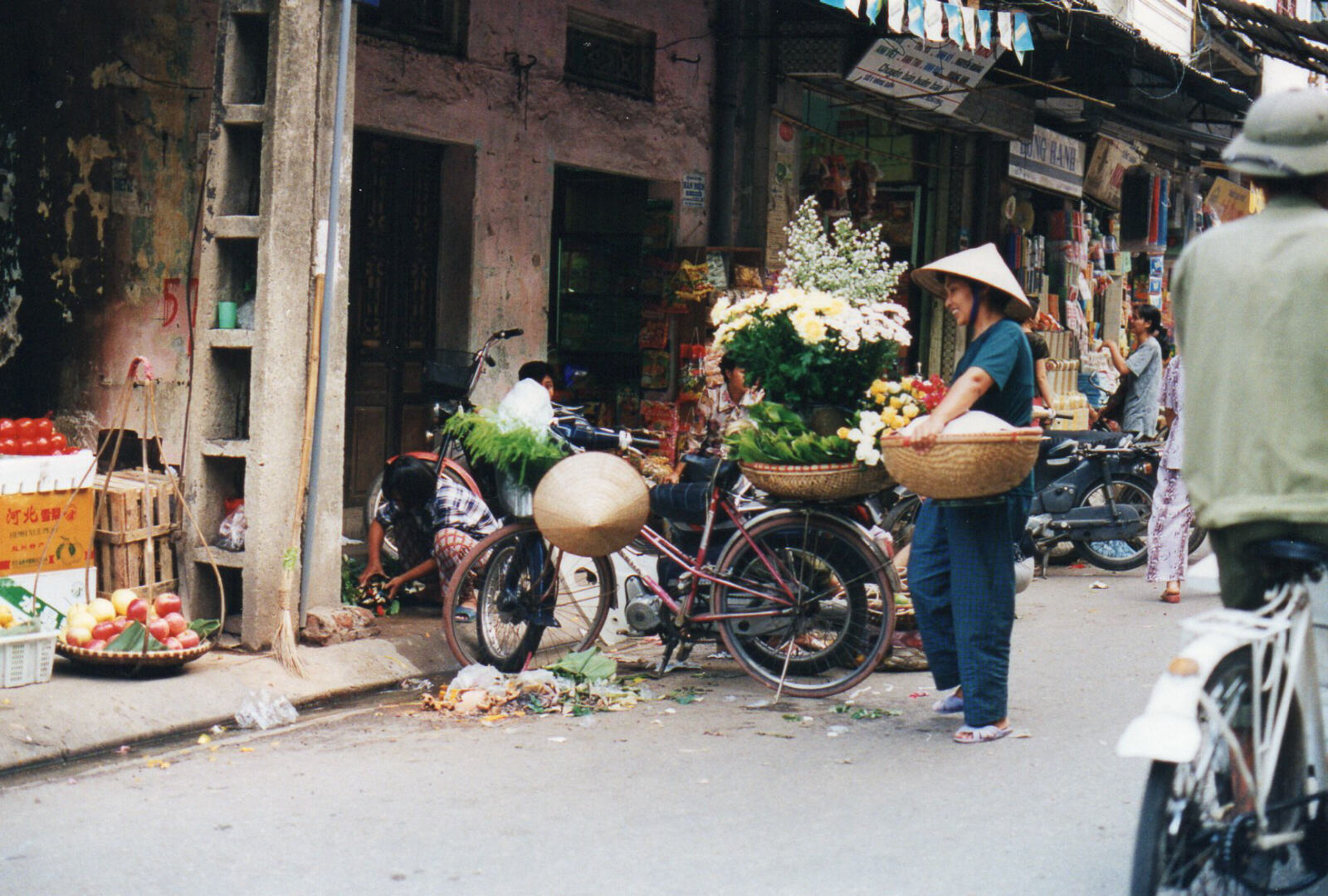
|
Road junctions are absolutely incredible - there are no road markings or priorities, everyone just looks straight ahead and goes where they are going and somehow they all get there without quite occupying the same space at the same time. In one or two places there are traffic lights and these periodically release tidal waves of bikes and motorbikes which surge down the road, and if you are in a cyclo in a minority stream of traffic crossing the road it can be quite daunting (for us, the passengers, apparently not for the driver).
We went to Hang Bac street which has become the travellers' café street of the old quarter. Here there are dozens of cafés which also double as travel agents, offering tours to all the scenic spots in the North, with photos and testimonials from satisfied previous travellers all along the walls. They also all offer internet access and half the space in the tiny cafés is taken up with PC workstations. Eight years ago when my edition of the Lonely Planet guide book was written, none of this existed and now Hanoi is becoming a real backpacker destination with an atmosphere in the old quarter rather like Kathmandu - relaxed, easygoing, colourful with facilities like pizza houses and even a couple of 'pubs' if you really need them! After breakfast we walked down to the Hoan Kiem lake which sits in the middle of the city of Hanoi between the old quarter and the newer side where the big public buildings and expensive hotels are. We crossed the picturesque wooden Huc Bridge to the even more picturesque little Ngoc Son temple that sits on an island in the lake, a haven of peace and tranquillity in the middle of the busy city. |
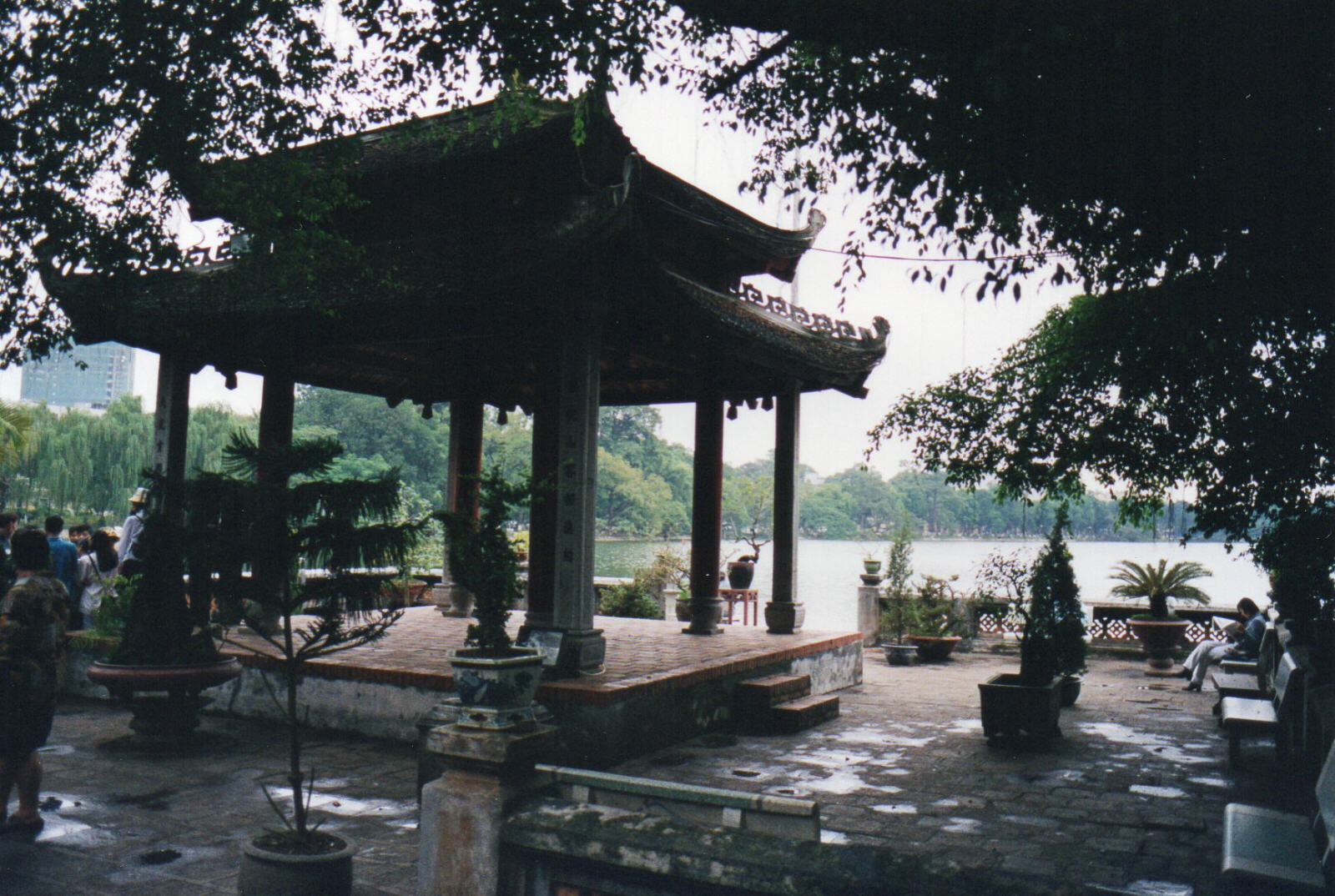
|
It had topiary in many shapes including what appears to be a teapot.
|
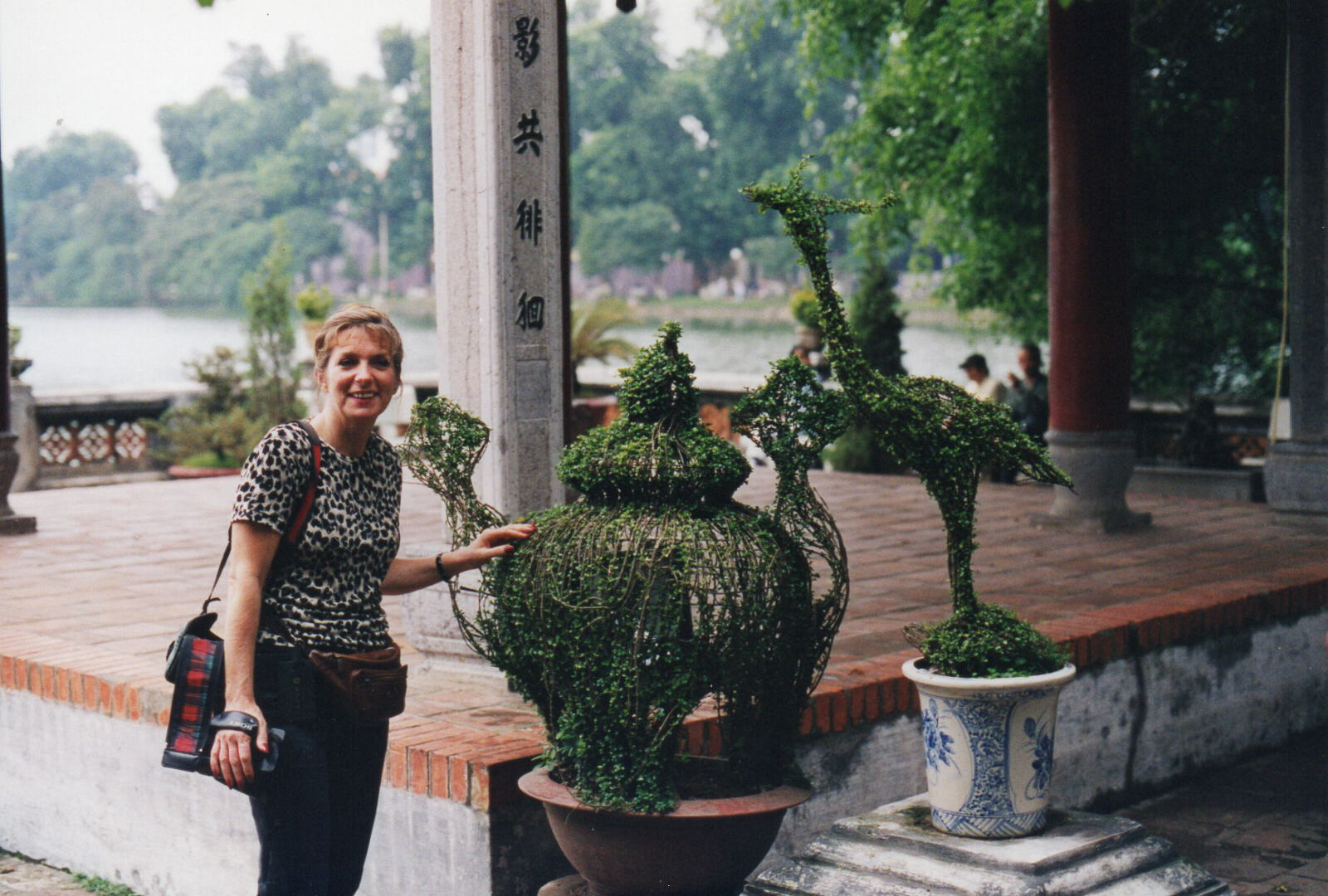
|
When we crossed back to the shore the cyclo driver was still waiting for us; when a foreigner goes for a ride in a cyclo the driver attaches himself to you, knowing that eventually you will give in to his demands to take you for a one-hour tour of the city. We negotiated a price of D20,000 (£1) for the hour, which was probably a good deal for both of us, being way higher than the local price but a bargain for us. It was a great way to see the city, proceeding at just over walking pace in the comfort of our chair, as long as you are not a nervous passenger (see earlier remarks about the traffic!). We went all round the old quarter then into the newer part of town to see the restored Opera House and adjacent Hilton hotel, which are both very impressive. This is the real Hilton, not the 'Hanoi Hilton', the prison that was used to house captured American servicemen, which is not far from our hotel but we haven't seen it yet. Then we cycled up to the big covered market to the North of the old quarter and our hour's tour ended.
We had considerable difficulty persuading him that we were going to walk from here but we did, through the market (which was not as interesting as the streets in the old quarter) and across to the banks of the Red river, the big river that runs beside Hanoi. Here we saw, and in fact climbed up onto Long Bien bridge, a huge 'Meccano kit' of girders and wooden planks that the Vietnamese kept patching up however often the Americans bombed it. At one time it was guarded by 300 anti-aircraft guns and 84 SAM missiles but there's not much sign of that now. Road traffic now goes across a new bridge downstream and Long Bien is just used by trains and a constant stream of bicycles. While we were standing on it a train rattled its way across and it seemed as though the vibration would demolish the bridge more effectively than the Americans were able to do! |
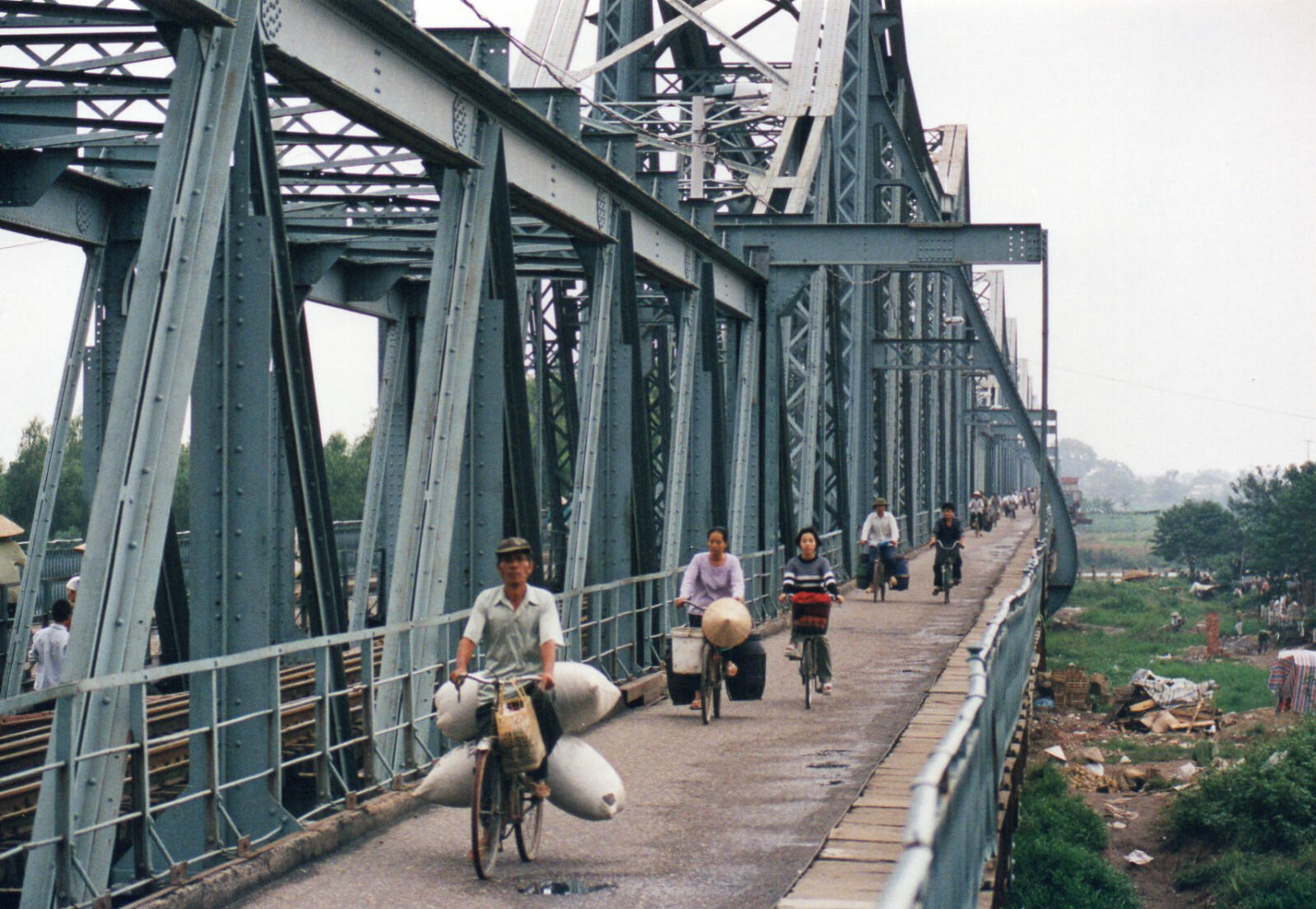
|
We walked back to the old quarter and had lunch in another travellers' café, then looked around some more. We found another recent innovation, a little music shop selling modern pop CDs for £1 each. We didn't enquire too closely into their provenance. We had another one-hour cyclo tour with a different driver and as dusk fell ended up at Al Fresco, a wonderful pizzeria run by a jovial Australian called Jacko who has lived in Hanoi for some time - when he came there were no motorbikes or other vehicles, the only way to get around was by pushbike. Our cyclo driver had waited for us of course, so we had another hour's tour of 'Hanoi by night' ending up at our hotel. The only problem is that both cyclo drivers will be waiting for us tomorrow morning - could be an ugly scene!
Sat 30th. In the event we had a long lie in and by the time we emerged they must have got fed up and gone away. While Sheila had even more lie in I went for breakfast at the Hoa Sua, a lovely open-air restaurant which is also an aid project - a training school for orphans and street children which has already produced over 300 professional chefs. A journalist and photographer were doing a feature on the project for an American magazine called 'People'. While the journalist interviewed the lady who runs it, the photographer was arranging the tables, the plates of food and the staff and taking a series of pictures. On the way back I walked past the 'Hanoi Hilton' prison. There were postcard sellers outside the gate and part of the site has been demolished and is occupied by a gleaming multi-storey office building so it doesn't seem so grim as its reputation suggests.
We took the easy option and spent the rest of the day sightseeing on a cyclo round the city for £1 an hour. We went to the Temple of Literature, a Buddhist temple and university that was founded in the year 1070 and which has the names of the graduates carved on stone slabs standing on stone tortoises. |
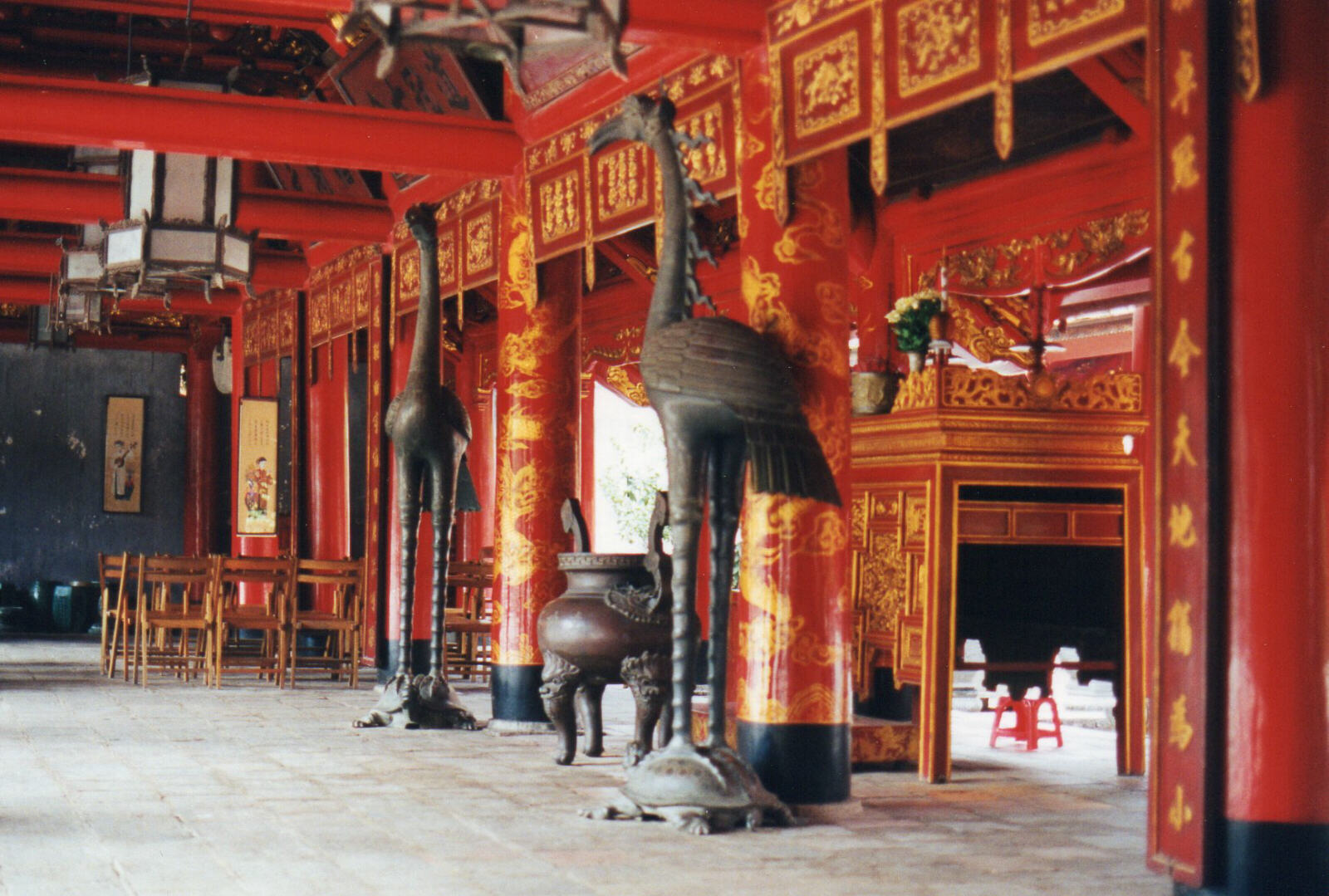
|
We went on to the One-Pillar pagoda, a delightful little temple perched on a tree and approached up a flight of steps. The adjacent museum and mausoleum of Ho Chi Minh was closed 'for renovations' - apparently Ho's embalmed corpse is sent to Moscow each year for maintenance. We cycled round the city, past the lake and to the old quarter where we went up and down the bustling little streets again and through the old East Gate (Cua O Quan Chuong) in the city wall.
|
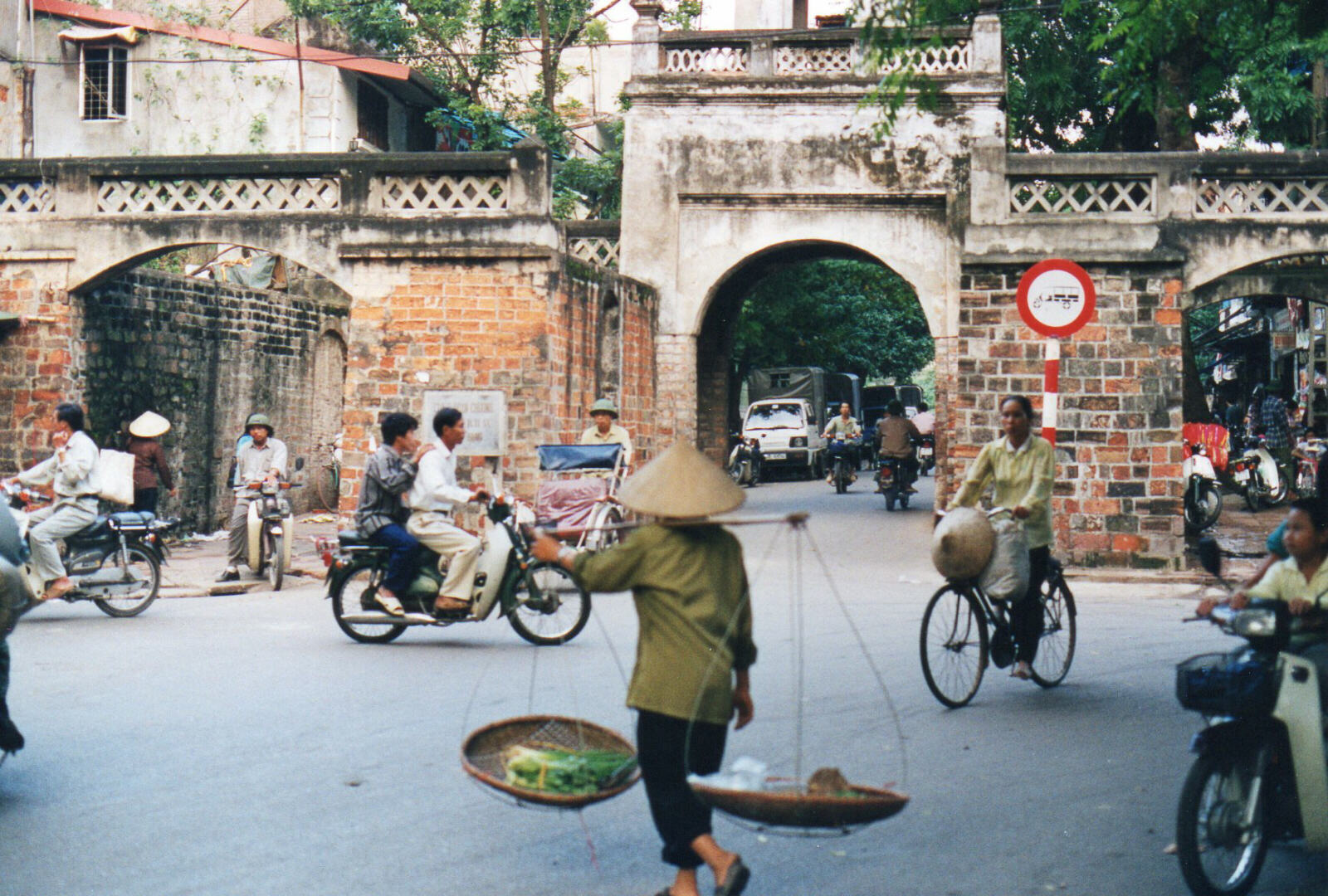
|
The train from Hanoi to Hué
|
Hanoi is a delightful city but it's time to move on and when we got back to the hotel we went across the road to the railway station to book the train to Hué, the former capital of Vietnam in the narrow bit in the middle. Booking the train was very easy - there is a separate window for foreigners where they have a laminated card with times and prices for the main Hanoi-Hué-Saigon line. There are no first and second classes in this egalitarian society of course, but there is soft seat and hard seat (and soft sleeper and hard sleeper if you're going all the way to Saigon). The 680-km journey to Hué now takes 12 hours - it was 23 hours when my guide book was written, so they are making rapid improvements to the infrastructure. We booked soft seat on the 8am train for 455,000 dong (£23) each. I was a multi-millionaire (in dong, anyway) before I bought the tickets - oh well, easy come, easy go.
Sun 31st. We packed, checked out, crossed the road and boarded the train by 7:30am. Our tickets had the coach and seat numbers so it was very easy. We had booked the daytime train because the journey goes through some spectacular scenery. Unfortunately the windows were rather dirty and protected by a metal grille on the outside so this rather restricted the photographic possibilities.
There was no restaurant car so Sheila nipped back onto the platform and bought a loaf of crusty bread and some cheese and as soon as we started (right on time) a man with a trolley came round selling thick black coffee and various snacks. We were soon out of Hanoi into the Vietnamese countryside where people in conical hats were labouring in the paddy fields. It was very comfortable travelling along on the train although it turned rather misty and drizzly outside so we could see even less. At about 11 o'clock they brought round a packed lunch which was tasty - hot meat, two veg and rice in separate little containers and a bottle of water. After we stopped in Vinh, a town about halfway to Hué, the flat rice paddies that had been continuous since Hanoi gave way to hillier country with much less cultivation, and by 3pm we were weaving through hills and mountains densely covered with trees. At 5pm they brought round packed dinners, very similar to lunch with slightly different dishes in the little boxes. |
Hué, Vietnam - the great flood
|
About 8pm we pulled into Hué and as we left the station the man from the hotel was there to greet us with our names on a sign board! What had happened was, while we were waiting in Hanoi station a young lad came round all the foreigners on the train promoting his hotel in Hué - he showed us photos, told us the room prices (from $10 to $25) and promised we only had to look, there was no obligation - he even wrote this down on a hotel card word for word! So we said OK we'd look, so there was the hotel minibus waiting for us and five others when we arrived, all most enterprising and efficient. The hotel, the Thai Binh, was very clean and attractive and there are communal balconies on each floor where you have breakfast in the morning (included in the price). The catch turned out to be that all the $10 and $15 rooms were full (the hotel did look pretty full in fact) so we ended up in a spotless $20 room with a/c, fridge and ensuite bathroom which was still very good. We negotiated that it would be $18 on the second and subsequent nights (still including breakfast) and felt happy with the deal.
Mon 1st November. The inclusive breakfast is as much as you want from the breakfast menu so we made a hearty selection and sat on the balcony in the cool breeze. Here it is noticeably warmer and more humid than Hanoi, which was pleasantly warm till the sun came out when it got quite hot. Having sampled most other forms of transport we booked a day's motorbike tour of Hué with Minh and Thu, who live in a house near the hotel and who are pretty good at catching tourists as they go by! The royal tombs and other sights are spread out several km around Hué so it seemed logical to travel there like the locals do. Perched on the back of a motorbike each we set off and it began to pour with rain. Undaunted our drivers produced four poncho-style raincoats which we all put on and continued through torrential downpours for the rest of the day. We got completely soaked and it reduced the photo possibilities significantly but it was still a great tour. We went to two pagoda/temples, arriving at the Tu Hieu pagoda in the middle of a service where the saffron-robed monks were chanting, ringing bells and beating drums. |
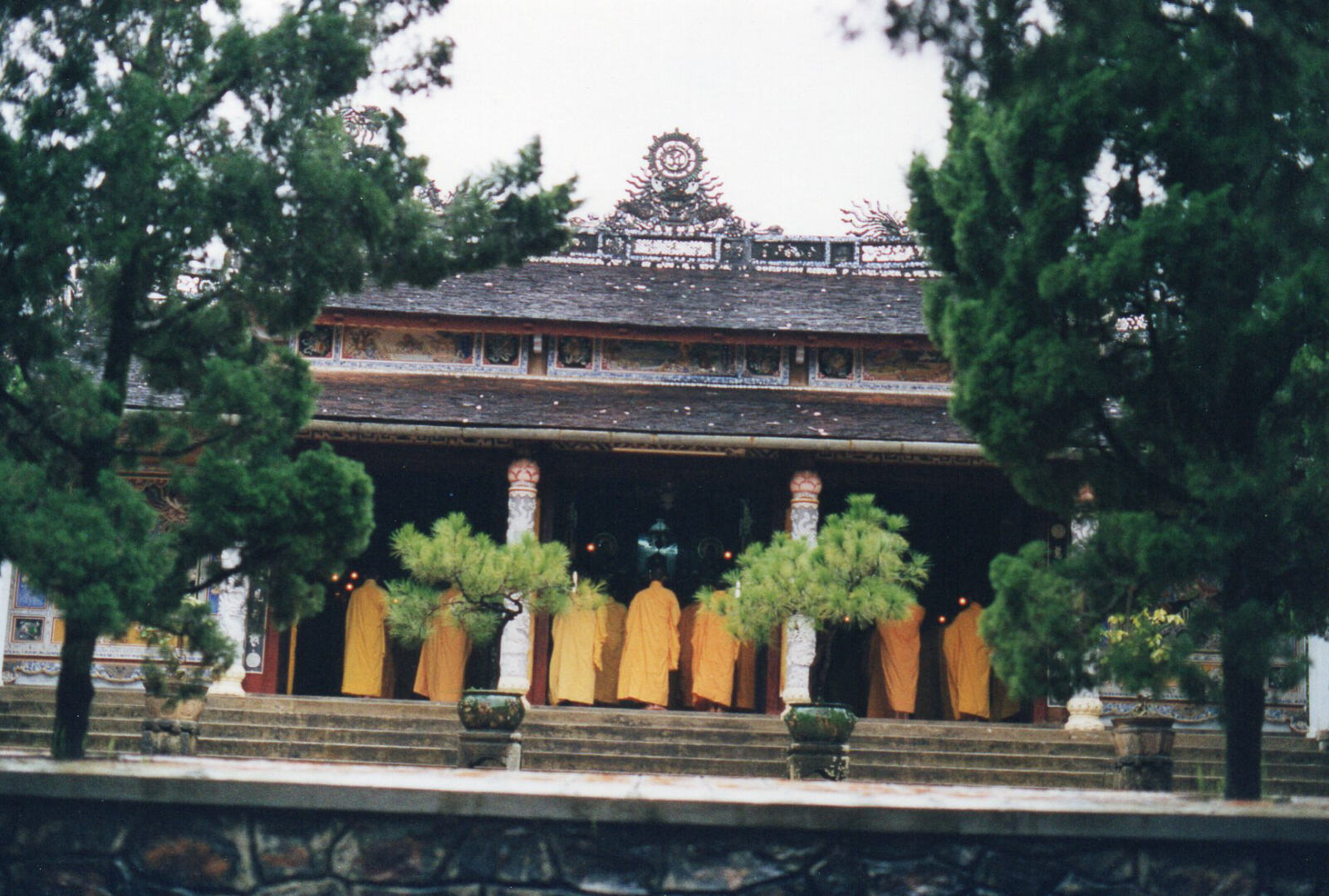
|
Afterwards one of them who spoke English invited us in and showed us round. Out at the back there was a courtyard full of pots with bonsai trees and other plants. The rain had stopped temporarily and the water dripping off the leaves into pools on the ground made a tinkling musical sound.
We went to two of the royal tombs, the largest of which (for the emperor Tu Duc) encompassed a park with a lake and wooden pavilions, several ornate wooden buildings, a temple, a courtyard with stone mandarins, horses and elephants guarding it, a building with a huge stone slab inscribed with the emperor's achievements (composed by himself during his lifetime) and finally the tomb itself which was a surprisingly plain stone cube in a brick courtyard, after all the decoration that led up to it. |
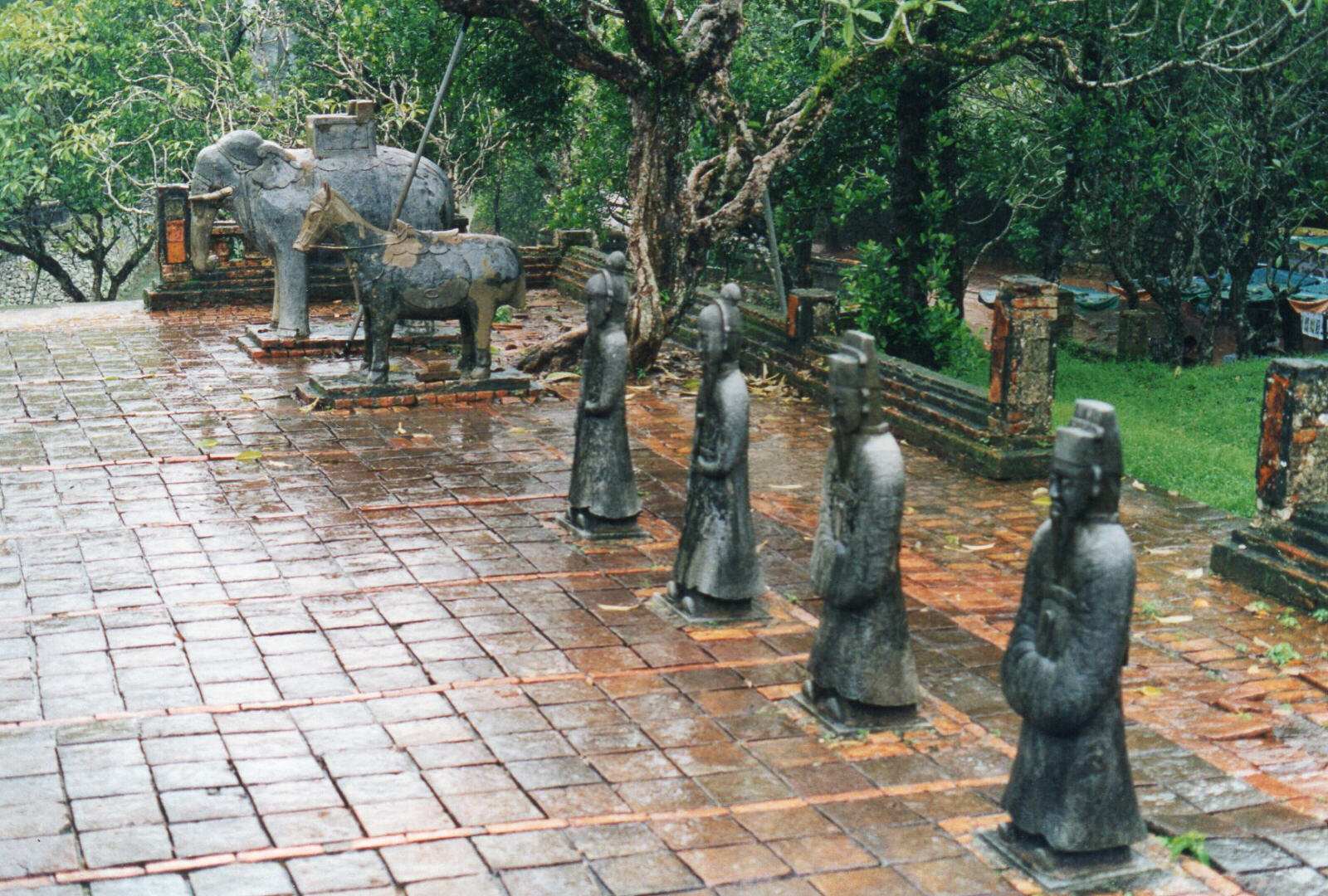
|
We also drove around through the countryside which seemed to be mainly water; rice paddies, rivers and canals with people ploughing using water buffalo, fishing using nets hung out on long bamboo poles and a lady catching herons by enticing them onto her boat with food. When we got back Sheila went to a shop with one of the motorbike drivers and got two of the poncho-style raincoats for 50p each! We returned to the hotel after a really good day, soaked to the skin and really appreciated the luxury of hot water and a bath. The downpour continued so we went to the nearest restaurant which was an Indian at the corner of the little alleyway where the hotel was. For 119,000 dong (£6) we had excellent curries and a couple of Tiger beers. By the time we got back to the hotel the tropical downpour had developed into a thunderstorm that literally rattled the windows.
Tues 2nd. It rained heavily all night and it was still raining heavily in the morning. As we started to go downstairs we realised just how hard it had been raining - there was an unusual hubbub of activity and we found the whole ground floor of the hotel was flooded waist-deep in yellow-brown water. Outside the street was shoulder-deep, as we could tell from the people trying to wade down the road, some of them still holding umbrellas against the rain. The small shanty houses further down the street were flooded almost to the tops of their doorways. We went to the top floor and from there could see buses and cyclos abandoned like islands in the main street which was flowing like a river. It slowly dawned on us, because Hué and the surrounding countryside is dead flat, how widespread this flood really was. This was clearly no ordinary downpour and someone said it was the worst flood for 25 years. The newspapers subsequently said the worst for a hundred years. The electricity had gone off some time ago and now the water went off as well. Oddly, the phone in our room kept ringing with a peculiar warble as something shorted out somewhere.
We sat on the communal balcony talking to some of the other guests until hotel staff started laying out mattresses and making up beds there for the guests who had been flooded out of the ground floor. The first room on the ground floor was room 101! We were preparing for a long stay and counting our rations - two Mars bars, three bottles of water and two bottles of airline wine, when there was a knock at the door and one of the staff handed us two sandwiches for breakfast - we were very touched that with so many other problems they had time to think of that. A few minutes later there was another knock and they gave us the laundry we handed in yesterday, beautifully cleaned and pressed! How did they manage that?
By 10am the rain was still pouring down, the wind howling, the thunder rumbling and the sky was so dark it was hard to read a book right by a window. We settled down to wait. We read books and the water level in the street outside continued to rise over the shoulders of the occasional foolhardy individual who waded past. The next person by was actually swimming down the street. At midday the hotel proprietors set up an improvised rice kitchen on the first floor landing/balcony and handed out plates of rice and egg to the assembled guests. One of the staff apologised but said he couldn't get down to the market to buy anything else! The staff in the Thai Binh hotel were absolutely marvellous in this crisis. Much later we spoke to people who had been staying in a much posher hotel down by the river - the staff in their hotel not only failed to warn them of the rising flood, so that they woke up in the middle of the night to find their belongings floating round the room, but didn't feed them and also raised the room price because they had no way of getting away!
The rain continued all afternoon but the yellow-brown flood level remained constant, not quite reaching the windows of the bus marooned in the main road. The Vietnamese are amazingly resourceful and industrious; we were resigned to having no light or power until the water had receded from the ground floor but we saw people moving around on the flat roof of the building next to the hotel and heard what sounded like a generator - a moment later the lights came on! Apparently four hotel staff had swum and dived somewhere and raised the hotel generator up to a higher level, fixed it up, cut the wires to the ground floor so it didn't short out and restored power so our hotel was the only blaze of light amidst the darkened city. As night fell the typhoon renewed its vigour and the flood level stayed constant. Sheila listened to her new CD player (purchased in Hong Kong) and planned what to do the next day - she decided to paint her nails.
One of the hotel staff swam off somewhere and acquired a scrawny (live) chicken while another went diving (literally) to the ground floor to retrieve dozens of bottles of beer and we all had piping hot chicken and rice with flood-cooled beer for dinner on the second floor landing. We then joined a card game round the table on the landing until the staff started laying out their mattresses there and we retired to let them sleep. There were already two improvised mattress beds there and two on the top floor for guests flooded out of the ground floor so we were lucky to still have our room to ourselves, even though the wind had shifted and water was now coming in one of our windows and spreading over the floor rather alarmingly.
Wed 3rd. No change. The typhoon continued to blow, the rain fell, the flood level stayed constant and the water continued to spread over our floor despite Sheila mopping it up from time to time.
Thurs 4th. The typhoon seems to have blown itself out. There is just intermittent 'normal' rain this morning, the flood level is well down and our floor is dry. People are discussing their escape plans but it appears that it will be some days before the roads are open again. Someone waded down to the airline office but it was shut. There was great activity outside as people were sweeping the water and muck out of their homes and putting their possessions out to dry. About midmorning we went wading out to the end of the street and up to the main road which was partly clear of water and full of cyclists - a cyclo driver even stopped and asked if we wanted a tour - things are getting back to normal! |
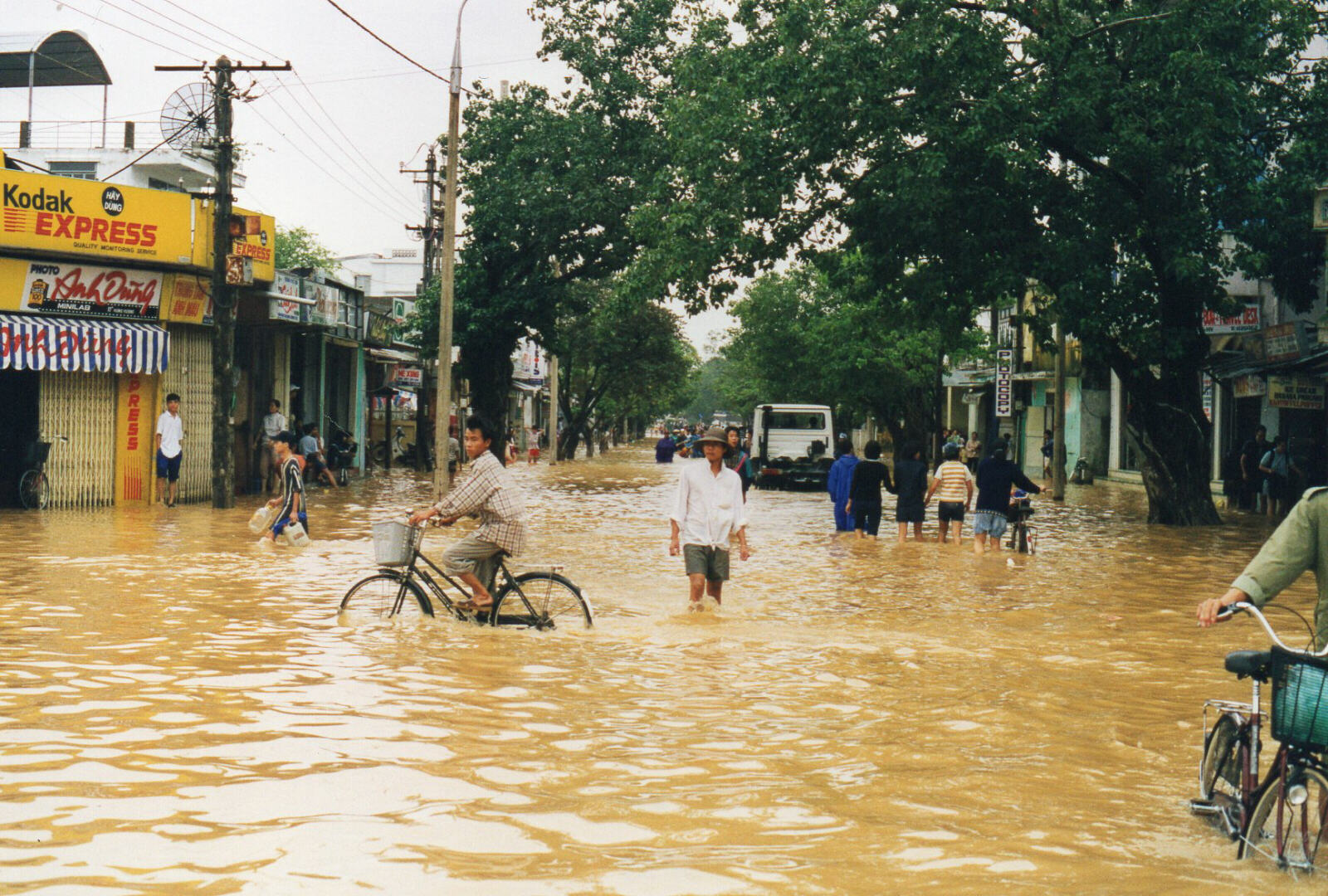
|
We spoke to Thu, the lady at the motorbike hire shop. She couldn't swim but had gone to stay with friends who lived in a flat somewhere. Her single storey house and shop had been flooded almost to the top of the doorframe but apart from one pushbike which had been swept away she had not lost anything. There was still no electricity anywhere that did not have its own generator. Back at the hotel we were eating another lunch of chicken noodles when one of the guests came back and said that the cafés along one particular street had reopened and he had had banana pancakes and real coffee! We decided that we couldn't face any more noodles and that afternoon we would do the same. About three o'clock we put on our poncho-style raincoats (because, surprise, surprise, it was still raining) and waded off to explore. We went down to the river and across one of the main bridges, which seemed to be just inches above the rushing water of the Perfume River, which still completely covered the riverside gardens. We went into the Citadel through Ngau Gate and past the nine holy cannons, which were still liberally draped with water hyacinth left there by the flood. However, when we got to the main entrance to the Imperial Enclosure, within which is the Forbidden Purple City (the Emperor's personal palace) the gatekeepers wouldn't let us in and it wasn't clear if this was because the palace was closed for the day or still flooded. We waded back to the hotel, enquiring at each café if they did banana pancakes but none did. That evening we played cards with the other guests on the landing and retired late, exhausted from our unaccustomed exertions.
Fri 5th. There were birds singing outside for the first time this morning, but a light drizzle was still falling and the street was still ankle-deep in water and sludge. The news is not good, however - apparently there is another typhoon on the way and there will be no plane or bus out for a couple more days. We walked down to the big Century Riverside hotel by the river where there were rumours of flights to Hanoi and people leaving mysteriously on buses, possibly for the airport, but no taxi would take us to the airport, saying that the road was too flooded and there was no firm information about anything. We met Maria and Tracy, Americans from our hotel and Peter and Lyn, Australians who had come to Hué on the same train as us but moved to a small guest house near the river where they were luckily on the second floor and were being well looked after. We learned more about what was going on - there were at least two trains and lots of buses that had been stuck where they were since the typhoon struck, with water up to the windows, which made us realise how comfortable we had been.
We walked back to the group of travellers' cafés in Hung Vuong street which were the only ones in the city serving hot food and had banana pancakes, chips and coffee! The places were packed, mostly with foreigners, but there was no attempt at profiteering either here or in the little hole-in-the-wall shop near our hotel that sold Pringles crisps, among other delicacies. Several groups of children came and hung around us at the café, half selling us postcards, half playing with us, each group minded by the adult with the fresh postcard supplies should anyone be lucky enough to sell some. |
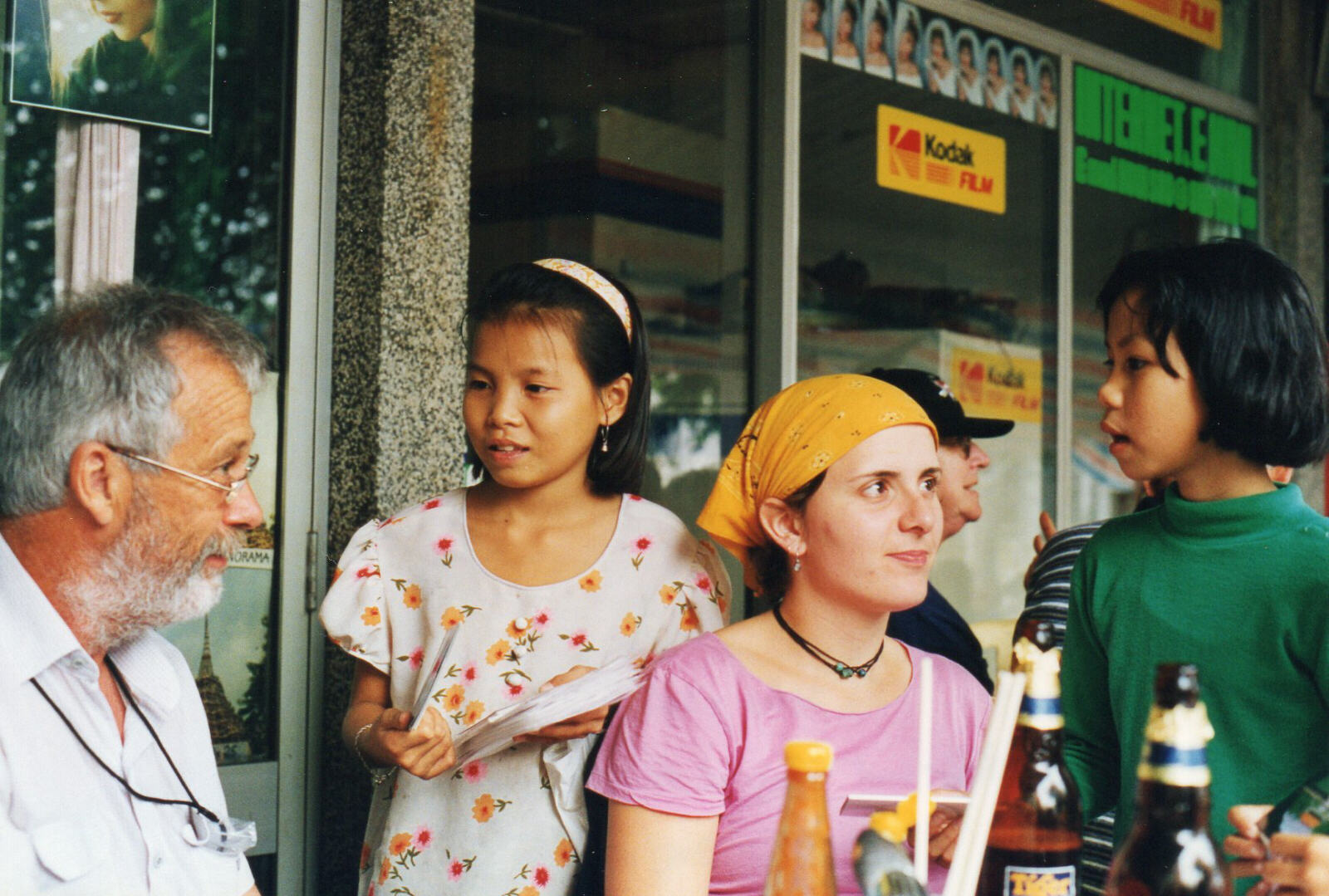
|
That evening fourteen of us sat around the table on the second floor balcony and discussed our escape plan. We had just decided to somehow get to the main highway in the morning and hitch a lift on a lorry to Da Nang, where we believed the airport was open (Hué airport was complete chaos) when we found there was a news bulletin (in Vietnamese) on TV and all went to watch it. We couldn't understand a word but the pictures were clear enough - Da Nang was flooded as badly as Hué and the road between the two was impassable. Later on there were pictures of a railway tunnel almost full of mud, and railway tracks hanging in mid-air where the embankment had been. We decided to stay put for another day and see what developed. Outside in the street the water level had dropped and they were sweeping away the mud but as we went to bed we could hear it was raining again.
Sat 6th. That night the second typhoon hit. The wind violently rattled and crashed pieces of the hotel and more rain came bucketing down. However, by the time we emerged at 10am the transformation was startling - the sky was blue and the sun shining. Hué suddenly looked much better, despite the mud and debris in the streets. We walked down to the Vietnam Airlines office to see about a flight to Saigon because the road and rail south were both badly damaged and would not be passable for some time, but they were just starting to sweep the mud out of the office and would not be opening today.
We went for fried eggs at the travellers' café with Maria, Tracy, Peter and Lyn and we and Maria and Tracy decided to hire bicycles to do an improvised tour of Hué. It's a wonderful way to see the city and we enjoyed cycling around in the sunshine. |
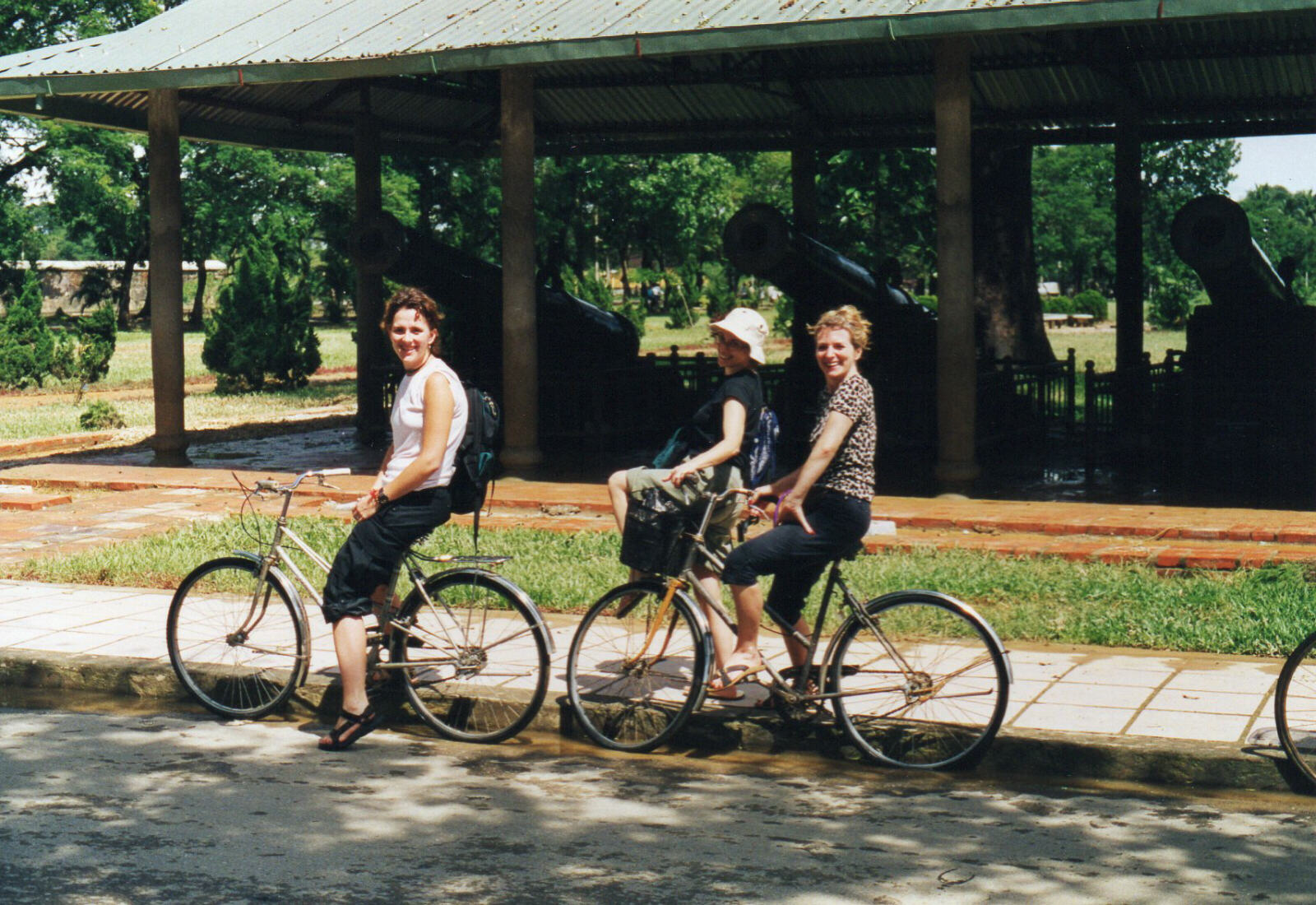
|
We went across the bridge and to the citadel, having to cycle through roads axle-deep in water in a couple of places, and although we managed to have a peep through the Imperial Enclosure doors it was still very flooded. |
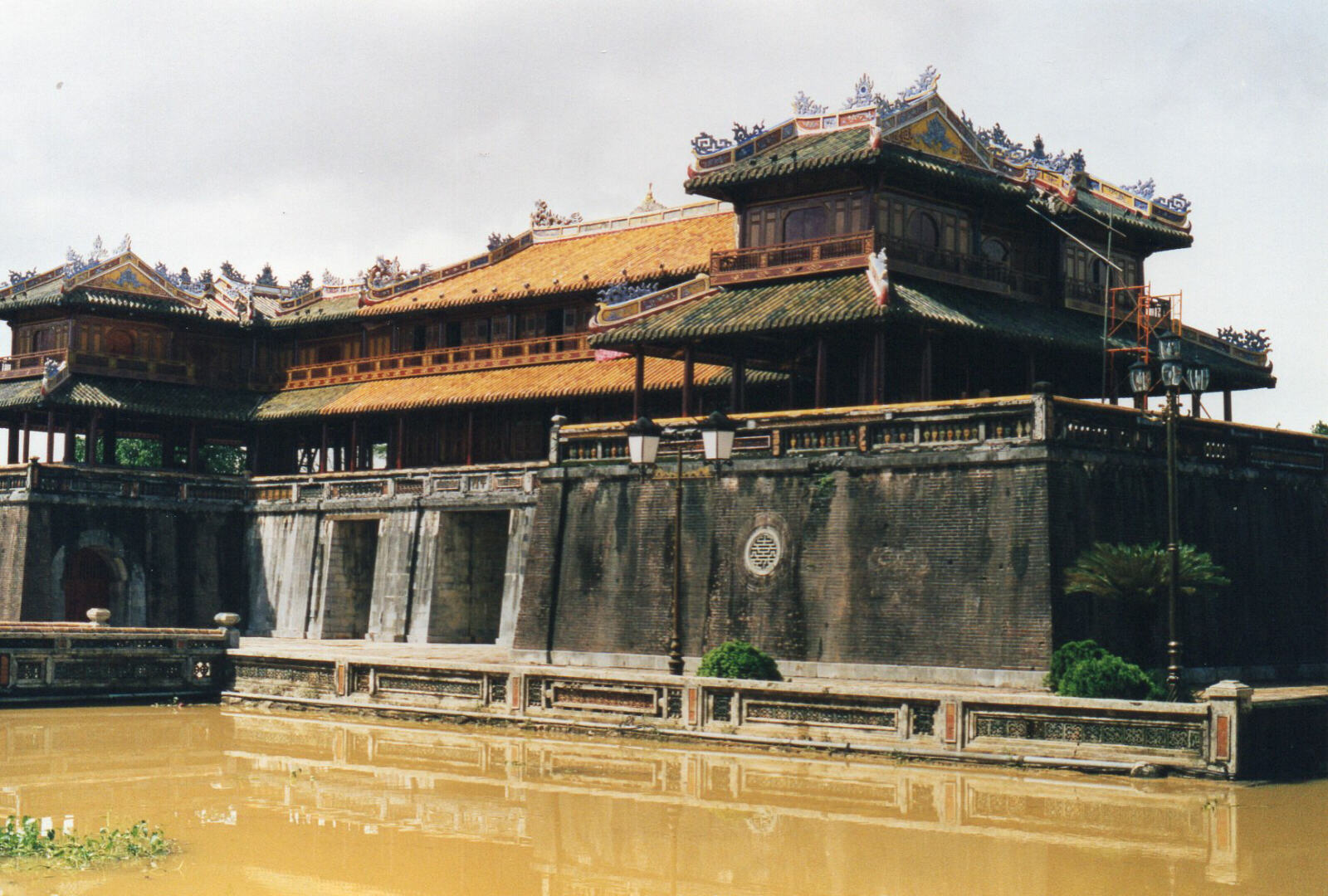
|
We tried to cycle to the seven-storey Thien Mu pagoda but people coming the other way convinced us that the water was chest-deep further on so we turned back and cycled down the other side of the river to the railway station. There, too, rumours abounded but no firm information, but it seemed that it would be weeks rather than days before the trains were running south. We heard that a carriage of one train had actually been washed away by the flood - horrific, and it could have been us if we had been a day later. As we cycled back up the road they were hauling bodies out of the river and putting them in coffins which dampened our mood even further.
We decided to go out to the airport just to see what was happening. We negotiated $15 for the four of us to go there and back with a wait while we looked round. The drive out to the airport still involved fording a couple of places where the road was flooded but nothing the taxi couldn't handle. The railway line ran parallel with the road and we saw two graphic examples of why the trains weren't running, where bridges had been swept away leaving the tracks hanging in midair. There were lots of people at the airport, mostly westerners, in two rather uncertain queues and a list of five flights to Saigon and Hanoi for that afternoon, but no clear information on what would happen when. Outside the terminal building were several tour buses and at an invisible signal all the people got off one of them and went straight into the departure lounge, obviously taking priority over normal travellers. We decided to come back and do battle with this for real tomorrow and we went back to the town and to the café for dinner. That evening we sat round the table and discussed our plans in the nearly deserted hotel. It appears that many people have managed to get away or are camping out at the airport for the night.
That morning as we were departing for our cycle ride the hotel manager had been sitting in reception with the cover off his computer, drying it out with a hair dryer. That evening when we went to settle up he produced our bill from the same computer.
Sun 7th. We knew it would take all day to get on a flight to Saigon and it did, although it wasn't as chaotic as it could have been. Vietnam Airlines were doing their best because they opened their office on Sunday as promised, having swept the mud out, but the computers weren't working so all they could do at first was to take a list of names of the 30-odd people who were there, mostly westerners, mostly people we recognised from the hotel or café. We all hung around for a while then the rumour flew round that tickets were on their way from the airport - some said they were already written out, others that they were blanks. Sure enough tickets did arrive (blanks) and the man behind the counter started writing them out from the list of names. When the first person got his he waved it in the air and there was a cheer from the crowd! It was a very slow process because he couldn't make out the foreign (to him) names, so you had to be there when your turn came, to spell it out, and also because some people were paying for the $72 flight with credit cards, which was possible but very complicated. Maria was holding the place in the queue for the four of us and she just hung over the counter holding a fistful of cash until he looked at her and said "you want to pay cash?" and bingo, he was writing our tickets even though we were way down the list! The catch was that they would only make out the tickets for Thursday, because the computer was unavailable and according to their records the flights were full until then. Everyone knew that the people on those flights had already gone or weren't coming, so with the tickets in our hand we got a taxi to the airport and, with the same familiar group of westerners, set about getting onto a flight today.
Most of the people who were at the airport yesterday got out, so it turned out to be easy. There were two flights going to Saigon, at 1pm and 4pm. The first was full but they rewrote our tickets for the four o'clock and we returned to the airport café to wait. We made a feeble attempt to get wait-listed on the 1pm flight and in fact when it boarded there were spare seats that some people got but we were OK waiting. All the time cargo planes were coming in with relief supplies, soldiers would march smartly out to them and unload boxes onto trucks while officer types stood around talking earnestly and were filmed for TV. Helicopters came and went from time to time.
We checked in and went through to the departure lounge routinely but then the tension began to mount because the runway lights were not working so nothing could take off after about 5:30 when it got dark. At 4:45 they started loading us onto buses even though the incoming plane had not arrived and we drove out and parked by the runway. The tension grew as dusk started to fall. A plane landed but it was another relief cargo flight. At last a passenger plane came in and pulled up on the runway opposite us. Soldiers marched round to the far side and began unloading relief supplies from the cargo hold as we got off the buses and started boarding the plane in the gathering gloom. There were no incoming passengers - this flight was purely to collect the last of the 'refugee' tourists from Hué, leaving the airport empty and the city practically deserted of foreigners. The only failure in the organisation was that we boarded from two buses onto each end of the plane but we had allocated seat numbers, so everyone had to struggle past each other down the gangway. The pilot kept coming to see how things were going and it was getting quite dark so we were very relieved when they at last closed the doors, started the engines, turned around and took off. We started to believe that we were really getting out of Hué.
Our great regret, though, is that by flying to Saigon we are missing out a large section of south central Vietnam where there are several places we really wanted to see. We resolved then to come back next year and pick up where we left off. |
We did come back next year and completed the missing section from Hue to Saigon, if you would like to read about that journey please click here ....

|
Saigon (Ho Chi Minh city), Vietnam
|
The plane was an Airbus 320 and it was spotless because there had been no incoming passengers and they even served us a small snack! We felt like country bumpkins suddenly coming to civilisation. The culture shock deepened when we arrived in Saigon which is huge, busy and very commercialised. Peter, who quizzes everybody he meets about good places to stay and to eat, knew where he wanted to get to and he found a minibus driver who would take the six of us there for $10, so we all piled in. Peter's plan was to go to the Sinh Café in De Tham street, the travellers' street in Saigon, where one of his contacts will have left a message with the name of a recommended hotel that he couldn't remember. Of course the driver took us first to his preferred hotel (where he gets commission for bringing tourists) but we insisted and he reluctantly took us round the corner to the café. There Peter found his message and the recommended hotel turned out to be the one the driver took us to! So Peter and Sheila swallowed their pride and went back to check it out while Maria, Tracy, Lyn and I had a cold drink in the café with our luggage piled around us. Some time later they came back to say that they didn't like the look of it anyway and had booked us into the Southern Hotel, a new hotel on the corner of the street where we got a clean, reasonable-sized room with fridge, TV, a/c and a bathroom with hot water for $17. Everything is such amazingly good value here. After cleaning up we went back to the café for a drink and a meal where Sheila had a wonderful barbecued chicken with garlic, cooked on a little personal charcoal BBQ that they put on the table. The area is a bit seedy, with dubious ladies coming up and offering massages while you sit and eat, but there are all sorts of shops and Sheila is developing that buying-frenzy look again.
Mon 8th. We had an excellent breakfast at the Sinh café, with real food (bacon and eggs and strawberry and banana milk shake), there was warm dry weather and no mud on the road outside. The typhoon is starting to seem like a long time ago. We arranged with a cyclo driver who spoke good English for a tour of the city later for the six of us at 20,000 dong (£1) per person per hour then we went to do different administrative tasks. I went to the Cambodian embassy to apply for visas which was very easy - one form, one photo, $30 and they'll do it the same day. I went there and back with a different cyclo driver who was very pleasant and only charged 15,000 dong or $1 per hour and he gave me a quick impromptu tour of the city centre on the way back. I mentioned to him that there were six of us going out later and so when we all met up outside the hotel there was almost a riot between the different groups of cyclo drivers who wanted to take us for the tour. In the end it was all resolved - I kept my friendly, cheap chap and Sheila set off with the good English-speaker who became the self-appointed tour guide.
We were cycling for six hours in the end and it was a brilliant tour. One of the highlights was simply weaving through the traffic, where the swarms of motorbikes and bicycles were even thicker, faster and more chaotic than in Hanoi. We visited an animal market on the waterfront where there were monkeys, mice, kittens, puppies, snakes, tortoises and various birds for sale, either for food or pets as you prefer; definitely not for the squeamish. Further up the Saigon river we stopped near the stern-looking statue of Tran Hung Dao who was pointing down at a park full of ornamental bonsai trees, or it may have been a bonsai tree shop, I'm not sure. |
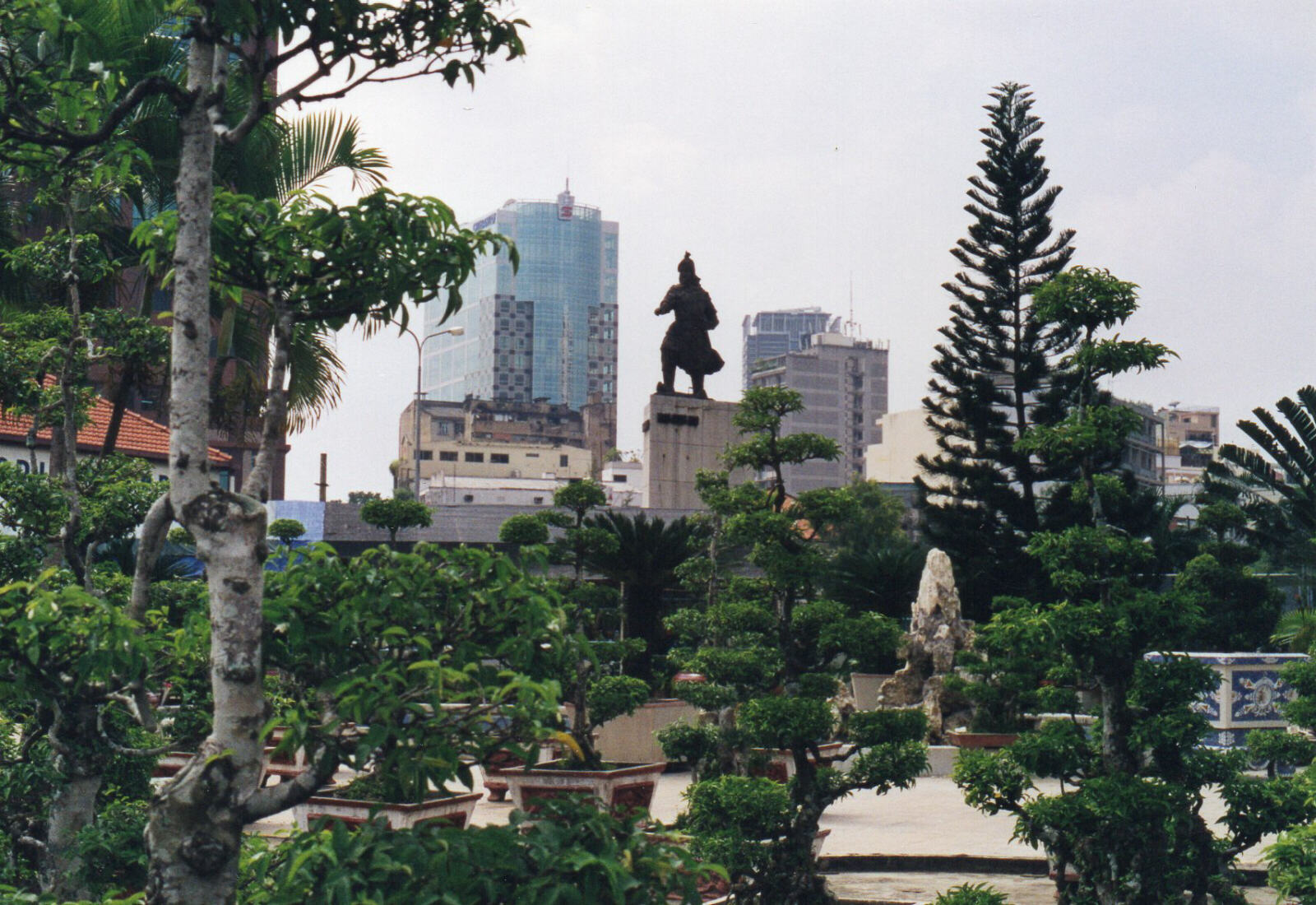
|
We saw the former American Embassy where the last people were helicoptered out in 1975, and cycled up past the zoo to the Emperor of Jade pagoda. This is a spectacularly colourful Buddhist temple with a wonderful atmosphere, full of fantastic statues and elaborate decorations, filled with smoke from burning incense sticks so that you stumble out with your eyes streaming from the smoke. |
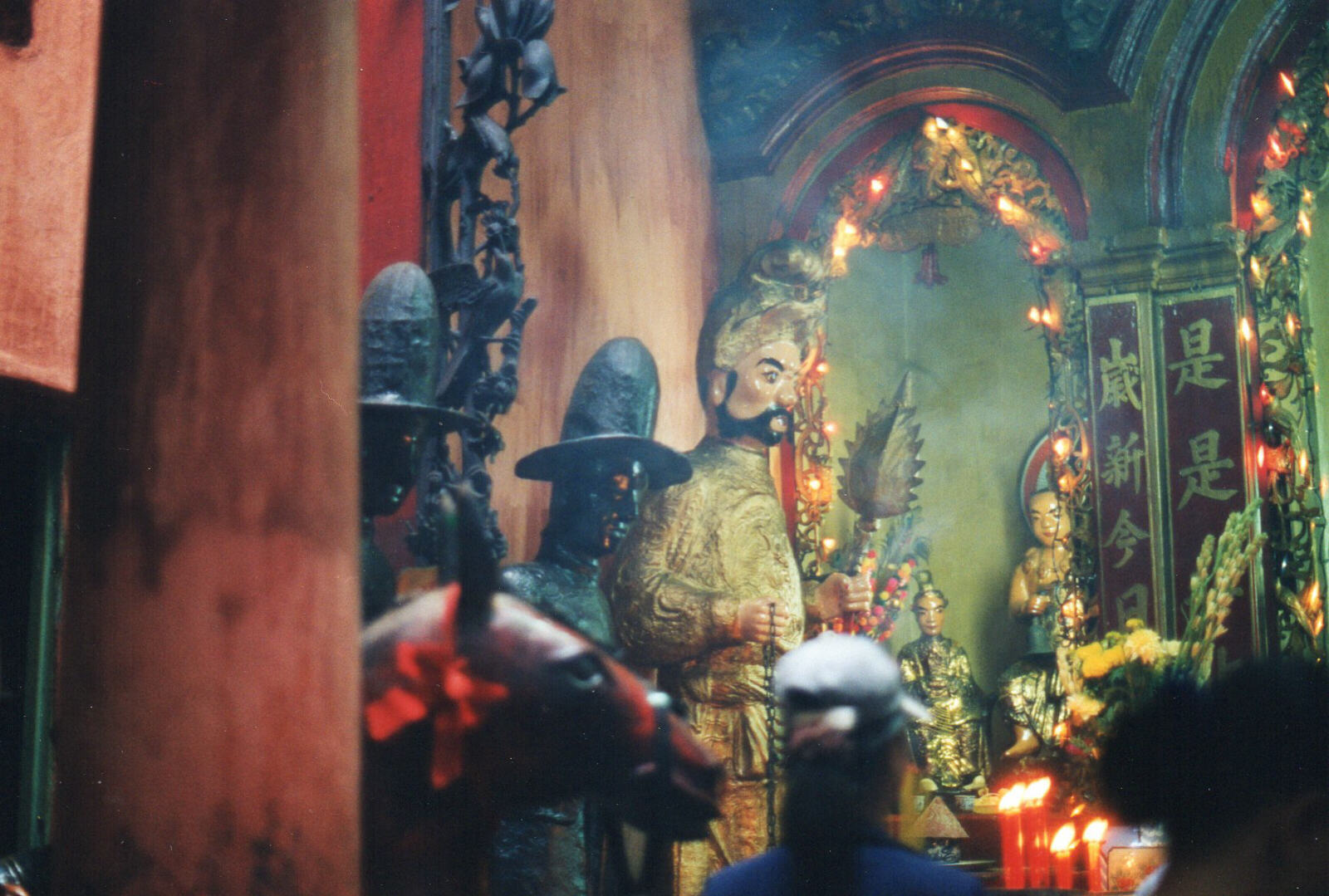
|
We then did a long haul across to the other side of the city, stopping on the way at a ceramics factory where people were painstakingly making the most elaborate designs using fragments of duck shell. We continued over to the Chinese market in Cholon district where we saw the ducks, as well as just about every other form of small livestock, for sale along the crowded streets. The market was highly specialised with different goods in different streets including one with dozens of bags of different kinds of sugar, another with dozens of different kinds of beans and a large area devoted entirely to motorbike spare parts. Some stalls were full of hundreds of a single engine part. On another street we stopped at a Chinese medicine shop that the 'tour leader' knew and inspected all the bottled snakes, lizards and other health-giving potions. |

|
The cyclo driver who led us had been in the South Vietnamese army and had gone through a harrowing period of 're-education' before he was allowed to become a cyclo driver. He is not allowed to have any other job and many of the cyclo drivers were formerly doctors or lawyers. Nevertheless things have changed dramatically in the last ten years. Then it was illegal to even speak English (or French) and if anybody talked to a foreigner they would be reported and were likely to be arrested in the middle of the night. On the final run back from Chinatown we stopped briefly at the Thien Hau pagoda which is also very colourful, before heading back to the hotel. It was altogether an absolutely fascinating tour.
That evening we treated ourselves to a few beers and a wonderful curry at the Sunshine Indian restaurant in De Tham street. This street is where most travellers gravitate to and we saw several of the Hué typhoon survivors walking past and several came in for a beer and a chat with us including the French ladies who had slept on the landing of our hotel and who had slept for two nights at the airport before they got out. They always looked smart and fresh whenever we saw them despite roughing it for days on end.
Tues 9th. We went on one of the standard tours today, to the VietCong tunnels at Cu Chi. Most of the cafés and hotels also act as travel agent/tour operators and run pretty much the same tours at the same prices but the big established ones like Sinh Café run big buses packed with tourists so we went to a new agent round the corner who had been recommended to Peter and we went in a minibus with just the six of us plus a Japanese chap who appeared at the last minute. Because we more or less 'owned' the tour we could change the departure time, ask him to stop for photos as we went along, etc. The first stop was at a petrol station outside Saigon which also had a tourist trap crocodile farm and little zoo attached. There was a pitiful little baby bear in one of the cages who seemed to just want company and he licked our hands and let us stroke him. As we were driving through the rural area outside Saigon we saw lots of rectangular bamboo mats propped up at the side of the road outside the houses. We asked the driver what they were and he stopped at one of the houses to show us - they were making rice paper and the mats were for drying the sheets of paper in the sun. |
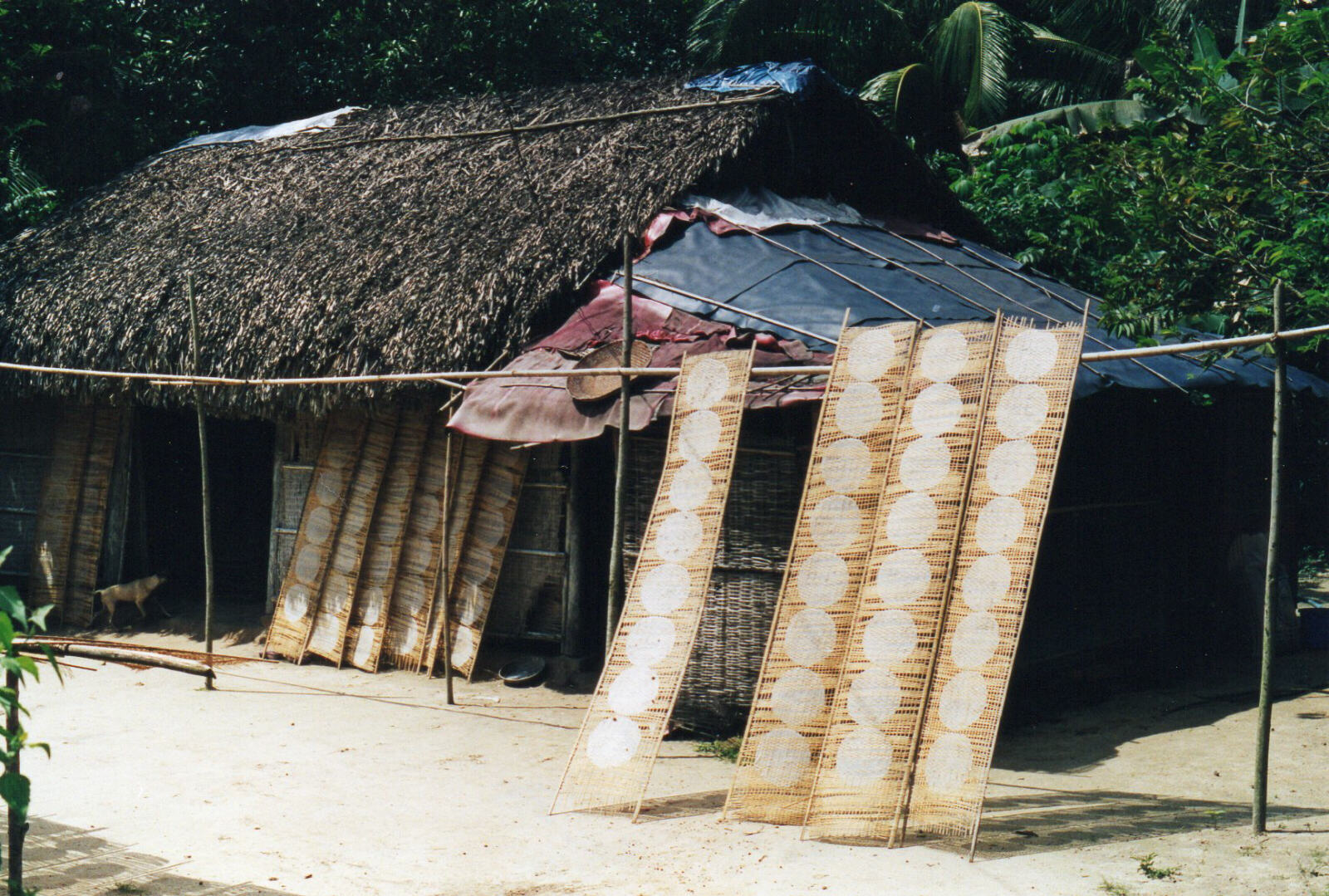
|
We arrived at the main tunnels entrance which is very touristy and went to a big modern temple which is a war memorial, with thousands of names round the walls inside and a big picture of Ho Chi Minh in the middle. The driver then suggested that we go to a different set of tunnels which are a bit less touristy, which we did. After an introductory video about the Cu Chi fighters who won medals for killing Americans we went into the forest and crawled through the tunnels. Most of them have been made bigger to accommodate tourists but one part has been left original size and it was a very tight fit. It was extremely hot and humid down the tunnels and it was hard to imagine people living down there for weeks on end.
It was mid-afternoon when we got back because we started late so there was just time to hire a cyclo to the Cambodian embassy before it closed, then for a quick tour round the city centre past the Rex and the Colonial hotels, the old grand hotels of Saigon. |
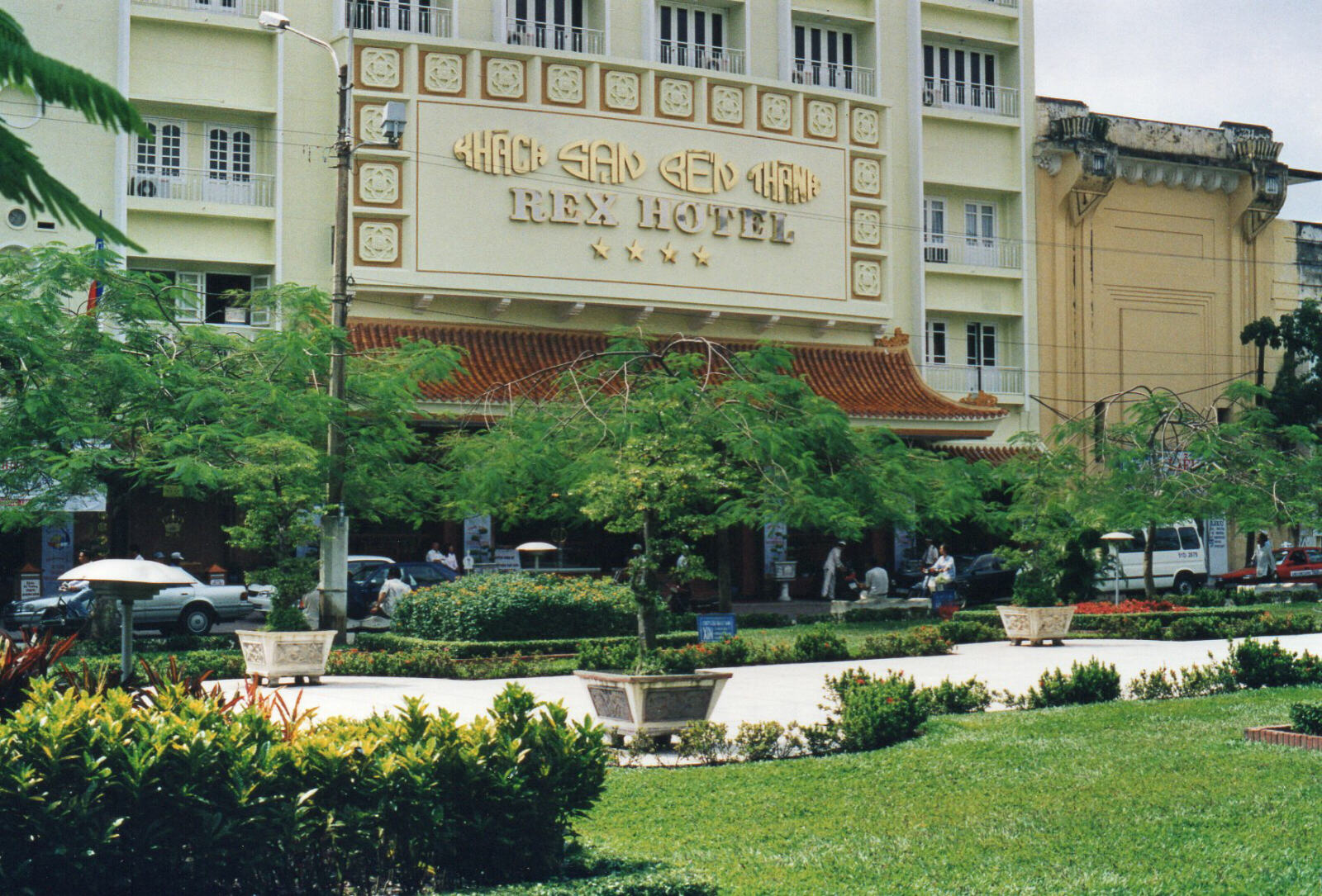
|
Then to Ben Thanh, the central market which was fascinating but rather a hassle, with the stallholders pulling and pushing at you to get you to their stalls. We walked back to the hotel and met up with Maria, Tracy, Peter and Lyn and went to the Lotus café for dinner. We had spring rolls and Vietnamese dishes such as lemon grass spicy prawns and ginger chicken. It was delicious and, like most things here, amazing value at about 45,000 dong (£2.25) each including a big beer.
|
The Mekong Delta, Vietnam
|
Wed 10th. We decided the only way to see the Mekong delta in the time available was on a tour. Maria and Tracy had moved round the corner to the Hong Kong hotel which is under the same management as the Thai Binh in Hué and also very good value, so we arranged through them for a day trip in a minibus and boat for just the four of us. We left just after 8am and drove out to Mytho, the nearest of the delta towns about an hour away. The drive was mostly through built up areas and we didn't see much rural life but Mytho was interesting, with the very pleasant Vinh Trang pagoda which gets radically different writeups in different editions of the Lonely Planet guide; this probably reflects the fact that a few years ago the Government ran pagodas as tacky tourist traps but now Buddhism is making a comeback, and a colourful market sprawling ove the street. |
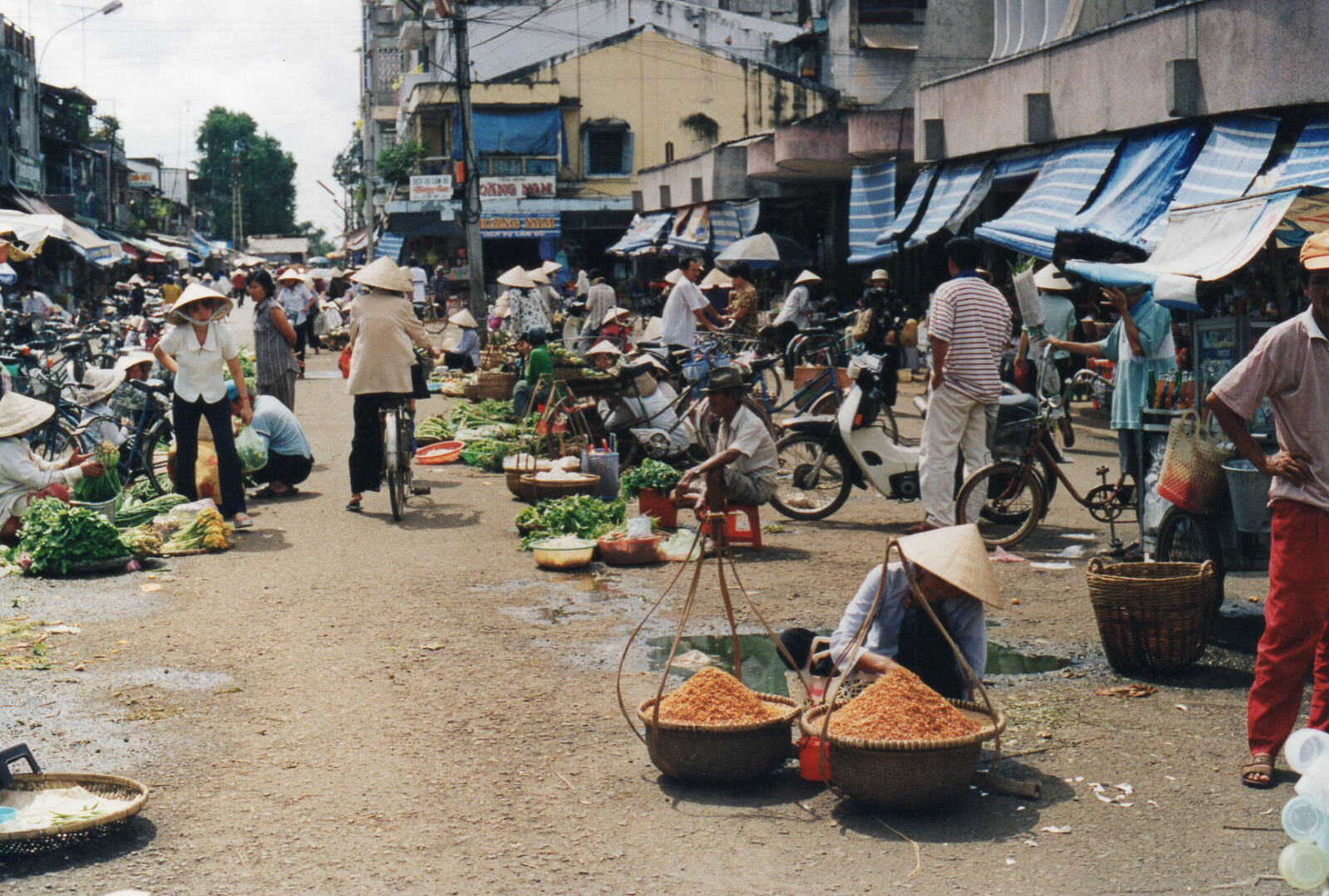
|
We then boarded our boat in a creek off the main river and set off into the Mekong, which is huge, even though this is only one of its channels. A big tourist boat went past and everyone was wearing life jackets, but all we had between us and the river was a few planks. We branched off the main river down a small channel which meandered between what looked like mangrove swamps, with fishermen who were immersed up to their necks in water. |

|
We ended up at Mr Thanh's bee farm on Thoi Son island where with some trepidation we were able to ease the bees aside and stick our fingers in the honey. We then sat in the garden restaurant under shady trees and had the best meal of the holiday. After tea with honey, which was incredibly sweet, we had plates of fruits and then a wonderful spread with a whole elephant-fish fresh from the river (we saw them catching the one for the next people who arrived) steamed with herbs, spices, tomatoes, spring onions and chillies as well as dishes of grilled and fried prawns. We ate the fish in a similar way to Peking duck - starting with a sheet of rice paper which you wet to make it soft and pliable then spreading onions, herbs and salad and picking chunks of fish onto it with chopsticks, then rolling it up and dipping it into a spicy sauce. There was a lemon pepper dip for the grilled prawns and a soy sauce one for the fried prawns, as well as rice and noodles. |
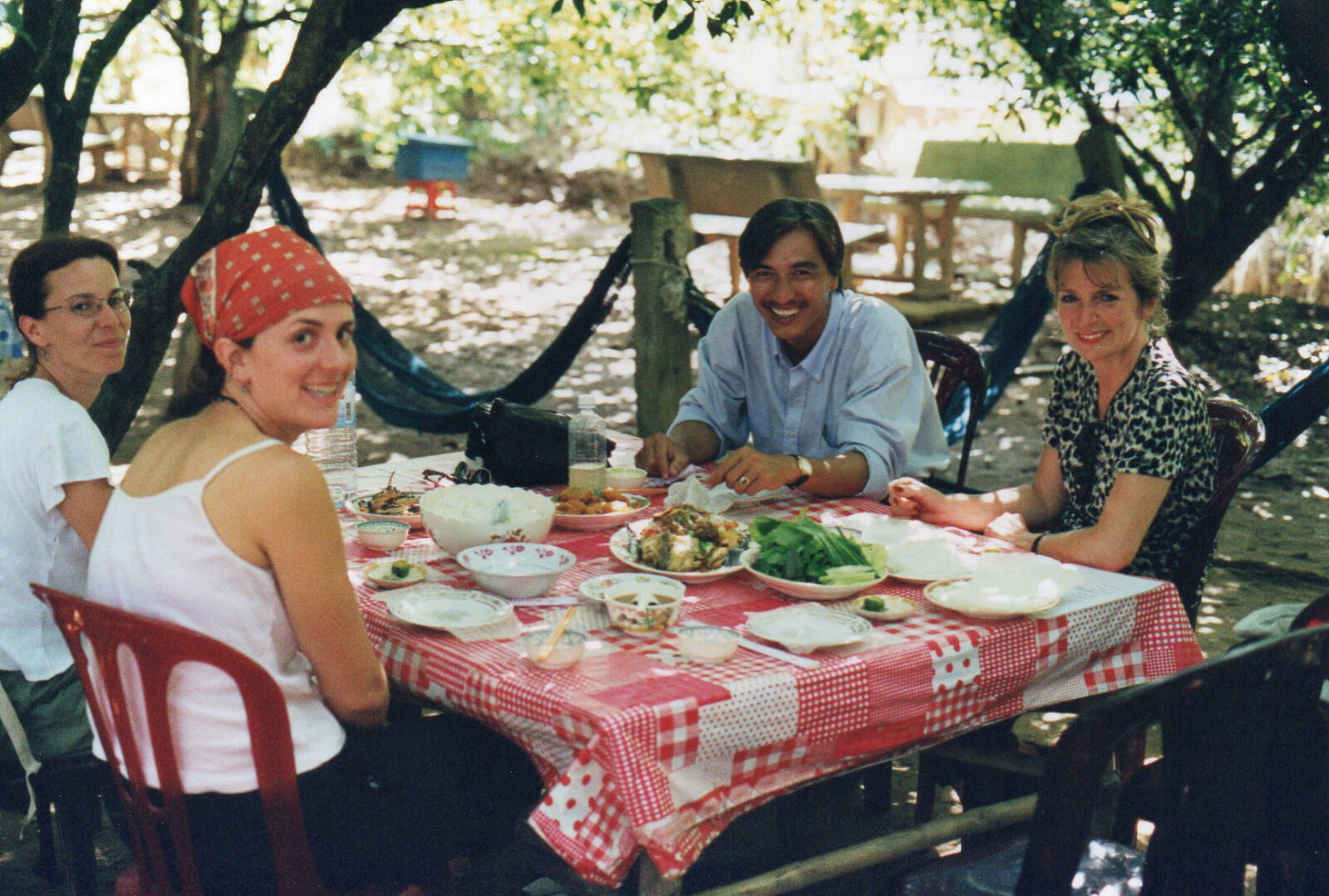
|
We were absolutely full after this and they set up some hammocks under the trees for us to lie in to recover! It was very expensive by local standards, $21 for the five of us (including our guide) but ridiculously good value by western standards. For pudding we went for a short boat ride to a coconut candy factory where they produced different sorts of coconut sweets and some really lethal banana wine, then back in the boat to Mytho. |
Back in Saigon
|
It was about 5pm and we dozed in the minibus through the dusk on the way back, to avoid being terrified by the kamikaze driving standards as we ploughed through the Saigon rush hour. We probably paid well over the odds for everything - $20 for the boat for the day, $24 for the minibus and $8 for the guide, but we all thoroughly enjoyed the day. Despite being full from a huge lunch we went to the Sinh café as soon as we got back and managed to enjoy several beers and some barbecued chicken and beef.
Thurs 11th. A day at leisure in Saigon. While Sheila went shopping for clothes, which are ridiculously cheap here, I walked around the central area taking photos of the pretty turn-of-the-century town hall, the very grand and ornate Post Office .... |
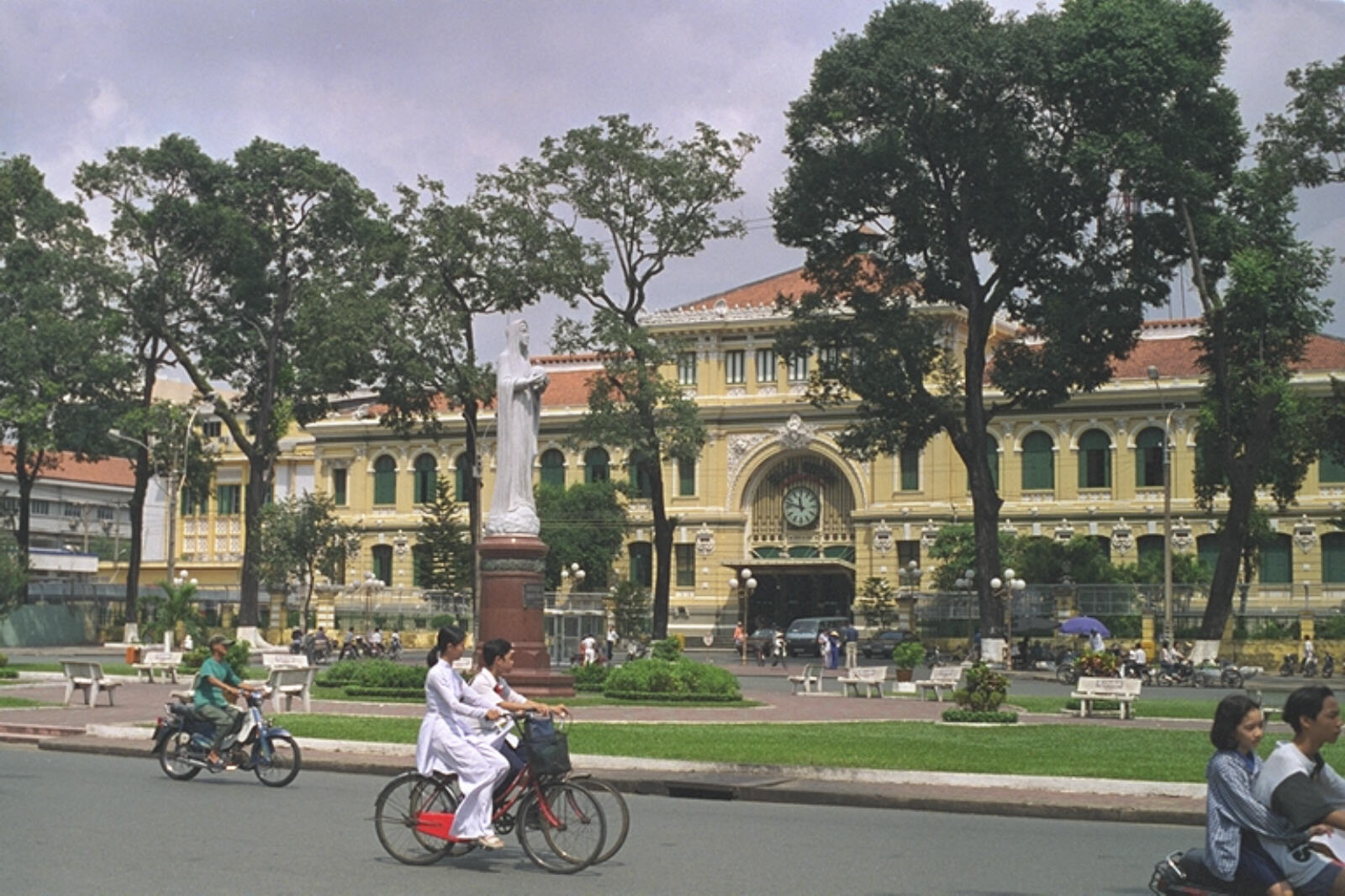
|
.... Reunification hall which is the former presidential palace where the South capitulated in 1975, and the Museum of the Revolution in a neoclassical last-century building which seems to be the favourite place for newlyweds to have their photos taken, standing next to the tanks and captured American fighter planes. Later in the afternoon we went and had a cup of coffee in the Rex Hotel and had a look at the rooftop bar, then after a bit more shopping in the nearby 'Russian market' we went round to the Continental, the other classic old hotel and had a cocktail in the Bamboo Bar, the spot where all the foreign correspondents used to gather during the war, but the drinks were pricey and there wasn't a lot of atmosphere. Maria and Tracy fly back to the States tomorrow so we met up for a farewell meal at the Sunshine Indian again and it was just as tasty as last time.
Fri 12th. And then we met them for breakfast at the Sinh café and had an emotional farewell as they left for the airport. You get very close to people you've lived through a natural disaster with. But the relentless sightseeing has to continue and we set off for another five-hour cyclo ride. Sheila had the same well-informed, good-English cyclo driver and I had the same cheerful, friendly, one-toothed one as on our six-hour tour the other day. We wanted to go to the Giac Lam pagoda over on the other side of the city and the cyclo driver insisted on taking us to a glass-blowing factory which was on the way. We weren't keen on this because we thought it was going to be a tourist trap but it absolutely was not - we walked into a huge tin shed and inside it was an inferno - there were open furnaces blasting out heat, people walking about blowing red-hot glass bowls and jars on the end of metal pipes and there were showers of sparks as they patted them into shape with sticks. There was broken glass all over the floor, they only had flip-flops on their feet, the heat was indescribable and there was certainly no sign of an inspection certificate from the health and safety department! All the people there (who apparently work 12 hours a day seven days a week) were very friendly and insisted that I have a go at blowing a glass jar, but mine ended up lop-sided and was consigned to the scrap heap.
After this the Giac Lam pagoda was a haven of tranquillity. It is the oldest in Saigon and is full of mellow woodwork and intricate decorations, with a community of monks who live and study there. We learned that a monk only qualifies for the saffron-coloured robe after ten years and after being a monk for thirty years they are entitled to wear a black and white chequered-pattern robe that we hadn't seen before. |
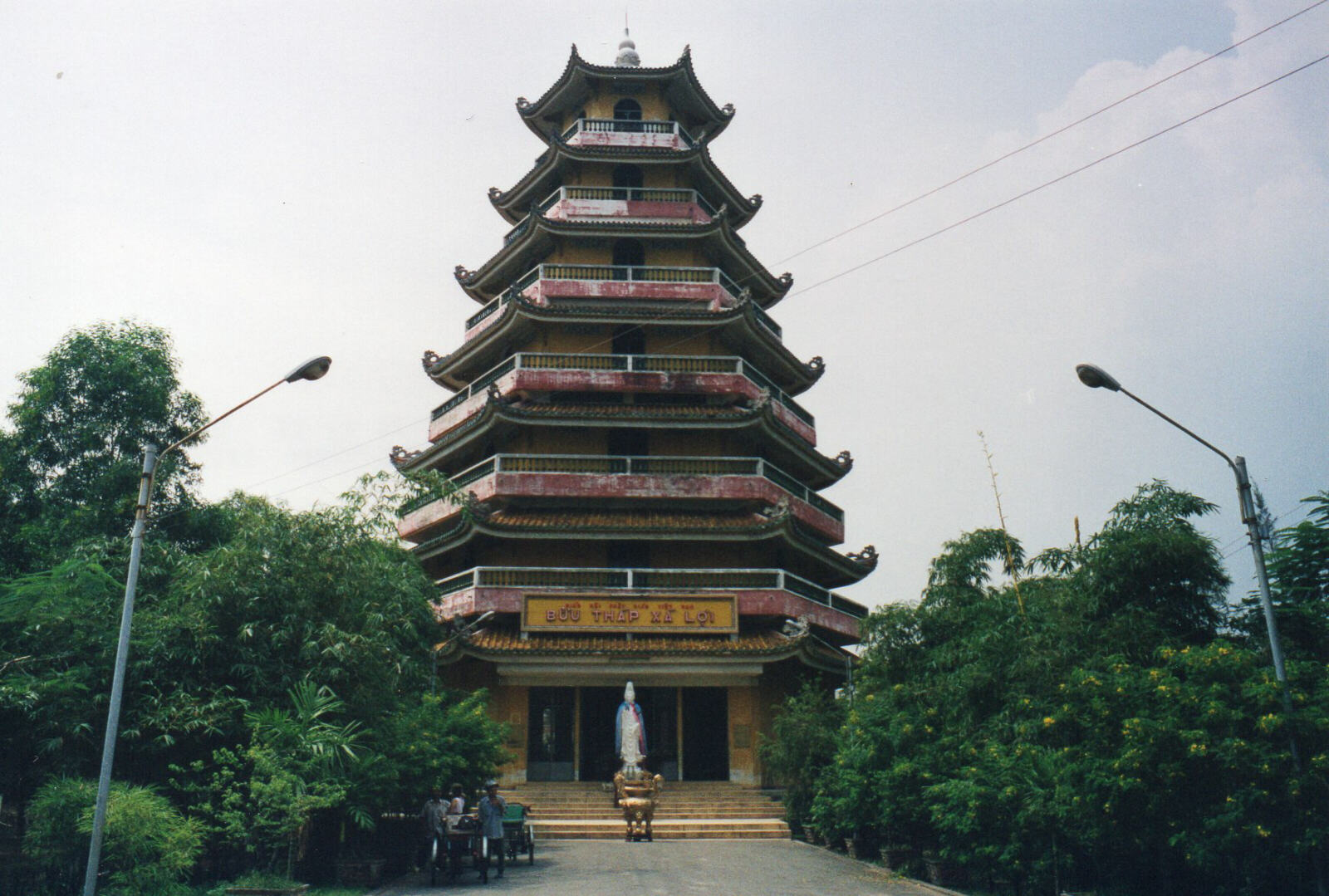
|
Next we cycled way over beyond Chinatown to see joss sticks being made but it was a bit of a washout because it started to rain as we got there and they were rushing about bringing in the joss sticks which had been drying in the sun. We cycled back along the Black River, one of the branches of the Saigon river, and it really was black - covered in oil and smelling like a sewer. All the banana boats were moored up along the quayside with bananas from the Mekong delta area. I don't know why sitting in a cyclo and being pedalled around town by someone else should be tiring but it is and we went back to the hotel exhausted. The cyclo driver told us we had seen everything there is to see in Saigon - this is pretty unusual, they can always find something else to persuade you to see.
After a rest and a sandwich left over from breakfast for lunch we went down to the Russian market to temporarily satisfy Sheila's shopping urge and bought various 'brand-name' outfits at ridiculously cheap prices. As dark fell we thought we'd have a drink on the rooftop bar at the Rex hotel but we found it was closed because it was being used for a Miss Asia beauty contest, so we went and had a beer at a café on the corner instead. We booked what appeared to be the last free table in the Rex's restaurant (all the others had 'reserved' signs) and had a really good meal of steak with peppercorns and steak tartare which the waiter mixed in front of us, although we stuck to beer because the wine was a bit pricey by anybody's standards. |
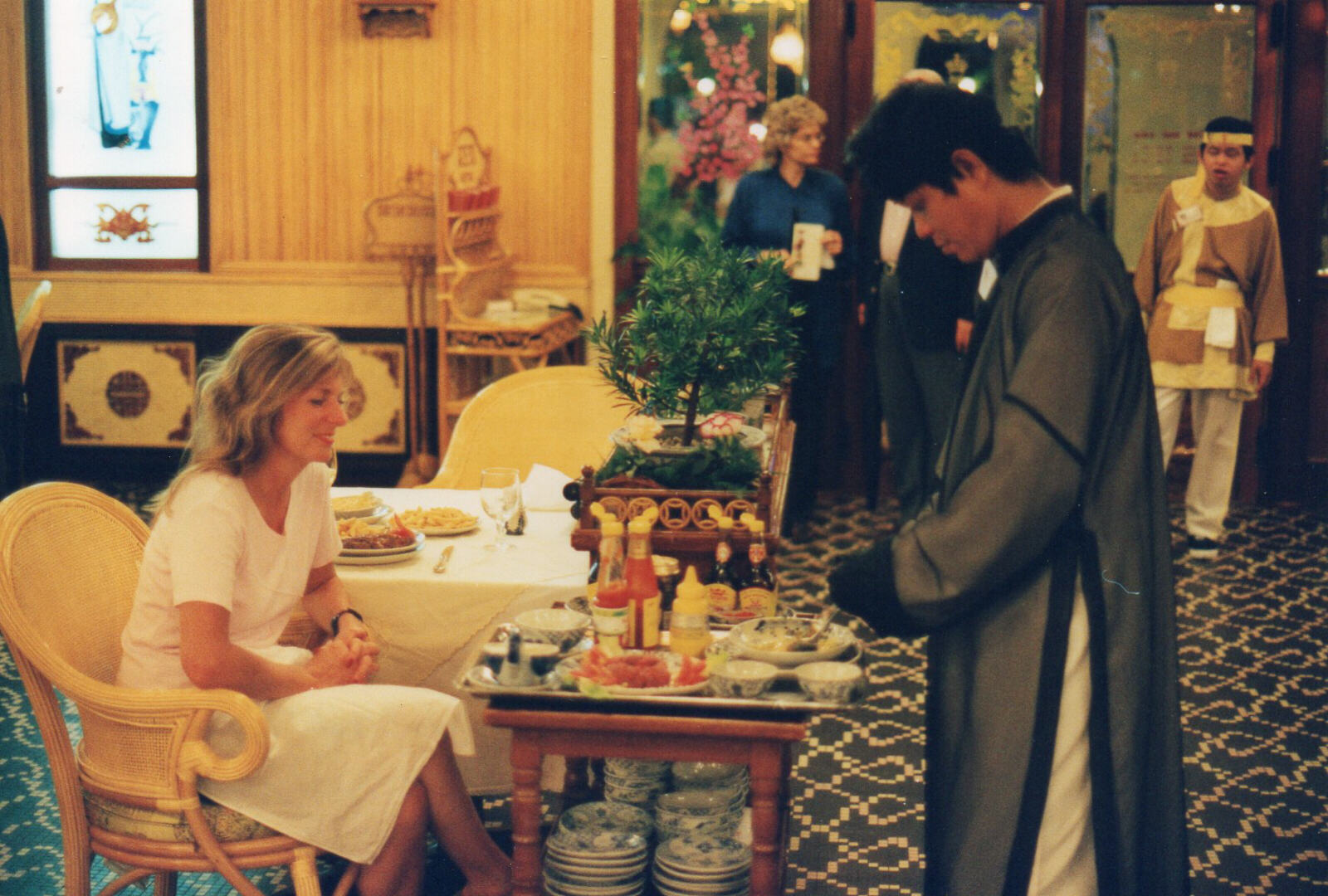
|
There was a floorshow with Vietnamese music and dancing, probably for the benefit of the large groups at the reserved tables, but we enjoyed it too. Back at De Tham street we went looking for Peter and Lyn who were due back from their Mekong delta trip today but it started to rain again so we bought some CDs instead.
Sat 13th. We set off from Saigon to Cambodia. This is our route across Cambodia to Thailand.
|
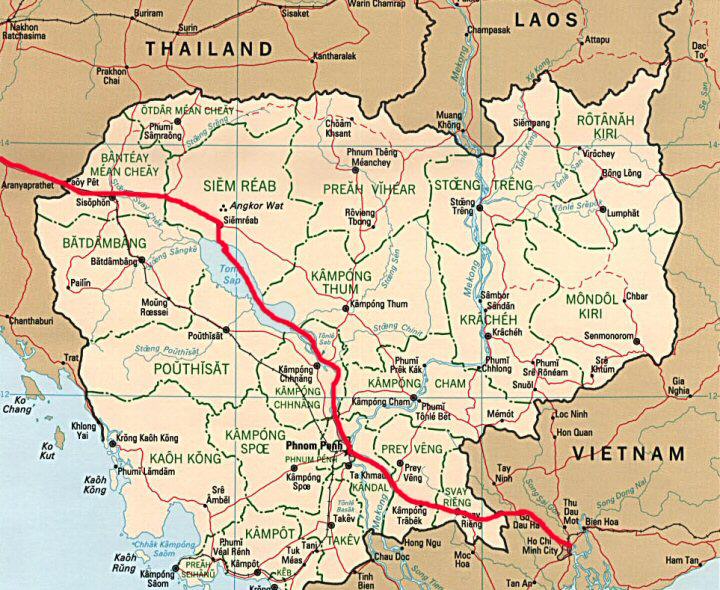
|
From Saigon, Vietnam to Phnom Penh, Cambodia
|
We packed up and checked out of the Southern hotel, where the girls at the reception desk said they were so sad to see us go - they're so sweet! We had breakfast with Peter and Lyn at the Sinh café and then the Phnom Penh bus appeared and with a bit of deft footwork Sheila managed to occupy the two front seats with a panoramic view. The trip cost $6 each and the bus was big and modern with air conditioning so we settled down to enjoy the ride to Cambodia. However, our smug self-satisfaction was a bit premature because when we got to the Vietnam-Cambodia border it all started to go wrong. The driver unloaded all the baggage from the bus but didn't bother to explain anything so we didn't know if we had to take it through ourselves, if customs were coming to look at it there or what. We finally gathered that there would be a different bus at the other side, so we and an Australian chap with a surfboard for luggage set off to go through the border formalities while all the other passengers went to the Vietnamese border post café for a drink. As a result, when we had cleared through into Cambodia, which was fairly straightforward, we had to sit in the Cambodian border post café and wait for them to catch up. Several of them said that the border officials had found some real or imaginary errors in their visas or forms and they had to pay a few $$ to get through but we didn't. There are no official moneychanging facilities but a chap on a pushbike with wads of money came along and converted our Vietnamese dong into Cambodian riels at what turned out to be a not-too-exorbitant rate.
The Cambodian equivalent to the Sinh café/tour agent is the Capital restaurant/guest house and there was one of their minibuses at the border but it clearly wasn't big enough for all of us so we continued to sit and wait. It was sweltering hot even in the shade and the sweat was dripping off us. Eventually another minibus turned up with the people going into Vietnam and we thought we would get going at last but it wasn't so easy. There was a lot of disorganised to-ing and fro-ing as they collected the tickets and loaded the people on one bus and the luggage onto the other (which was pretty worrying in itself and we wondered if we would ever see it again) and the surfboard caused some confusion but eventually we were ready to go. The bus, which did not have a/c, moved forward a few yards and stalled and the driver and conductor started messing about with the engine, then asked us all to get off and push it to start it! We did that (in the sweltering heat with the sweat dripping off us) and got on board again, then they asked us to do the same thing for the luggage bus which also wouldn't start.
Finally we set off from the border and for a moment there was a wonderful rush of cool air through the bus windows, then a hundred yards down the road he stopped and started fiddling about with the engine again. At this point we were close to having a sense of humour failure. The conductor said it would take about ten minutes while they replaced the fanbelt so we all got off and stood around until he announced it would take two hours while they sent another bus. The sense of humour failure was now total and Sheila stood in the road flagging down cars. A couple of cars stopped and started negotiating a price for the ride to Phnom Penh - it wasn't clear whether they were taxis or just opportunistic passers-by. After a lot of messing about we settled for $6 per person and Sheila and I got in one car with Marcus and Kasha, two of the bus passengers, while four others got into the other car. The rest of the passengers seemed contented to wait.
It was now about three or four pm, around the time the Sinh café said we would arrive in Phnom Penh, and we set off down the road at a terrific pace. The Cambodian infrastructure is still in pretty poor shape and the road was terrible, full of potholes, most of which the driver just charged through, sending us flying about the car and kicking up clouds of dust or spraying bystanders with muddy water. At least we were making good progress, until we skidded to a halt with a puncture. The driver opened the boot and we were relived to see a spare tyre, but less so when he flagged down a passing cyclist and loaded both wheels onto his bike to take them to the repair shop. Obviously he doesn't bother to get them repaired one at a time. He was back surprisingly quickly and we made good progress along the appalling road as far as the Mekong ferry crossing at Neak Luong. It was dark by the time we got there which was a pity because it was a fascinating place full of food stalls, including one selling cooked tortoises still in their shells, and shops which we started to explore. There were quite a few other vehicles waiting to cross but our driver clearly knew the ropes because he got into a different queue and we were among the first to drive on. The ferry set off and there was no sign of the luggage bus, which had overtaken us while we had the puncture and which we had gone storming past after it was repaired. |
Phnom Penh, Cambodia
|
We arrived in Phnom Penh around 7pm and the driver dropped us at the Capital café/tour office. We were not feeling too charitable towards them, having put us through such a troublesome journey but we had no choice but to wait for the luggage so we sat in the café with Marcus and Kasha and had several Angkor beers and some food (my chicken and ginger was particularly nice). The luggage bus turned up and we were reunited with our suitcases which was reassuring and then the man in charge of the tour desk came and gave us a refund of half the bus fare we had paid ($3 each) so we felt that they were doing their best. We were still having a few more beers when the rest of the passengers finally arrived after 9pm and they were very disgruntled because they did not get a refund because they had completed the journey as booked! Sheila went off to look at hotels but the ones she found were either full or not very nice, so we decided to stay where we were at the Capital Guest House which is not particularly nice but is very cheap. We had a twin room with fans for $4. We showered off the road dust and slept very well until about 5am when the noise started.
Sun 14th. The Capital Guest House is a bit noisy at the best of times but Sunday is the day for weddings, wedding parties involve playing high-pitched Asian music very loudly at street-side cafés from the early hours of the morning and there was one right next door to us. We resolved to move hotels so we set out for a tour of the town on the back of two motorbikes for $1 an hour each. Almost everything is priced in US$ here and you don't really need any Cambodian money at all. We had a good tour round the city, passing the royal palace, temples and pagodas and the river front, which is very attractive here with small boats and riverside parks and restaurants (unlike Saigon where the river front is very disappointing, dirty and industrial).
We stopped at the Hotel California which Peter had recommended and by a stroke of luck some people were checking out of one of the front rooms with a balcony and a view over the river. The hotel is very pleasant and clean and quite small, with just one prime-position front room per floor so we jumped at it and didn't haggle over the $15 price. The room had a/c, TV, fridge, ensuite bathroom with a bath tub, and wicker chairs and a table that we moved out onto the balcony to sit and watch the passing life on the river. Phnom Penh is at the junction of the Mekong and Tonle Sap rivers and there were fishing boats and ferries of all shapes and sizes going up and down to entertain us. |
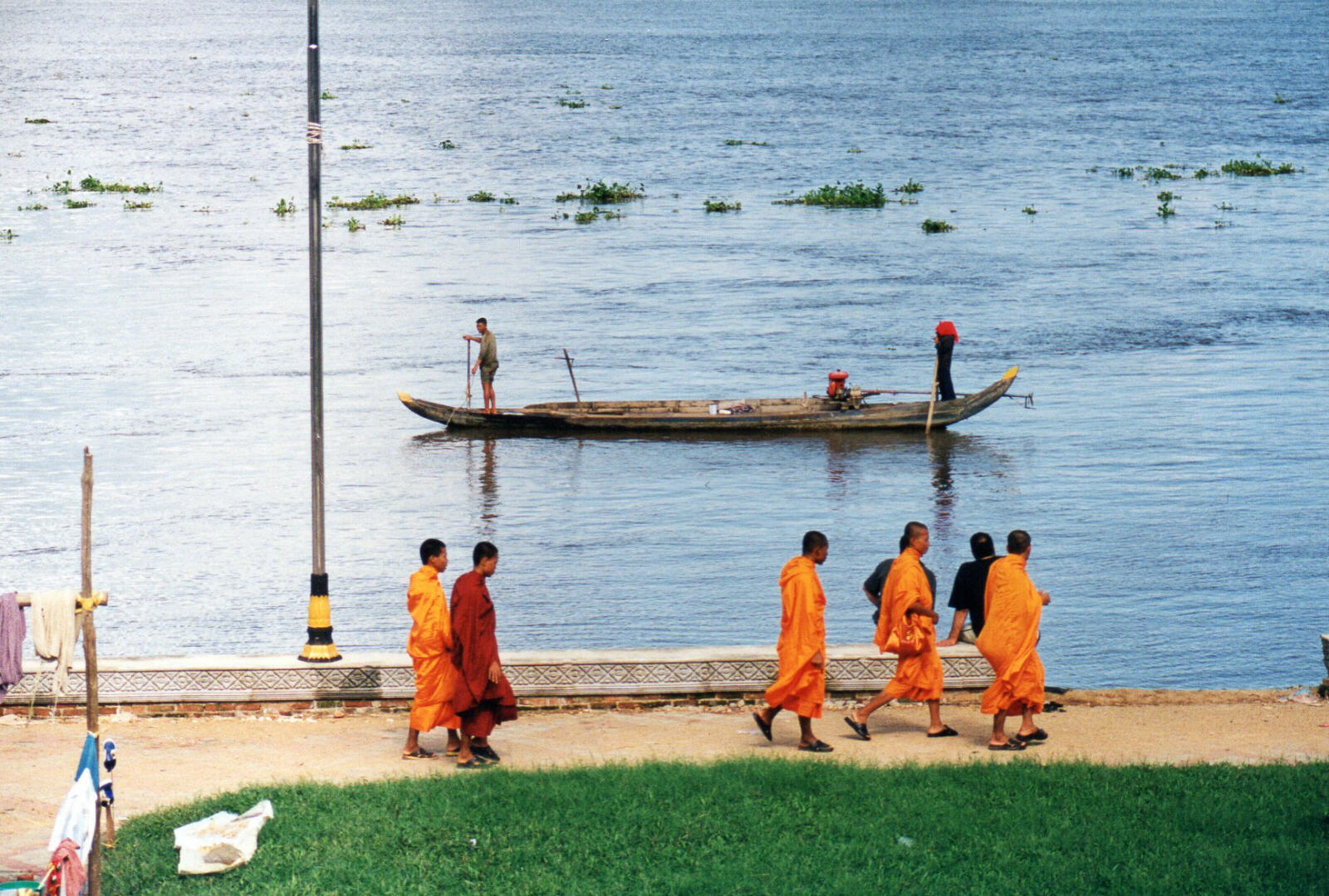
|
The riverfront is lined with several French-style cafés and bars and we walked down to one of them, La Croisette, for brunch of baguettes with ham, cheese and salami and orange and lemon pressé. Sheila also had a Kir Royale to perpetuate a tradition she started in Ouagadougou last year of drinking Kir in nice restaurants in obscure places. There seem to be a surprising number of westerners in Phnom Penh, more than in Vietnam, or maybe it's that Saigon was so huge that they were hidden more effectively. Certainly there are proportionally far more cars and less pushbikes and motorbikes than in Saigon and Hanoi. Many of the foreigners speak French here and there is a definite French influence. Overcome by the heat, or maybe the Kir, Sheila retired for a nap through the hottest part of the afternoon and I sat on the balcony watching the world go by in the street and on the river below. There's going to be some sort of boat race festival in a few days time and one of the teams of about 40 men marched down the street carrying their boat accompanied by a procession of musicians in trucks. Later, as the rush hour built up, an elephant walked past. It was the elephant that we saw during our motorbike tour at Wat Phnom, the landmark pagoda in the city, doing rides for children. Next morning at 8am it plodded past our balcony on its way back to work. |
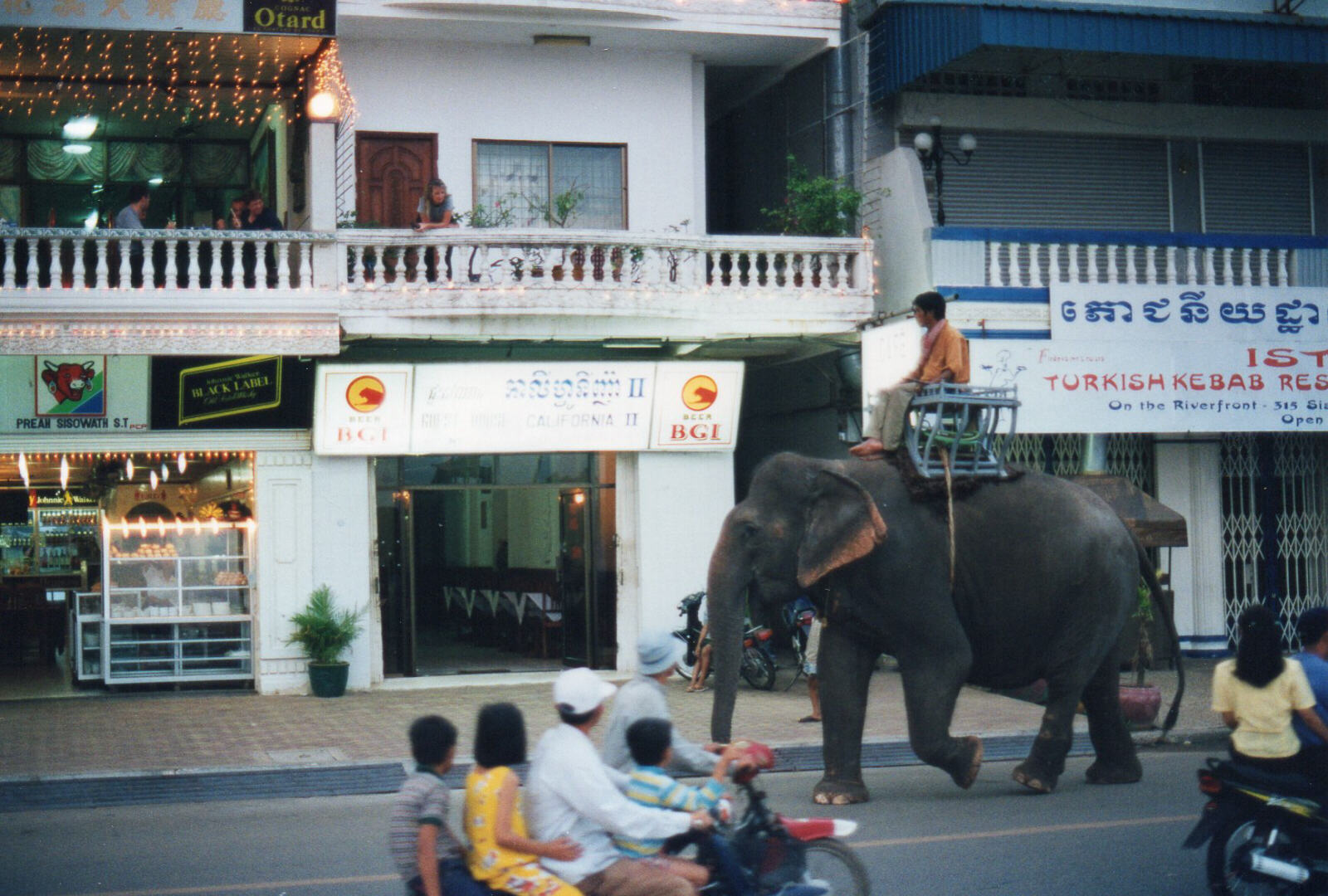
|
Feeling refreshed from a lazy afternoon we got dressed up in clean, pressed clothes (quite a luxury) and went to the Foreign Correspondents' Club for a drink and a meal. The FCC is in an old colonial-style building and the bar and restaurant have large open balconies overlooking the riverfront. There is a great high ceiling with fans and there is a library and easy chairs where you can just sit and relax with a drink. This is clearly the 'ex-pat's club' of Phnom Penh. There is a superb menu of western food and we had Caesar salad followed by pizzas from the real pizza oven, with a carafe of very pleasant red wine. That morning during our city tour we had booked a table here for 7pm and when we checked out of the Capital Guest House we left a note for Marcus and Kasha telling them where we were going. Unfortunately when they checked with the FCC the staff said our reservation was for 7:30 so when they arrived we were already tucking into our starter, unaware that they were coming to join us. However, we managed to move to a table for four and had a really pleasant evening chatting with them, until we realised that the staff were hovering around willing us to go away because it was nearly midnight.
Mon 15th. We woke up at 7am to a glorious, sunny and already hot day and ambled down the road to another of the French cafés for breakfast. We were going to look round the Royal Palace and Silver Pagoda which were close by our hotel but we dawdled over breakfast so long that Sheila decided to have a sunbathe instead while the sun was still on our balcony and I went for a walk round taking photos of the outside of the Palace, the National Assembly building and other monuments. On the river, one of the boat race teams was practising, 56 paddlemen, a pacemaker and a helmsman rowing up and down all immaculately dressed in white. |
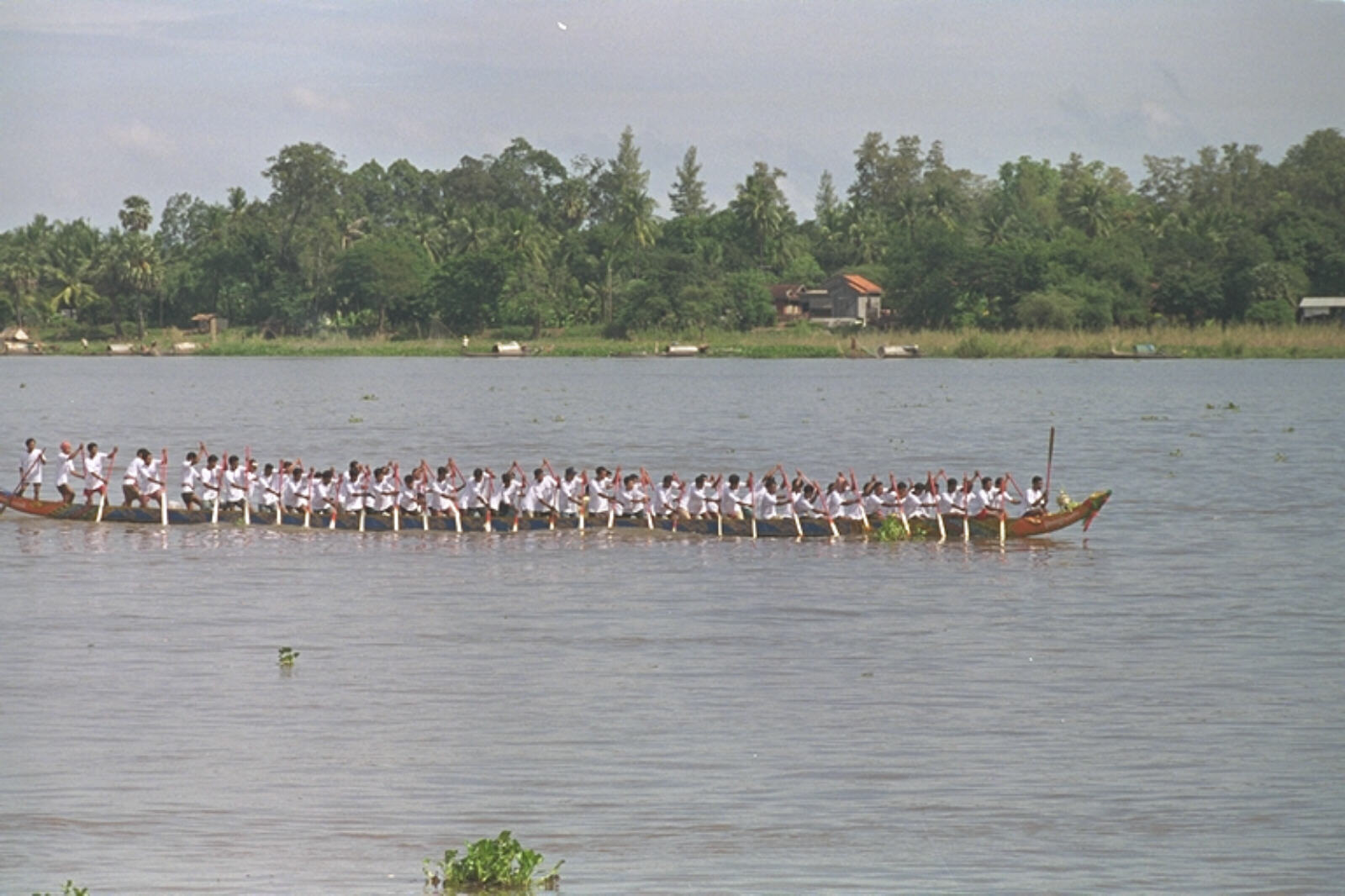
|
We went back to La Croisette for lunch and had French onion soup and more baguettes and Kir. Sheila crashed out for a nap and I walked up to the other end of town. As soon as you go a couple of streets back from the riverfront it's a different world, with crowded dirty streets and run-down buildings. I wandered round the base of Wat Phnom, a pagoda on the only hill in the city, went into the National Library, a graceful building constructed in 1924 which the Khmer Rouge had used as a stable, and into the nearby Le Royal hotel, the old 'Grand Hotel' of Phnom Penh where some of the action of the Killing Fields film is set and which has now been luxuriously renovated by the Raffles Group and charges a staggering $300 a night. I walked back through the new market, a cathedral-like building with amazing acoustics inside and back down to the riverfront which was still buzzing; they are building all sorts of displays and stands for the forthcoming festival and the place was a hubbub of activity.
Sheila awoke and we got a cyclo down the riverfront to Wat Phnom and had a quick look round, then went into Le Royal hotel and had a couple of beers at the elegant old-colonial Elephant bar. These came with huge trays of salsa dip and crisps which we demolished but we didn't let it ruin our appetite because we managed to go round the corner to the William Tell Swiss/German restaurant, taverna and Mongolian barbecue where Sheila had lentil and sausage soup followed by Hungarian goulash while I got through a couple of helpings of the Mongolian BBQ, all for $14.
Tues 16th. This morning, after a quick continental breakfast at the Café California (part of our hotel) we really did go to the Royal Palace and the Silver Pagoda, the main sight of Phnom Penh. We were there by 8am and the golden rooftops of the palaces, pavilions and pagodas were sparkling in the clear, bright sunlight. It's a wonderful place with a huge, airy throne room, well-kept gardens and topiary bushes and interesting royal relics, jewel-studded gold and silver Buddhas and other valuable artifacts. We dawdled around really enjoying it and didn't leave until after it closed for lunch at 11am. |
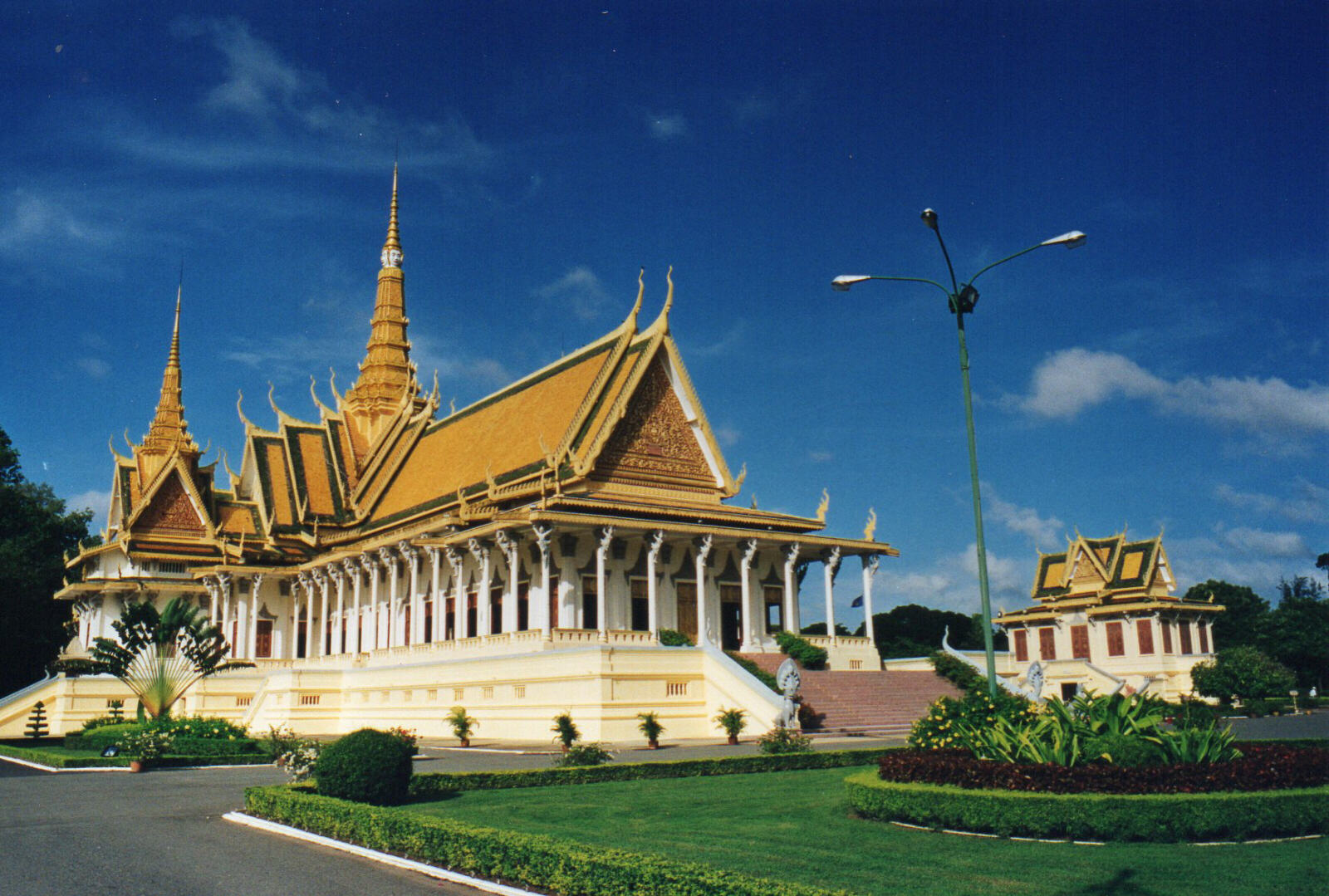
|
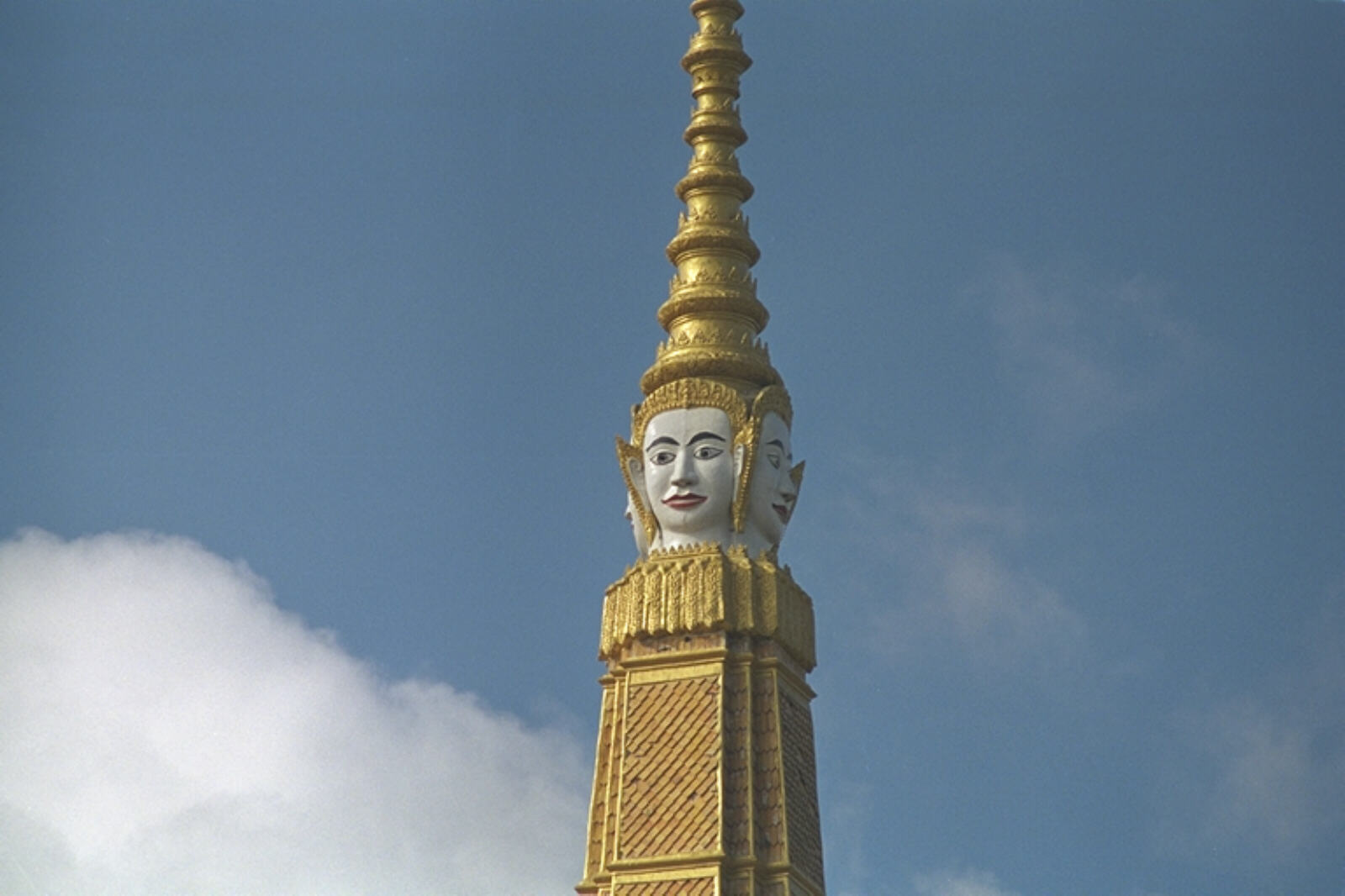
|
We then had a long, drawn-out negotiation with a couple of motorbike drivers, with a break for lunch of baguettes, Kir and sangria, culminating in a trip on the bikes to the Choeung Ek 'Killing Fields' genocide centre 15km outside the town. The road was appalling but it was an interesting ride through the Cambodian countryside. When we got there Sheila went in to see the piles of skulls but I wandered off to see the little farms and rural life along the road. Who needs a pickup truck if you've got a bike? |
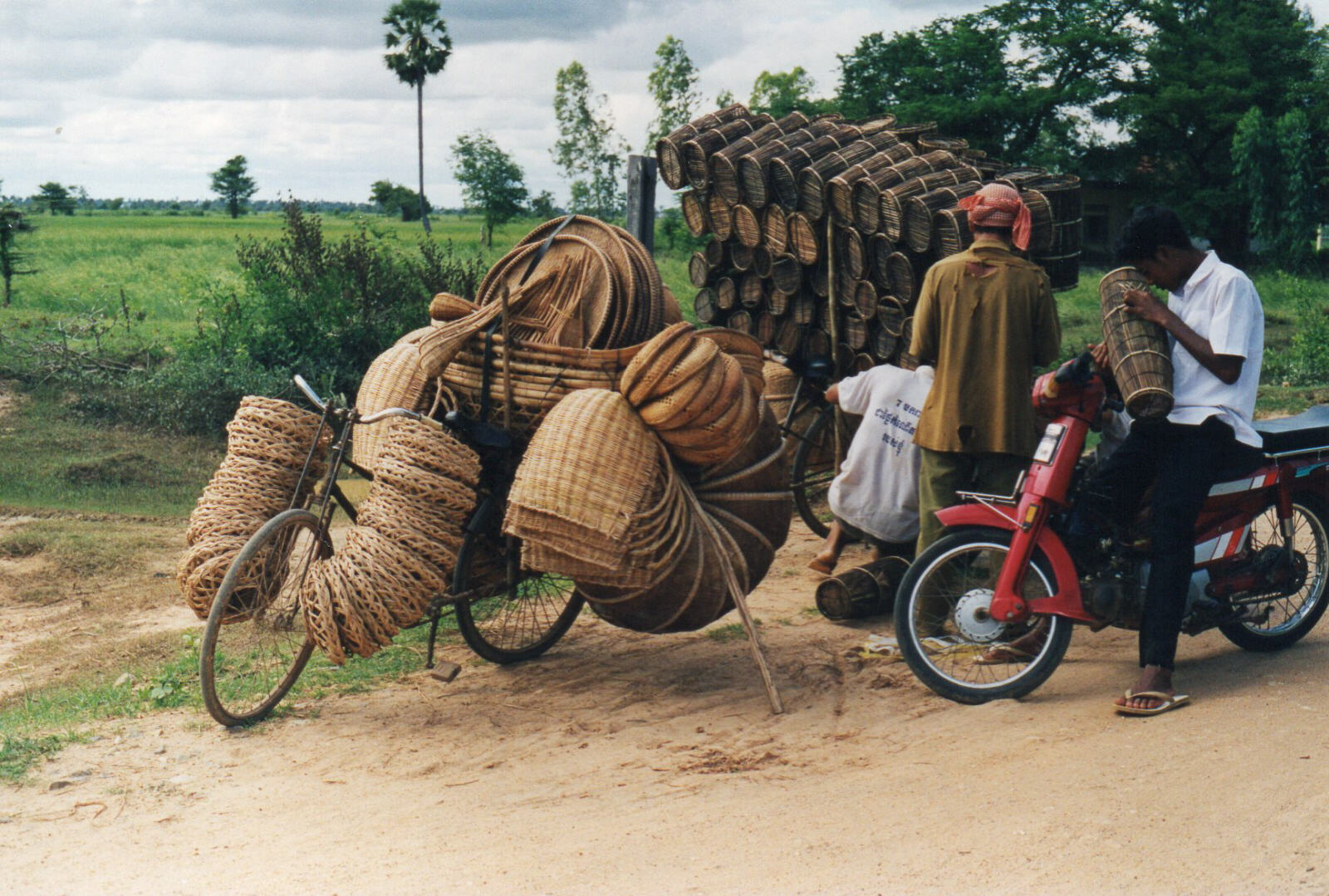
|
We came back on the bikes ($5 for the two of us) then sat on our balcony having a pot of tea, watching the expats and locals promenading along the riverfront below us in the late afternoon sunshine. At dusk we went for our own perambulation down the riverfront and stopped at the Riverside German bistro and bar where we had some German beer and a really tasty meal - sausage hotpot and smoked pork with sauerkraut, all for $16. We're really enjoying our relaxed time in Phnom Penh, with a bit of sightseeing here and there and plenty of good food and drink.
Wed 17th. We decided to start off at the other main attraction in Phnom Penh, Wat Phnom. We walked down the riverfront where three rowing teams were practising for the forthcoming event and teams of people were busy sprucing up the riverside gardens and laying ornamental paving stones along the riverside walk. |
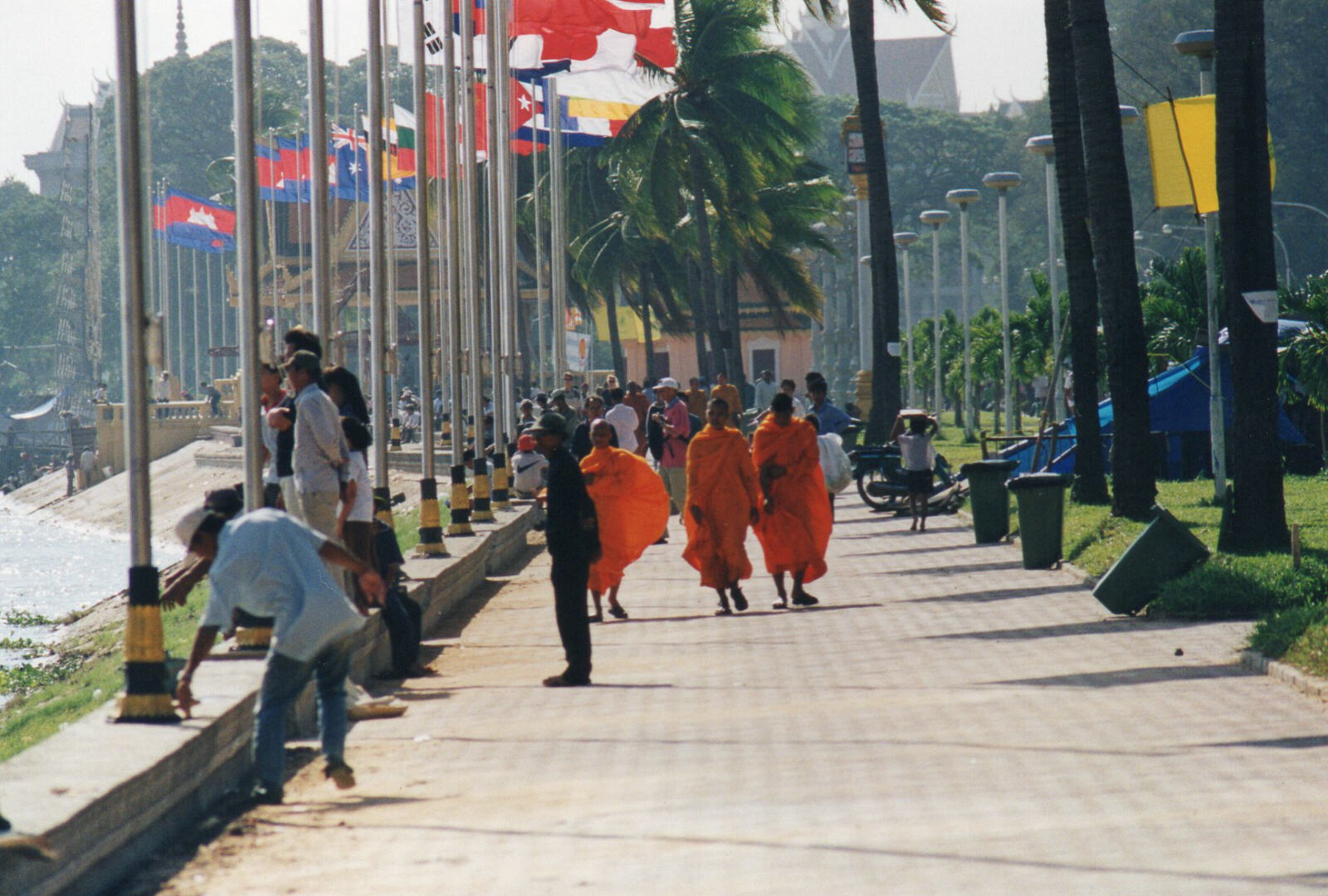
|
We stopped at the colonial-style Post Office to post postcards then climbed the steps through the gardens up to Wat Phnom which was sparkling in the sunshine. Having savoured the atmosphere and taken our fill of photos we stopped two cyclo drivers and arranged an hour's tour for $1 each so that Sheila could sunbathe whilst seeing the town. |
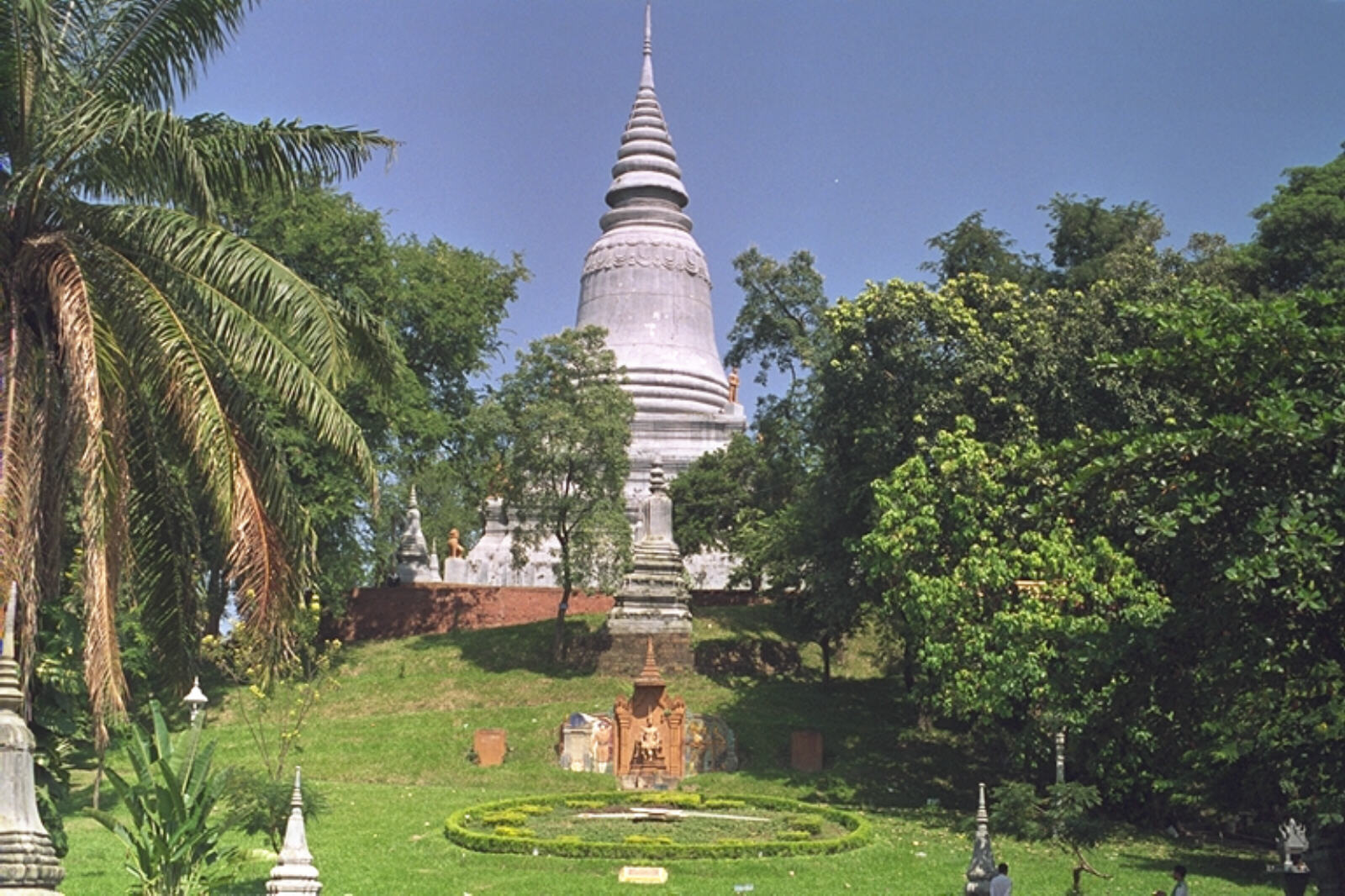
|
We ended up at La Croisette and had our standard lunch; it felt like being on the Riviera, sipping our drinks at a streetside café under palm trees beside the water. Only the cyclo drivers coming down the adjacent road from the market laden with bananas, sacks or whole families of people gave it an oriental feel. |
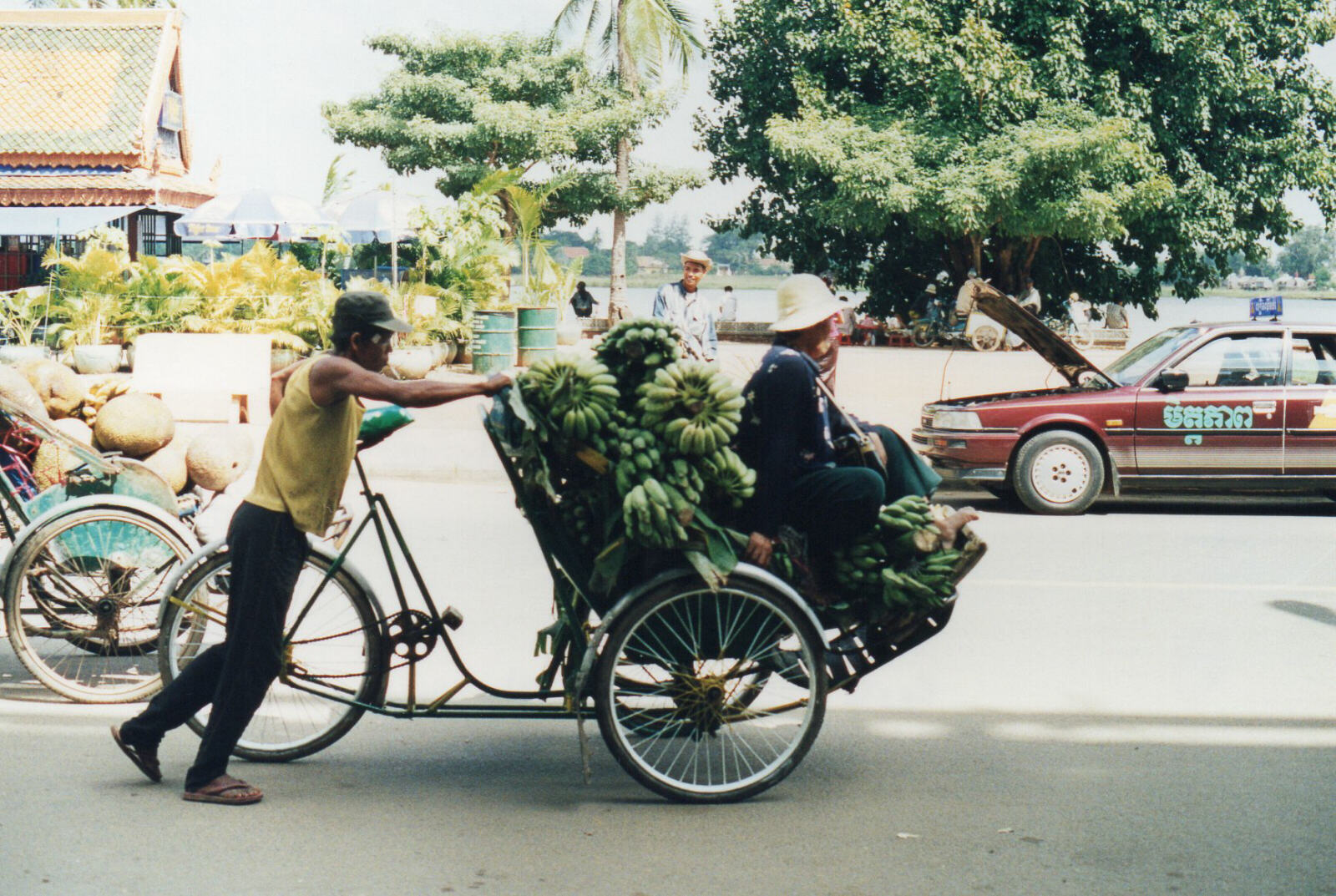
|
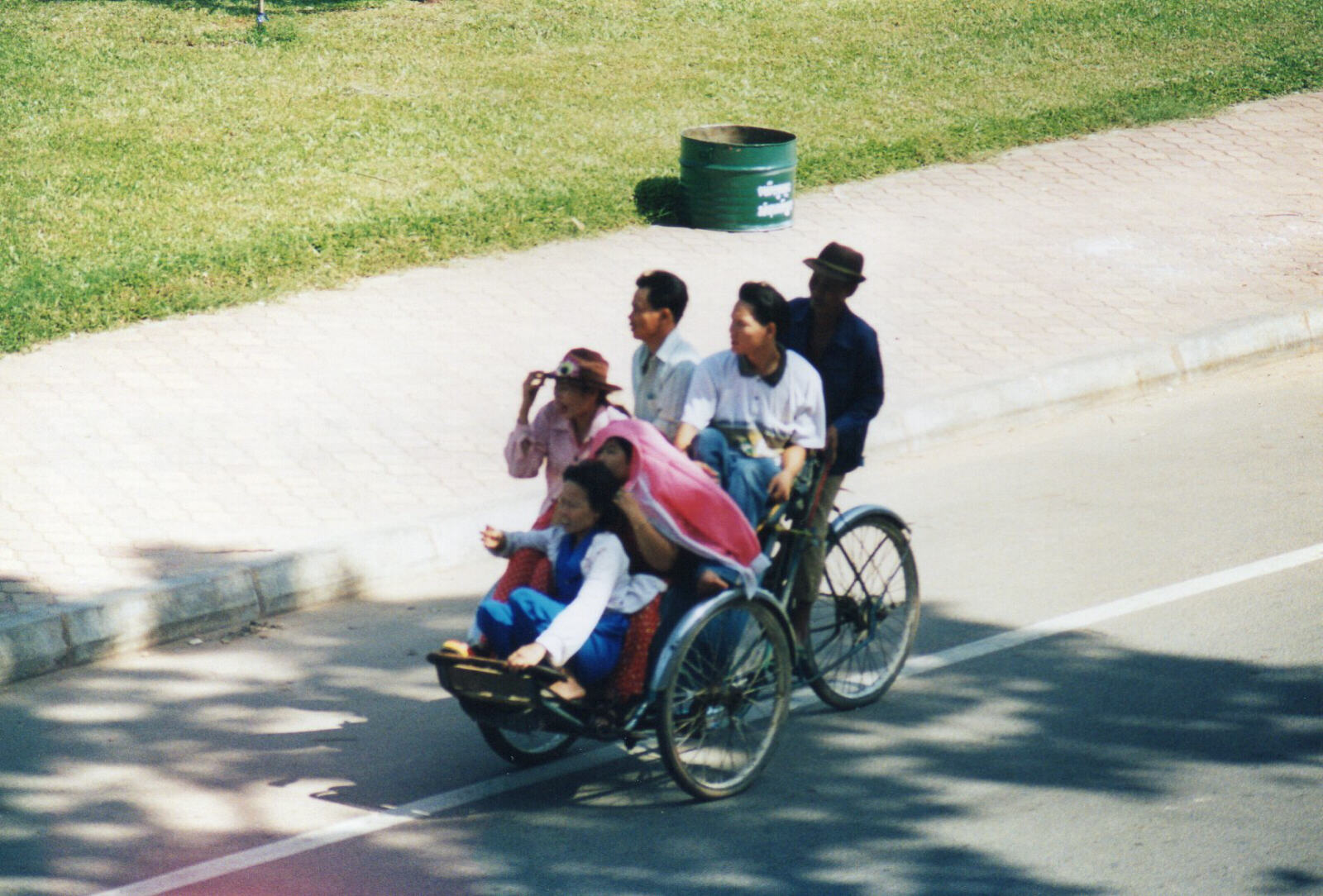
|
We whiled away the afternoon with tea on the balcony, watching the saffron-robed monks walk past with their yellow sun-umbrellas and later the elephant ambled by on his way home from work. This is our signal to go out drinking and we walked up the riverfront the other way from our hotel surveying the restaurants in that direction, intending to have a drink at one of the bars while we decided where to eat. However, we ended up at the Globe restaurant on the corner of the square opposite the Royal Palace and it was so nice, in an old, beamed colonial-style building with large windows open to the breeze from the river, that we both drank and ate there. I had Vietnamese spring rolls, which are crispy and herby-flavoured with a peanut dip, followed by peppery fish hot pot and Sheila had barbecued venison and lemon cheesecake. It was wonderful and cost, with drinks, $25. There are just too many great places to eat round here!
Thurs 18th. Well we can't spend any more time lounging around enjoying ourselves so we went to book the boat to Siem Reap, the town for the Angkor Wat monuments. We got a moto (motorbike 'taxi') down to the boat office and bought tickets for tomorrow at $22.50 each, supposedly including pickup from the hotel although this subsequently turned out to be a swindle.
Then we went round to the Royal Palace because we had been told you could take a cine camera in for a fee, but at the ticket office they insisted we could not so we abandoned that plan. Back at the hotel we met Nik, the moto driver who had taken us to the boat office and we arranged that his friend John would meet us from the boat in Siem Reap and take us to a good hotel. He gave us a ride down to the market and we spent a couple of hours browsing around, buying t-shirts and postcards and having a cup of tea, then we walked up to the post office to post the cards and by the time we got back to the riverfront it was time for lunch again. We abandoned the idea of a boat ride at $5 an hour because we're going on a long boat ride tomorrow, so we read and dozed and watched the world go by from our balcony until we saw the elephant going home from work which means it's time for a drink. On our way out of the hotel we met an extremely friendly French diplomat who was staying there who recommended a hotel called La Noria in Siem Reap, and he phoned them and made a booking for us and arranged for them to meet us from the ferry, so we now have two hotel bookings for tomorrow!
We went back to the FCC to have a drink on their balcony and talked to an Irish couple who had come overland from Bangkok and their description of the journey made our trip from Saigon seem like a picnic. That evening the main bar and dining area of the FCC was given over to an earnest panel discussion on whether prostitution should be legalised in Cambodia which was a bit too heavy for us so we went back to the Riverside restaurant and had a couple more beers and the wonderful smoked pork and sauerkraut while a video of a Pink Floyd concert played on the bar TV. It doesn't get much better than this! |
By speedboat to Angkor
|
Fri 19th. We were up at 5am and outside the hotel door at 6am ready for the promised car to take us for the seven o'clock boat but it didn't materialise and at 6:30 we had to get a taxi, with assistance from the friendly French diplomat who went on his motorbike to fetch the taxi because there were none going past! We went to the boat office where we had booked but it was deserted - it appears that they are just agents for the boat line whose office is further down the quay. When we got there we had a row with an official on the basis that he should pay the taxi fare because it was included in the ticket price but he refused because the ticket was sold to us by someone else, so we grudgingly had to pay up. Watch out for this scam if you're going this way.
The boat left dead on time at 7am and set off up the Tonle Sap river which is flanked by fascinating fishing villages on stilts that seem more attached to the water than to the ground. In fact there isn't much ground, most of it seems to be flooded, with little islands of vegetation and palm trees criss-crossing the expanses of water. We had been allocated seat numbers inside the boat but no sooner had we occupied them than we decided to go and sit on the roof of the boat in the open rather than cooped up in the rather noisy cabin. It turned out to be extremely windy up there so we crawled along to the driver's compartment, a sort of cockpit perched on top of the torpedo-shaped boat, occupied by the helmsman, pilot and four or five other people who may or may not have had some official function on the boat. We sort of invited ourselves in, crawled in through the window and made ourselves at home enjoying the view, which was far better than down below. The occupants of the compartment seemed happy to have us there and shared their food and sweets with us.
About halfway there the river widened out as we entered the Tonle Sap lake and before long we had lost sight of the land completely. At 11:30 we came in sight of land and cruised slowly through a fishing village up to the landing stage. Sure enough we were met by both hotel reps with our names on laminated cards and they ended up fighting over us! We had to walk down a rickety, foot-wide gangplank carrying all our luggage into the crush of hotel reps and other touts and fight our way through with the man from La Noria, trying to ignore Nik's friend who had identified us anyway (from Nik's description) and who pursued us as we sat in La Noria's taxi. |
Siem Reap and Ankor Wat, Cambodia
|
When we got to La Noria it looked really nice with thatched two-storey buildings round a garden but it turned out that it was full and we didn't have a room. An argument developed between the French lady owner and the receptionist who had taken the call last night, who claimed he had said the hotel was full, but then why, she argued, had they met us from the ferry? The receptionist ended up having to pay for the taxi and the taxi took us to Nik's hotel, the Reaksmy Chamreas, which was $15 for a spacious room with a/c, bathroom, fridge and TV but no view - in fact the window looked out onto a blank wall a few feet away. Happy with this we wandered through the market to the Continental Café and had Greek salad and eggs benedict for lunch. Not typically Cambodian but it was extremely tasty. Sheila retired for another nap while I walked round Siem Reap taking photos. It is a pleasant, quiet, compact town and in a couple of hours I'd 'done' it.
We set out about 5pm and walked up the riverside (just a small river with no boats, not quite like Phnom Penh) to the Grand Hotel d'Angkor, another one of the atmospheric old colonial grand hotels renovated by the Raffles Group and which is a smaller version of Le Royal in Phnom Penh. We were very tempted by the cakes and cheeses in the patisserie but settled for a drink in the historic Elephant Bar - it was happy hour so I got two ABC stouts and Sheila had two Tiger draughts, each for the price of one (which was, of course, double what you'd pay anywhere else) along with an unlimited free supply of popcorn! |
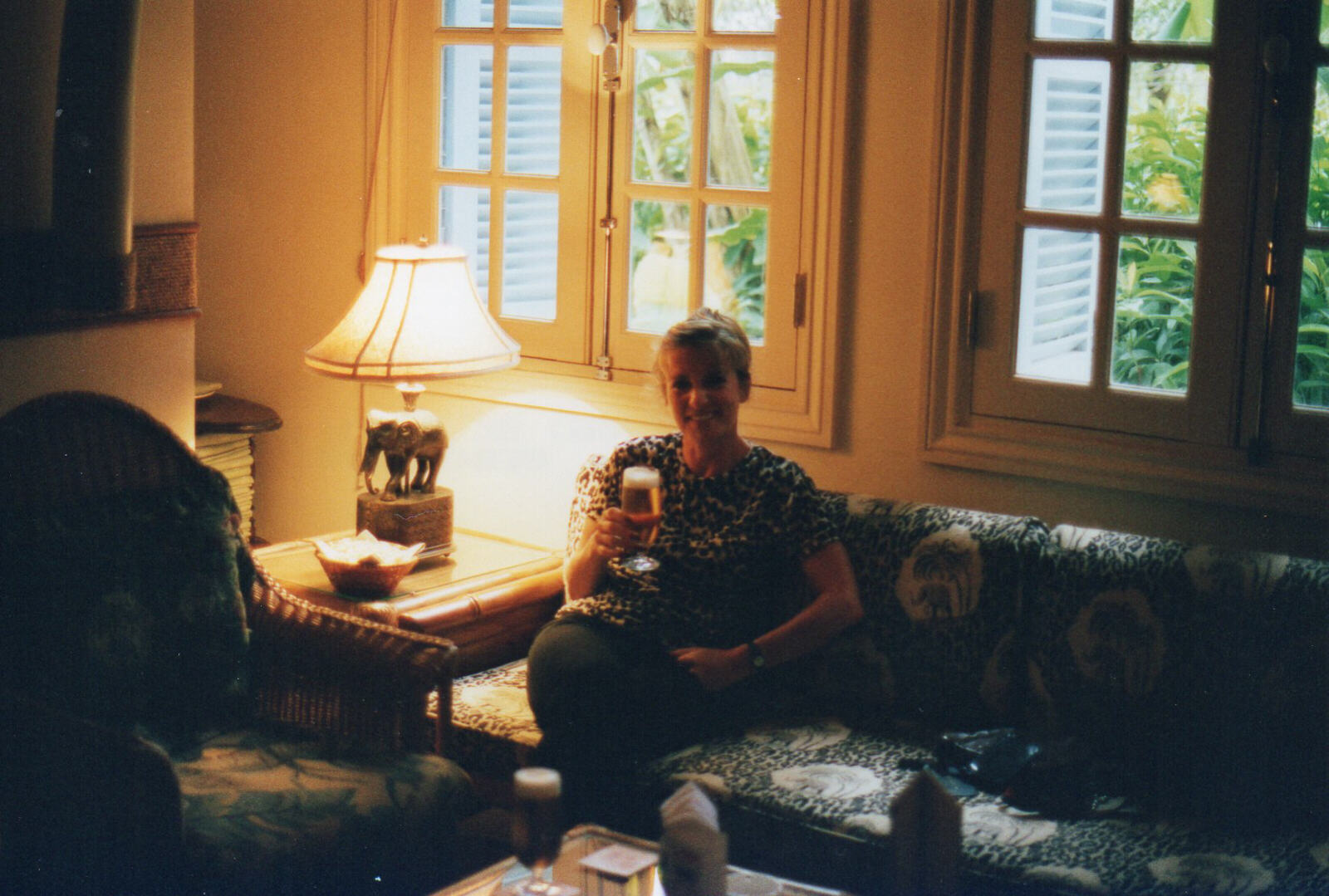
|
We walked across the bridge to the Bayon restaurant which gets a good writeup in Lonely Planet and deservedly so. We sat out in the creeper-covered open courtyard under the stars and had the tastiest meal so far. For just $9 altogether I had the chicken curry in coconut milk while Sheila picked the real winner - BBQ beef with garlic and vegetables which you cook yourself on a sort of charcoal brazier arrangement on the table. It was absolutely delicious. We walked back and outside the Grand Hotel there was a Cambodian dance show and we stood with the crowd outside the roped-off area and watched for free while the people inside enjoyed their $22 buffet dinner. We went back to the hotel and discovered what the disadvantage was - the disco across the road was belting it out and the whole building was throbbing to the beat.
Sat 20th. Sheila couldn't stand the noise (showing her age) so in the morning we set out to find another hotel. First, though, we went to a travel agent, Sara tours, and booked the truck to Bangkok. The road is so bad that ordinary cars and buses can't make it so you have to travel on a pickup truck as far as the Thai border then get a minibus for the last part. The whole journey is supposed to take 12 hours but that's assuming nothing breaks down or goes wrong. There are four places in the cab with the driver and seven in the pickup at the back with the luggage so we took the deluxe in-the-cab option for $20 each. We later found other places where it was advertised for considerably less ($10 in the cab) but apparently these trucks stop to cram in more people along the way whereas Sara tours assured us that ours won't. We shall see!
[Note: We returned from Bangkok to Angkor in 2017 and everything had changed out of all recognition. We travelled in a deluxe coach, the road from Bangkok was a smooth dual carriageway and the Angkor ticket 'hut' had become a huge visitor centre. So this travelogue is a snapshot at a moment in time.]
We then went to Smiley's Guest House which had been recommended and it had a nice relaxed travellers' feel to it. Most of all, it was quiet! We had breakfast there and booked a pleasant room with bathroom that was $6 with fan or $12 if you used the a/c (electricity is very expensive in Cambodia, he said!). We went back to the Chamreas and met the moto drivers who we had arranged with 'John' would take us on the Angkor tour for $5 a day each, and broke it to them that their first task was not to take us to the temples but to move us and all our luggage to another hotel. We checked out and loaded everything onto two motorbikes and set off unsteadily down the road. Just before we got to Smiley's Sheila's driver switched on the sales chat and persuaded her to have a look at his friend's hotel, the Neak Angkor Villa, first. This was another new building like the Chamreas, bright and shiny with tiled floors but a bit cobwebby if you look into the cupboards. Nevertheless Sheila preferred it at $10 (or $15 if you use the a/c) and we checked in. So, our third hotel and it's only 9am! Sheila went and broke the hard news to Smiley's and they weren't very smiley about it, but at last we were on our way to Angkor Wat.
Halfway from town to the temples you buy your pass - $20 for one day or $40 for three, which we did. You can then go into any of the temples as many times as you like, so if we want to go back and do it all again we can. The guards here and at the temples were all so friendly and courteous and explained the best itinerary to us.
Angkor Wat is only one of a magnificent collection of thousand-year old temples spread over a huge area. There is no point in me trying to describe them, I can't do them justice and there are plenty of guide books that do that. They are magnificent and we were very impressed. We spent the morning at the Angkor Thom complex, which includes the Bayon temple with all the huge enigmatic smiling stone faces .... |
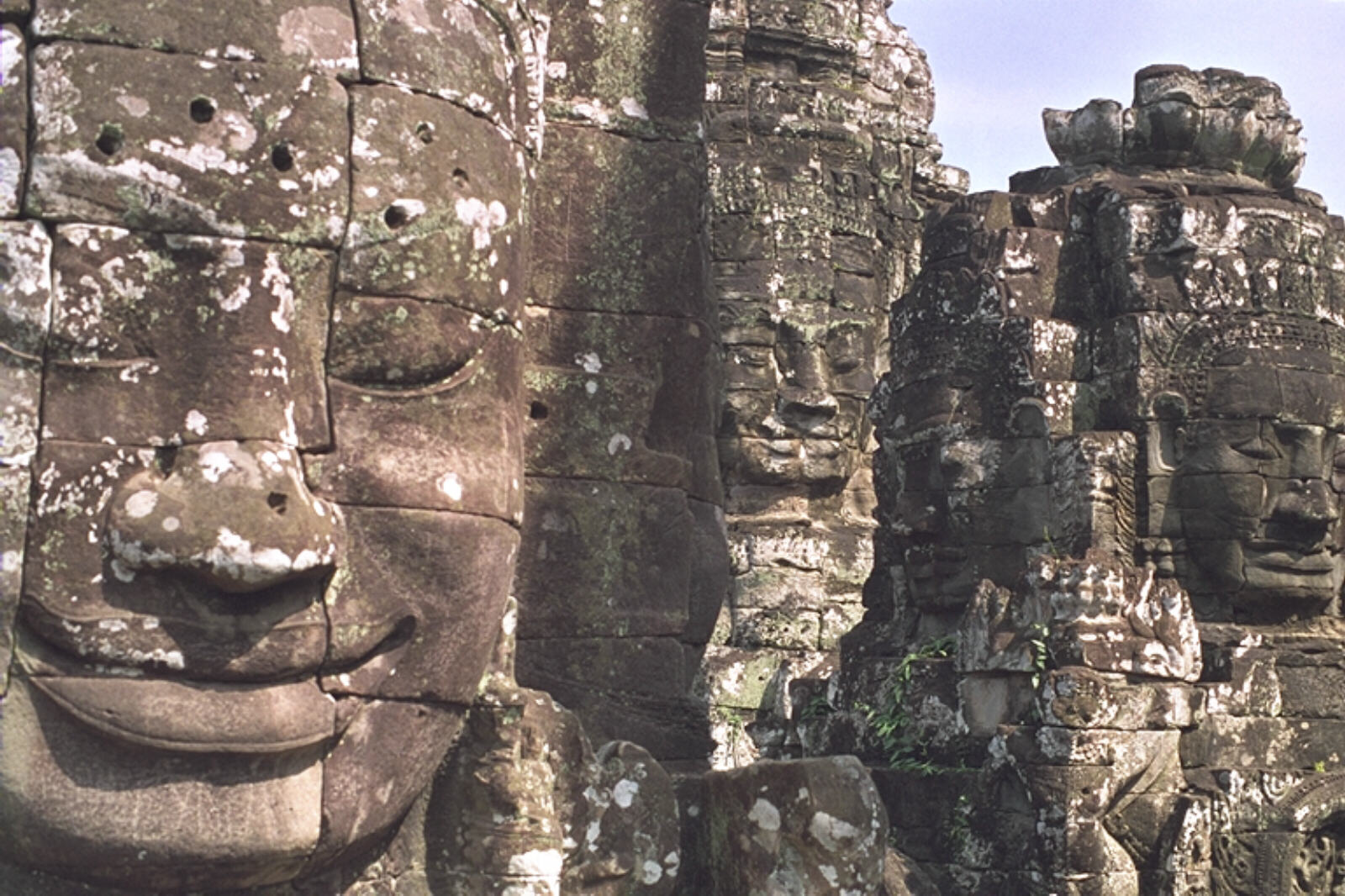
|
.... and the afternoon at Angkor Wat itself. |
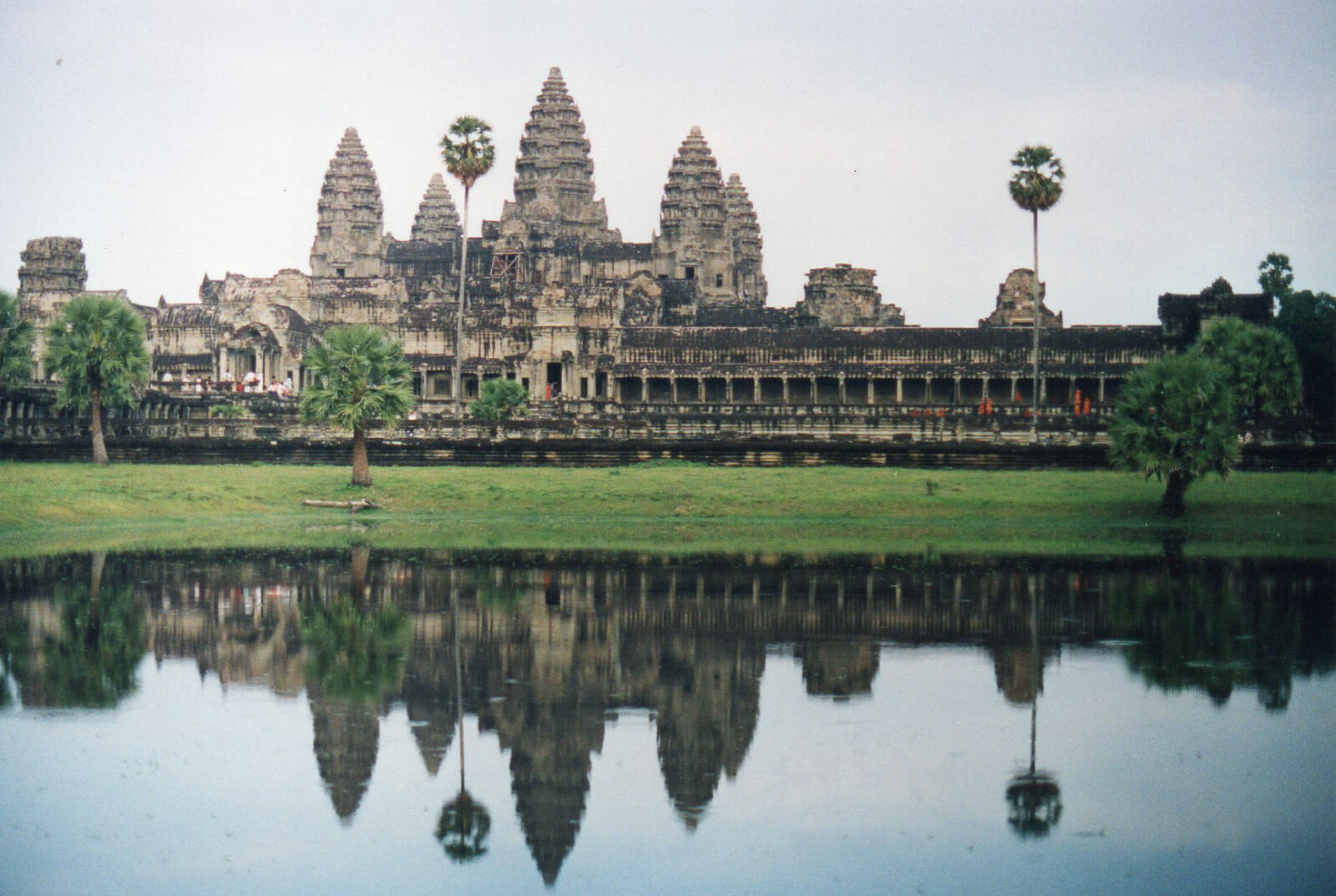
|
At one of the temples, the Baphon, as we were going into the entrance, three Geordies walked up, took a photo and said 'done that one, on to the next'! They were doing the whole of Angkor in one day before they flew back to Phnom Penh, so fair enough! At Angkor Wat a German film crew was trying to film some sequences involving monks in saffron robes walking down steps while a young monk ran across the grass outside or jumped down from a terrace, all the time getting more frustrated with tourists (like us) who kept wandering across their shots. They spent all afternoon filming about 30 seconds of action. |
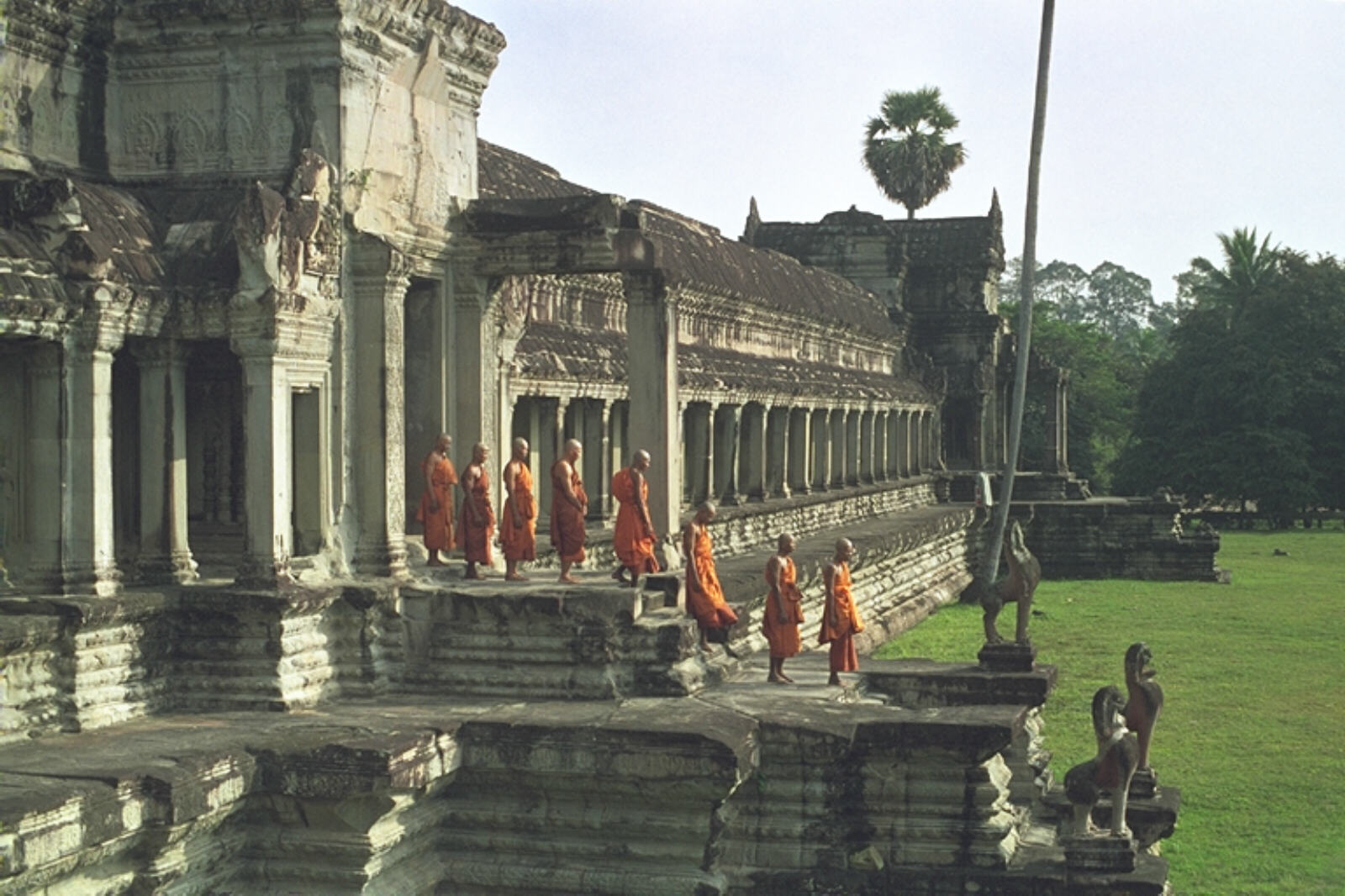
|
The steps up to the top terrace of Angkor are incredibly steep and we crawled up them holding on with hands, knees and feet, then spent all our time at the top worrying about how we would get down again until, on our last circuit we discovered that one of the staircases had been fitted with a handrail! It was still like coming down a ladder with tiny treads but we made it. We were just walking round the lower galleries of Angkor when we met the people who had been in the captain's cabin on the boat from Phnom Penh and who had shared their food with us. It seemed very odd to be bumping into people we knew. We returned to the hotel at dusk, hot and dusty but thrilled with the sights we'd seen. After a shower we went by moto to the Grand Hotel d'Angkor and had our happy hour beers and popcorn again. Then we walked over to the Bayon restaurant again and both had the hot plates - one beef and one pork. It was just as delicious as yesterday.
Sun 21st. Thankfully we did have a good quiet night's sleep at this hotel so we may even stay here for the duration. At 7am we went round the corner to the Chhouk Rath restaurant and had a very good 'American breakfast' then met our drivers for another day's sightseeing by motorbike. We did the big and little circuits, temples of all shapes and sizes, restored and ruinous, all impressive in their individual ways. The morning circuit took us through the central square of Angkor Thom past the Terrace of Elephants and through the great city gateways with their huge enigmatic carved faces .... |
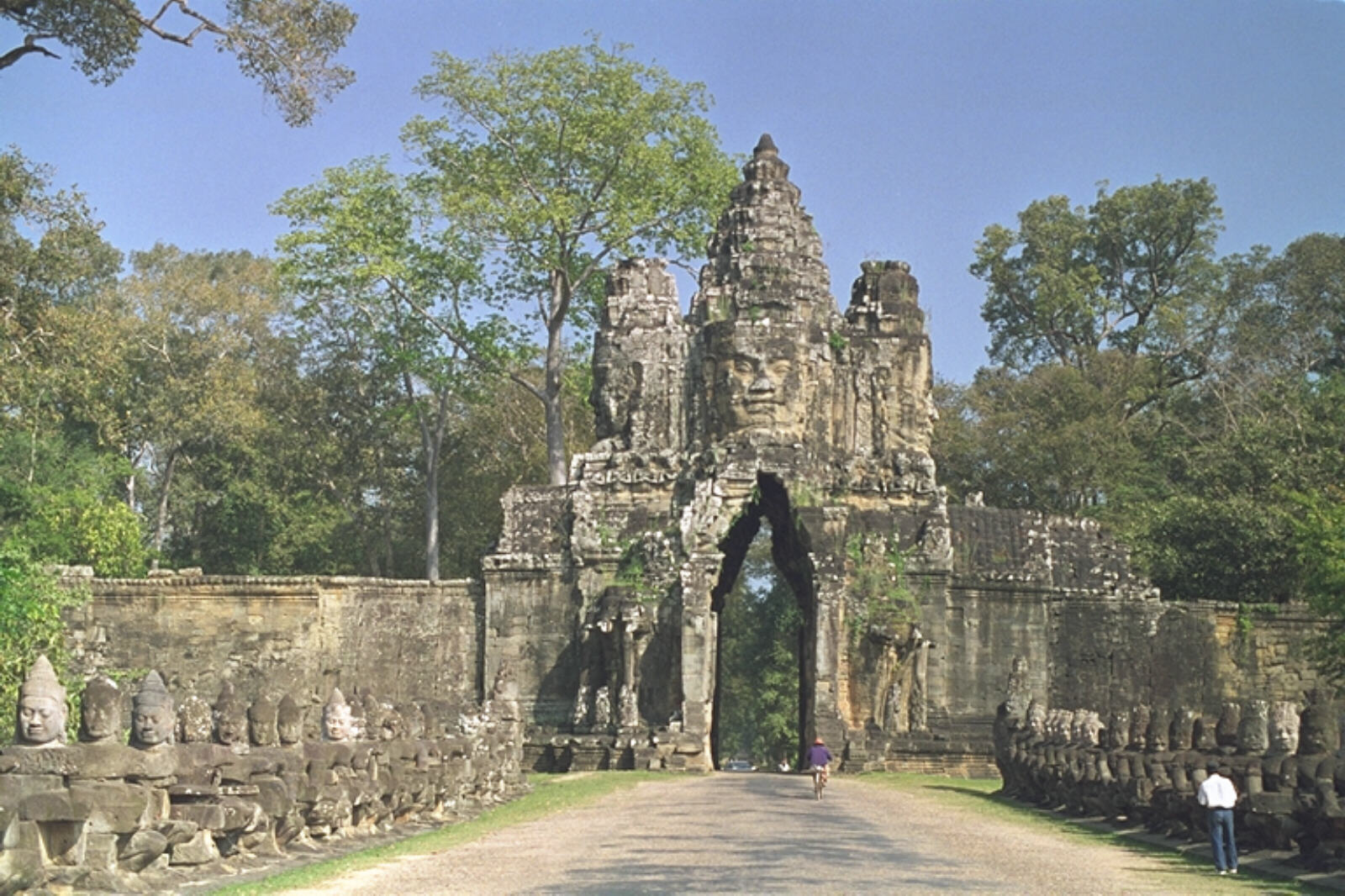
|
.... and past the Guardians of the Causeway ....
|
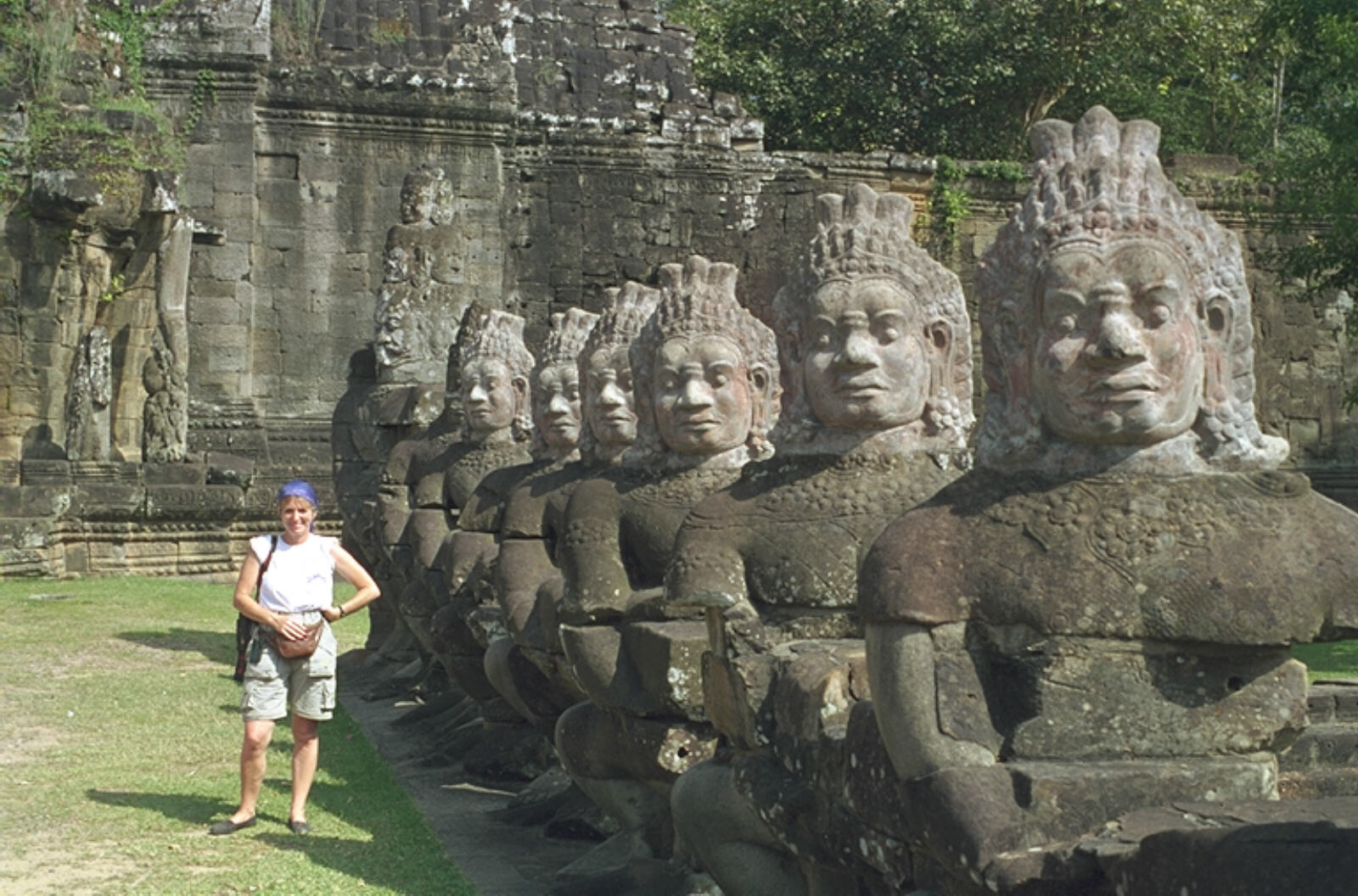
|
.... to Preah Khan temple with great trees growing out of the roof, then Preah Neak Pean where the police guards tried to sell us their ID badges as souvenirs! We continued with Ta Som, the Eastern Mebon and Pre Rup. At the entrance to each temple we were besieged by cold drinks and souvenir sellers and we gave in at lunchtime and had bottles of water and boiled eggs with salt and pepper. The afternoon circuit took us to Banteay Kdei, Sras Srang, Ta Prohm which still has jungle growing on it, Ta Keo and Thommanon temples.
|
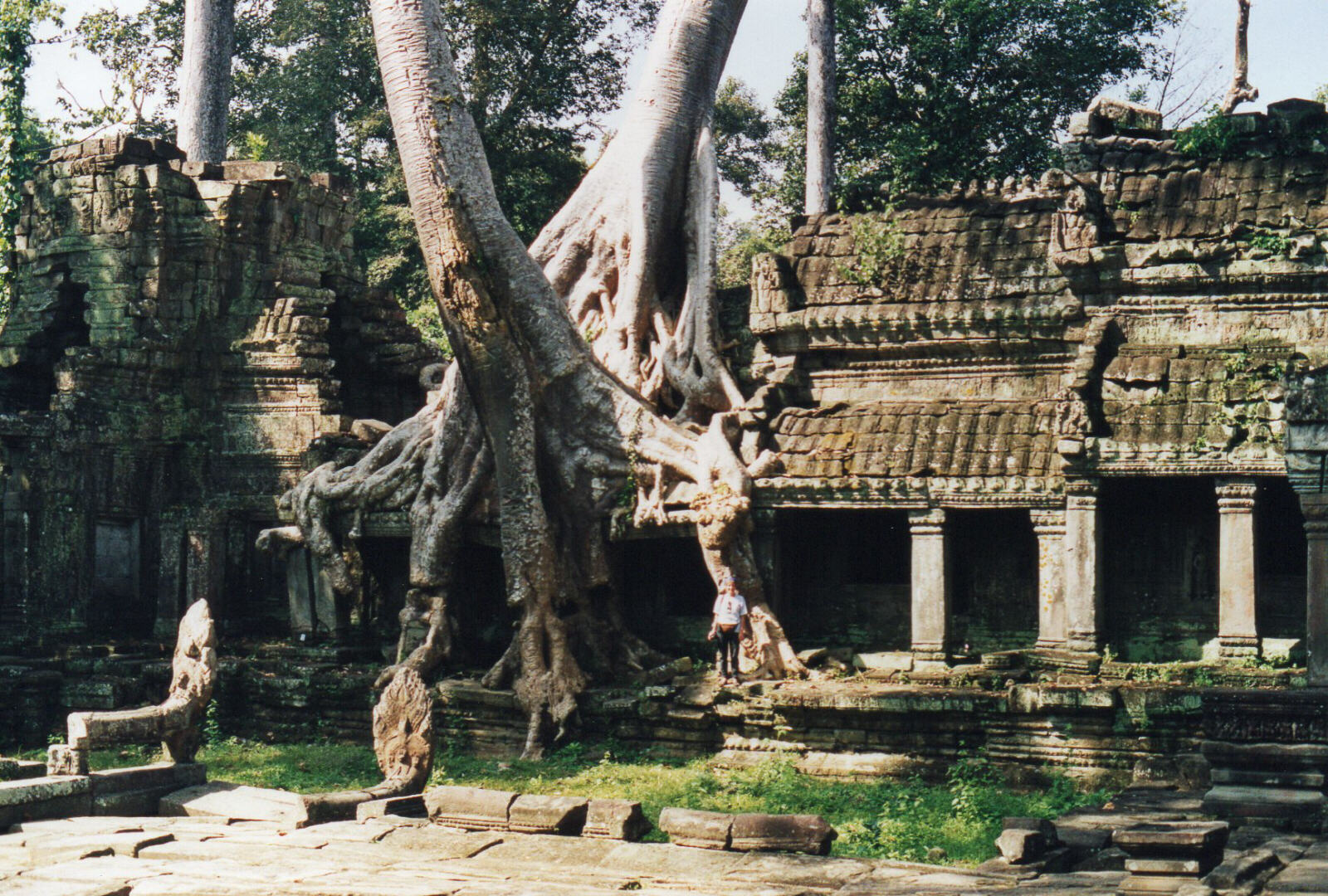
|
We ended up by climbing Phnom Bakheng, the hill a mile away from Angkor Wat, from which there are magnificent sunset views. We could have ridden up on an elephant for $15 each but elected to do it the hard way. Now, in the dry season, it is too hazy for a spectacular view so we returned to the hotel dusty, happy and saturated with temples. Because it is a festival weekend there are lots of Cambodian families having days out at the temples and all the people we met along the way were so friendly and smiley, even the guards at the check points and even the souvenir sellers - if you could distract the little children who came up trying to sell trinkets they would start playing games and bandying repartee with you.
Over our standard drinks and popcorn in the Elephant Bar we got talking to an Englishman who was working on a mine clearance project in a remote province of Cambodia near the Thai border. He'd come to Siem Reap for some R'n'R because all the Cambodians had stopped work for the festival. He worked for the HALO project which was the one that organised Princess Diana's land mine walkabout - she hadn't actually gone near any real minefields but it was wonderful PR and the money it raised was still financing their work today. At the Bayon restaurant we had our standard beef hot plates which were still absolutely delicious but the waiter broke the news that the restaurant will be closed tomorrow because it's a religious holiday so we won't be able to make it a full house of eating the same meal in the same restaurant every single night we are here.
Mon 22nd. Today we set out to see the outlying temples, Banteay Srei (below) in the morning and the Rolous group in the afternoon. Each of these is about 20km from Siem Reap and this involved a long bumpy, dusty ride down rough dirt roads on the motos. It's a public holiday today and Banteay Srei was absolutely packed with local families having a day out, there was a real carnival atmosphere. There was a little band endlessly playing the same oriental tune and the causeway to the temple was lined with old ladies begging. Sheila was dishing out two-pence banknotes left, right and centre until she got old crone overload and had to stop. By contrast the Rolous temples were practically deserted and we wandered round accompanied by only the most persistent of the postcard-seller children. Each of the temples is interesting and they all have different features but by 3pm we'd seen the lot, we were all templed out and we were coated in orange road dust so we called it quits and retired to the hotel to clean up. |
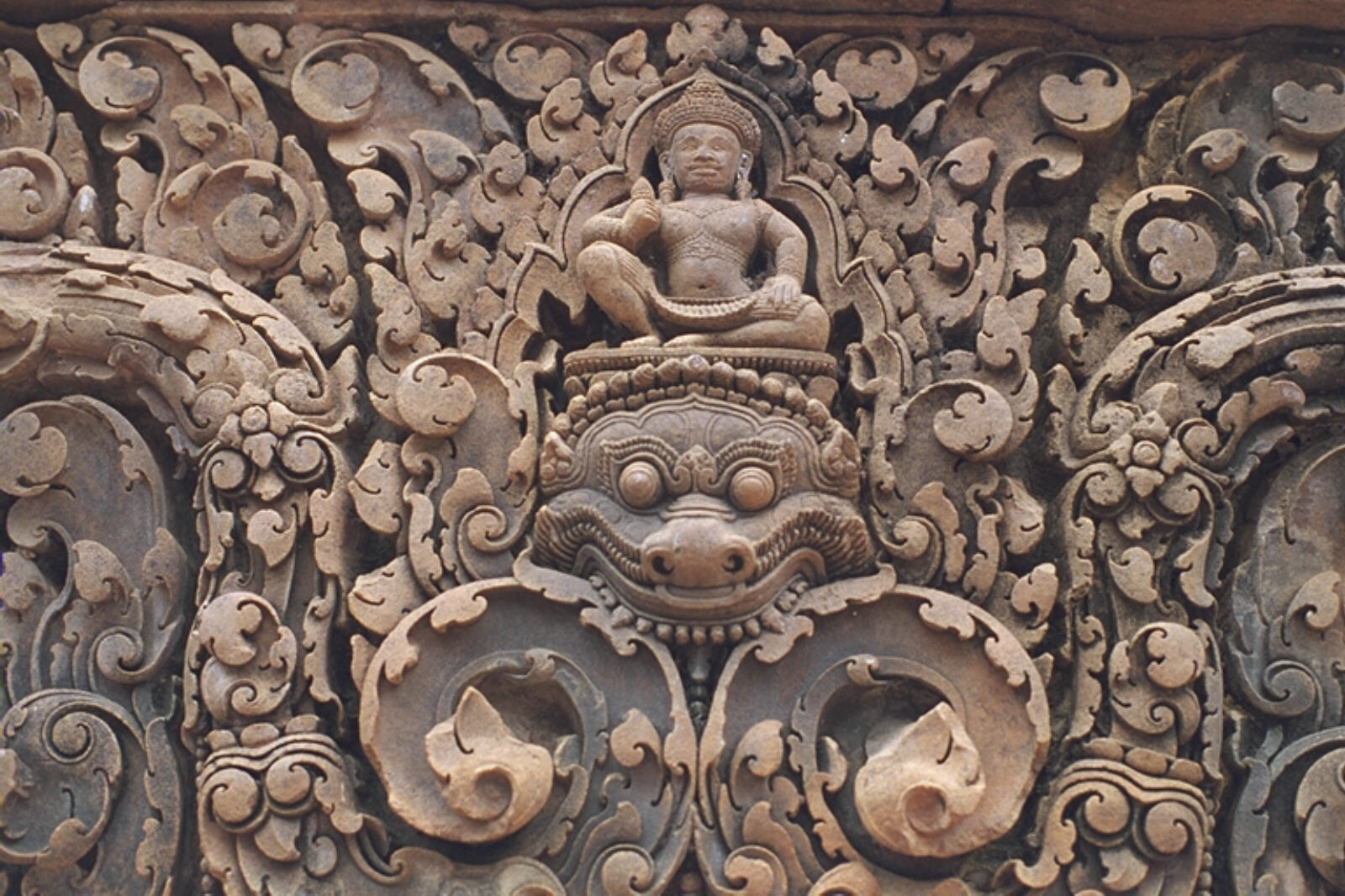
|
We set out to check out some other restaurants because our favourite, the Bayon, was closed but when we ended up at the Grand Hotel for our customary beers in the Elephant Bar we just had a vegetable and anchoyade dip, heaps of free popcorn, one more beer then usual and called it a meal. All that bouncing along rough roads on motorbikes has tired us out and we went to bed really early. |
The road to Bangkok
|
Tues 23rd. Today's the day we drive to Bangkok by pickup truck. We have heard horrific stories of people breaking down and getting stuck on the road all night so we're a bit apprehensive.
[We came back by this route in 2017 when the road was a smooth dual carriageway, see note above about how much things had changed.]
The Thai/Cambodian border only opened in 1998 after being closed for nearly 30 years. This is the last 'link' in the overland journey from London to Singapore which has always fascinated me. In the 1950s an Oxford and Cambridge University expedition were the first to make the journey in Land Rovers via the India-Burma route and they had to hack their way through the jungle much of the way. Burma closed up and as far as I know nobody has been that way since. The alternative 'long way round' through Russia, China, Vietnam and Cambodia has more or less always been impossible for political reasons until recently, and the opening of the Thai/Cambodia border at last made it possible. We're not likely to have the time to do the whole trip in one go, so now we can do it in bits; some years ago we travelled from Bangkok to Singapore by train (and hired a car and drove back) when it was still quite an adventurous route, although it is now on the 'great train journeys' circuit. So today, if we reach Bangkok, we will have completed another significant section of the route.
We stood outside the Neak Angkor hotel with our bags, waiting for the pickup truck at 7am as arranged but nothing materialised. A minibus went by a couple of times as if it was looking for someone and at 7:30 it came back and stopped; apparently they were collecting people in the minibus to take them to the pickup. We got to the rendezvous point with several other westerners and they started loading people and bags into the trucks - one looked newer and cleaner than the other and of course they directed us to the older one but we went with the flow and later were glad of it - several hours down the road we passed the newer truck stuck with a broken axle.
Eventually we started off, Sheila in the front with the driver, me, Brendan a New Zealander and Paula an Irish girl in the back of the cab and two others with the luggage in the pickup. Paula was very concerned about getting to the border today (it closes at 5pm) because she had a flight out of Bangkok the next day and she too had heard the horror stories of two-day journeys on this route, but the driver was in no hurry - a couple of hundred yards down the road he stopped and waited while he tried to fill the back of the truck with locals. Eventually we got restive and he set off, stopped again, set off again and at last we were on our way at about 8:30. Although he filled the back of the pickup with extra passengers the driver made no attempt to put more people in the cab so maybe our $20 ticket was worthwhile.
Once we got outside Siem Reap the road was terrible. I don't know how to describe it. There weren't potholes, there were craters, in fact we speculated that much of the damage could have been made by landmines exploding. The surface was just dirt - imagine a rutted farm track, churned up by countless tractors, with great muddy pools of indeterminate depth often blocking the width of the road. At each of the most difficult points a lorry had become irrecoverably stuck and a queue of traffic was having to churn into the rice paddies at the side of the road through a pool of water. There were groups of local people at each of these points who were directing the trucks through the least deep part of the swamp, throwing a few rocks in to try and stabilise the surface and helping to push you out if you got stuck, for a few hundred riels (a few pennies) per vehicle. Although we had a few anxious moments our driver gunned it through the treacherous patches and we hardly got stuck at all. Later when we talked to passengers from one of the other trucks they said they had bogged down in one of the deepest pools and water had come into the truck and drenched their backpacks. When their truck got going again the driver removed some sort of plug and all the water drained out! |
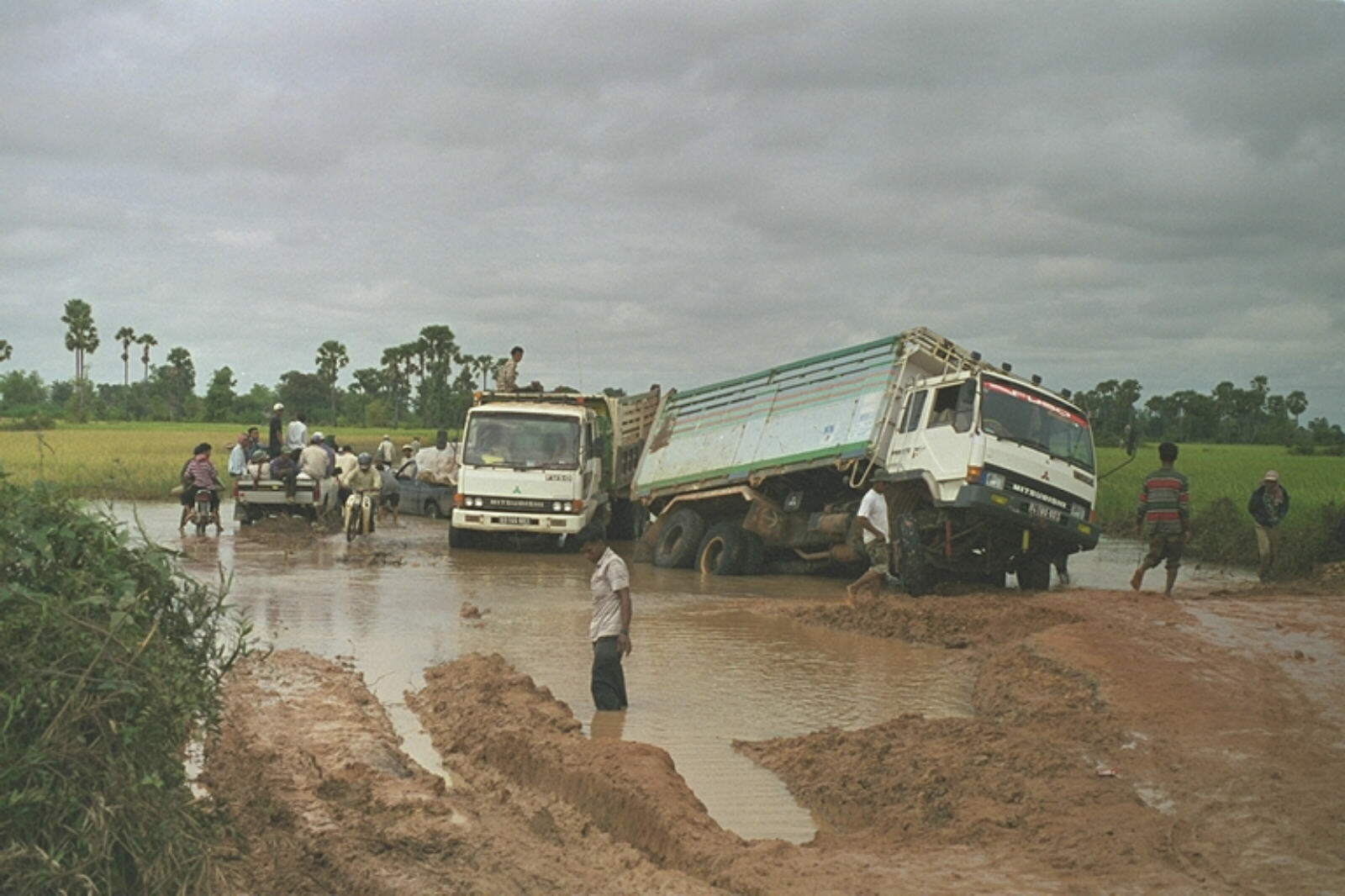
|
At midday we stopped briefly at a roadside food stall for lunch, curried meat and beans with rice for 500 riels or 5 baht (ten pence) - suddenly they are quoting prices in Thai baht rather than dollars (anything but their own Cambodian riels, apparently). The road improved slightly up to the town of Sisophon, two thirds of the way to the border. Here we unexpectedly switched to another pickup and driver and we had to hang around again while he too tried to pick up more local passengers to cram in the back. This was clearly the disco truck from hell that we had been warned about because as soon as we got going he turned on the music at ear-shattering volume. Sheila, in the passenger seat beside him, immediately turned it down and they had a light-hearted battle of wills all the way down the road, turning the volume up and down every few minutes. Of course Sheila won. The road deteriorated again - there were signs of a former tarmac surface but it was pitted with craters ranging from normal pothole size to full artillery shell.
We arrived at the border at 3:30 with a feeling of great relief and anticipation - we really could make it to Bangkok today. Brendan and one of the guys in the back had only bought tickets to the border so they got off and we went to the Sara Tours office. There a rep met us, accompanied us through the border formalities (which were ridiculously simple anyway) and showed us to the minibuses on the Thai side that would take us on from there. It was all very well organised and we felt our $20 tickets were very good value. The bridge across the grubby stream that forms the actual border was donated by Great Britain, we noticed on a plaque in the middle.
It seemed that there were three or four Sara Tours pickups doing the run that day and the others arrived soon after us except for the one with the broken axle. The first minibus set off for Bangkok about 4:30 but we were on the other one and it became clear that this was going to wait for the people on the last pickup who we gathered were racing to get there before the border closed. 5pm came and went, it started to go dark and all the vendors were packing up and going home and we thought they hadn't made it when suddenly we spotted them at the Thai immigration post. They had had a terrible journey, switching pickups several times and finishing up racing to the border on the back of motorbikes, but they were relieved to get through today.
We set off about 6pm in the airconditioned minibus (this really was the disco bus from hell which we stood for an hour before we got him to turn it off) and we oohed and aahed like country bumpkins at the luxury of tarmac roads, street lights and even a two-carriageway road. It was dark so we couldn't see much and we reached the outskirts of Bangkok about 9:30. We realised just how big Bangkok has become when we finally pulled into our destination in the centre of the city at Khao San road an hour later at 10:30. But we had made it! The overland journey was complete and we were very satisfied with the trip. Unlike Saigon to Phnom Penh, which we had expected to be easy and it had caught us out by being more difficult than we thought, we had expected Siem Reap to Bangkok to be really hard but it wasn't that bad really. The road was so awful it was actually fun! |
Bangkok, Thailand
|
We caught a tuk-tuk (two-stroke motorbike taxi) to the nearby Thai hotel which had been recommended but Sheila didn't like it so we went to the driver's recommendation, the Mitr Paisarn Hotel which was a bit barrack-like but we had a big, quiet room with a/c, fridge and bathroom for 600 baht (£10) which seemed OK. We went back to Khao San road, the travellers street of Bangkok but it was not what we expected. It was more like Ibiza with disco music blaring out and most of the westerners looked more like posers than travellers. There was nothing like the same friendly 'all-in-this-together' feel of De Tham road in Saigon. We picked a restaurant at random and had Thai-style spicy fish salad and spicy fried rice with chicken and they were really spicy!
Wed 24th. Bangkok was a huge disappointment this time. We have been here so many times before but it has changed so much. It is even bigger and more sprawling now and very Americanised, with endless shopping malls, McDonalds and Dunkin Donuts. Most of the street stalls selling exotic foods, fake branded clothes and pirated music tapes seem to have gone and there are far less of the tuk-tuk taxis left. Now it's just a featureless western city with gleaming glass buildings and streets at a standstill with traffic jams. There's not much oriental about it any more. There seems to be less pollution though, so maybe they've tightened up on emission controls too. There is a new elevated metro, the sky train, but although we saw trains running up and down it doesn't open to passengers until next month on the King's birthday. We spent most of the day fiddling about going to the airline office to mess about with our tickets, cashing travellers cheques and changing hotels. Sheila decided she didn't like the Mitr Paisarn after all and instead found the newly-opened Royal Benja hotel where we had a very luxurious room on the 25th floor with views all over high-rise Bangkok. |
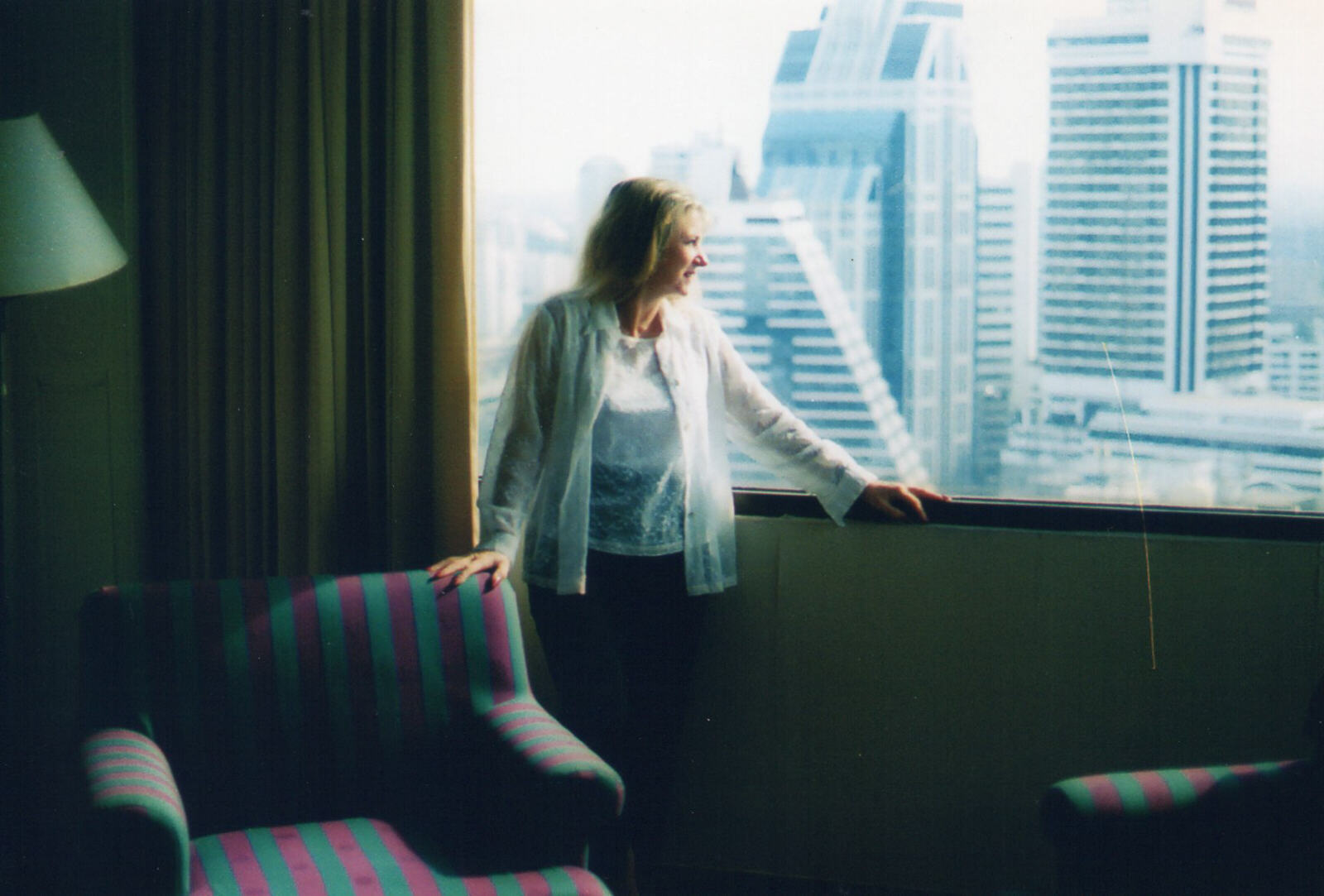
|
At the tea shop they were doing a Christmas promotion (!) of half-price on an assortment of gateaux so when we had finished our administrative arrangements we sat and had tea and gooey cakes. The Royal Benja is in Sukhumvit Road district near the Rajah hotel where we stayed when we first came here nearly twenty years ago. It is an area with lots of restaurants and bars and more going on than in the Kaoh San road area. That evening we had a stroll around, a beer in one of the many beer gardens and a nice meal in a German restaurant nearby.
Thurs 25th. Breakfast at the Royal Benja, which was included in the room price, was a big buffet featuring fruit, continental meats, Thai dishes and salads as well as the normal western eggs and bacon etc., and a chef cooking up omelettes and scrambled eggs to order, and we ate enough to keep us going until tomorrow!
We went by tuk-tuk to the Grand Palace in the centre of Bangkok but when we got there we found you're not allowed in wearing shorts so we switched to plan B which was to walk up to the Mitr Paisarn hotel and collected the laundry we'd left, including my jeans to wear on the return visit to the Grand Palace. We wandered round the Temple of the Emerald Buddha which is part of the complex and which was heaving with tourists but it was still as incredibly spectacular as we remembered it. In particular we lingered over the model of Angkor Wat which was presented to the temple by King Mongkut in the 1800s. Having been to the real thing recently it was particularly fascinating to us - the first time we saw it in 1980, a year after the Vietnamese deposed Pol Pot, a visit was completely inconceivable. We went into the palace complex itself and there seemed to be more buildings and ornamental gardens open to the public than on our previous visits and we were able to go into several of the throne rooms and audience halls. |
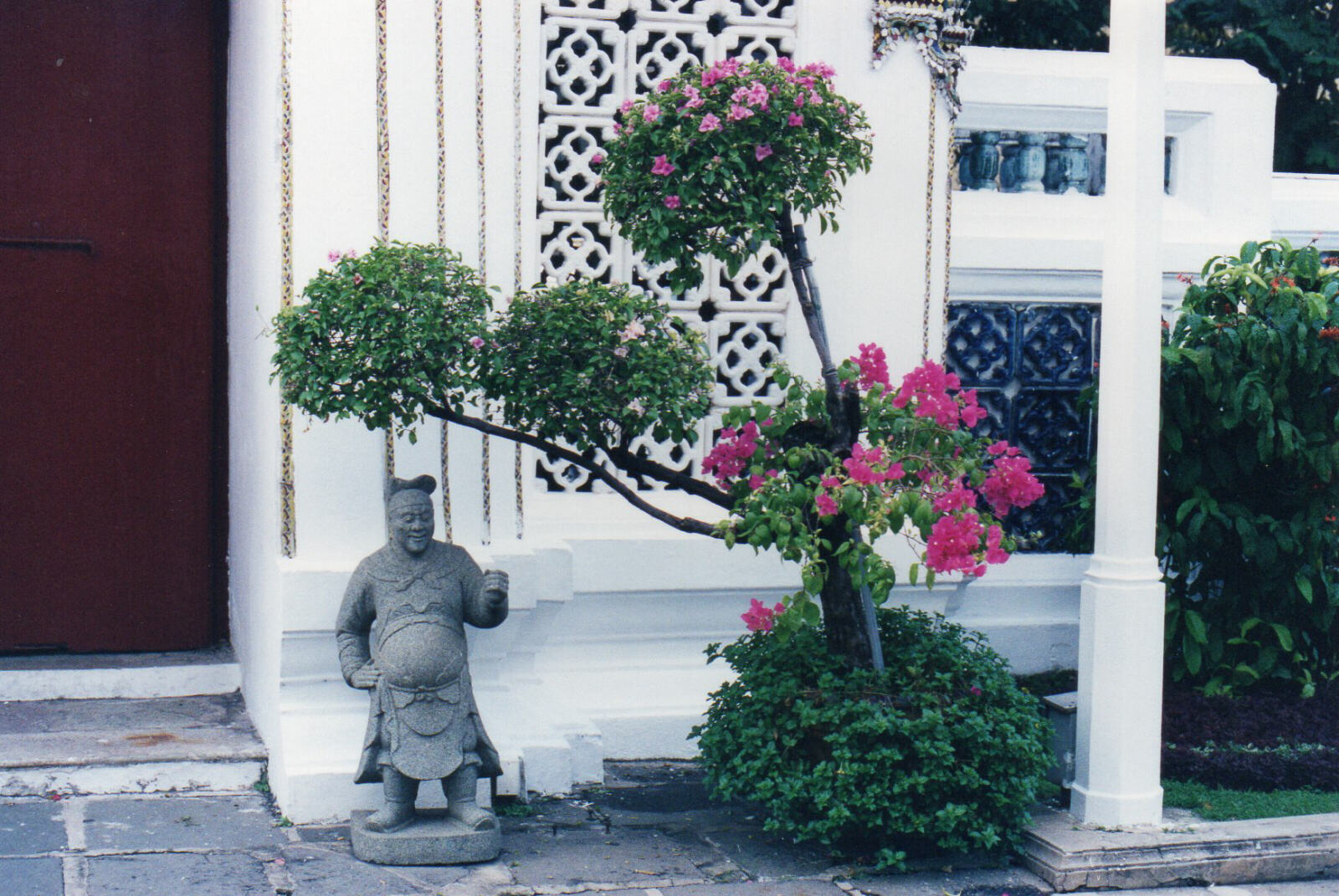
|
When we left the palace and approached a tuk-tuk driver to take us back to the hotel he said it just wasn't worth it - because it's rush hour it would take ages and we'd be better off getting a number 8 bus (because there are bus lanes that taxis can't use). This was a refreshingly frank response from a tuk-tuk driver so we took his advice, managing to pronounce the street name of our destination well enough so that the conductor understood straight away (or maybe she was used to tourists heading this way).
In the end we jumped off the bus a couple of stops early at the Central department store and Sheila had a look round while I had a coffee at Starbucks (that certainly wasn't there last time we came). We walked back to the hotel, buying a frankfurter on a stick from a street stall for a very late lunch. Before dinner we went to Riley's pub near the corner of Sukhumvit and Nana roads and I had a wonderful pint of Kilkenny beer at the rather more than wonderful cost of 280 baht (£4.60) while Sheila's Carlsberg draft was 60 baht (£1). Over drinks we reviewed all the different modes of transport we've used this holiday and came up with 17 of them: plane, big express boat, wooden boat, car ferry, normal train, sleeper train, public bus, sleeper bus, minibus, pickup truck, motorbike, cyclo, trailer cyclo, pushbike, taxi/car, tuk-tuk and walking, but unfortunately not an elephant ride! We went two doors down to the Mehmaan restaurant and had yet another really excellent Indian meal.
Fri 26th. We had a truly multicultural buffet breakfast starting with a plate of salami, cheese and salad, then chicken and cashew nut with egg fried rice followed by poached eggs, frankfurters and bacon. Sheila had corn flakes, poached eggs on toast with bacon and frankfurter then pancakes oozing with honey and lemon juice. Surprisingly, neither of us could manage to finish off with any toast and jam! After sweltering in the sun for a while and a dip in the hotel pool, we went sightseeing at the Vimanmek Mansion museum, next to the National Assembly building. This is a collection of former royal palaces and residences that have been reassembled in a pleasant garden setting. The centrepiece is the Vimanmek mansion which is a huge golden-teakwood villa with highly polished wooden floors, furnished and decorated with royal memorabilia. There are Thai dancing shows at intervals on a stage beside a lake with fountains. |
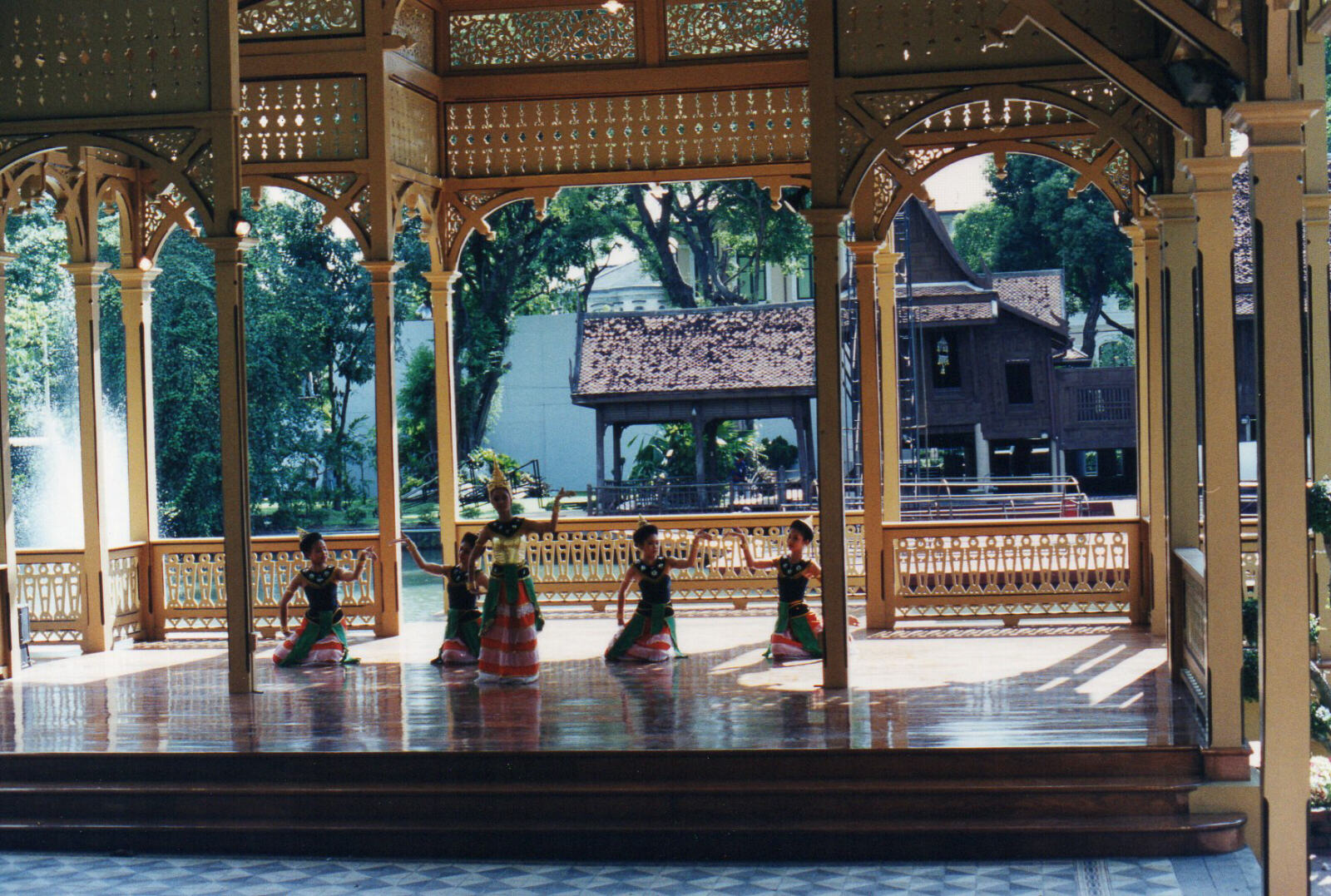
|
The buildings are so spread out that if you don't feel like walking you can hire a cyclo to pedal you around. When it closed at 4pm we went out to get a taxi but had considerable difficulty - nobody seemed to want to take us because it was rush hour and the traffic was at a standstill. Eventually we got a tuk-tuk and had to direct him to the hotel because he clearly wasn't familiar with the area. In the evening we virtually repeated yesterday's routine - a drink at the Irish pub and a curry at the Mehmaan. Boring, I know, but it was still very good.
Sat 27th. Another four-course breakfast with salami and cheese, cocoa crunch cereal, egg, bacon and sausage and chicken with ginger and fried rice. We just wandered around the local shops, had a Häagen-Dazs ice cream and sweltered by the pool again, then we packed, went for yet another wonderful Indian meal at the Mehmaan (which really is the best Indian restaurant we've been to) and headed for the airport for the flight home.
Sun 28th. The eating was not over yet, though. We had to change planes in Dubai and had a ten-hour wait. We managed to wangle our way into the first class lounge and we ate and drank almost continuously until our plane left. We have eaten more this time than on our last two holidays put together! |
If you would like to see more of our travels just click the map.

|